GROWTH WITH A PURPOSE


THOUGHT LEADERSHIP FOR 25 YEARS
Clean Juice’s
Meet QSR’s Digital Disruptors P. 26 The Future of Virtual Brands P. 11 PLUS:
Inside
rapid ascension—and what comes next. /P.20
Clean
Tim Tebow (left) found common ground with
Juice cofounders Kat and Landon Eckles on day one. And it started with making a difference.


*Technomic, Ghirardelli Brand Equity Study, 2020 ©2021 Ghirardelli Chocolate Company Crafted with dutched cocoa and real milk powder, our Premium Hot Cocoa Mixes easily combine with water, milk, coffee or espresso so you can offer delightful seasonal mochas or hot cocoas. Non-GMO with no artificial flavors, colors or preservatives, they deliver the unmatched quality of Ghirardelli— the most preferred brand to order for mocha and hot chocolate.* Order FREE samples at 800.877.9338 or professionalproducts@ghirardelli.com HAVE YOURSELF A MERRY LITTLE GROW YOUR SALES WITH GHIRARDELLI BRAND POWER
Dollars and Sense of Reviews
Engaging with online feedback shouldn’t be an afterthought. BY ADAM LEFF
59 INNOVATION
A Second Look at QR Codes
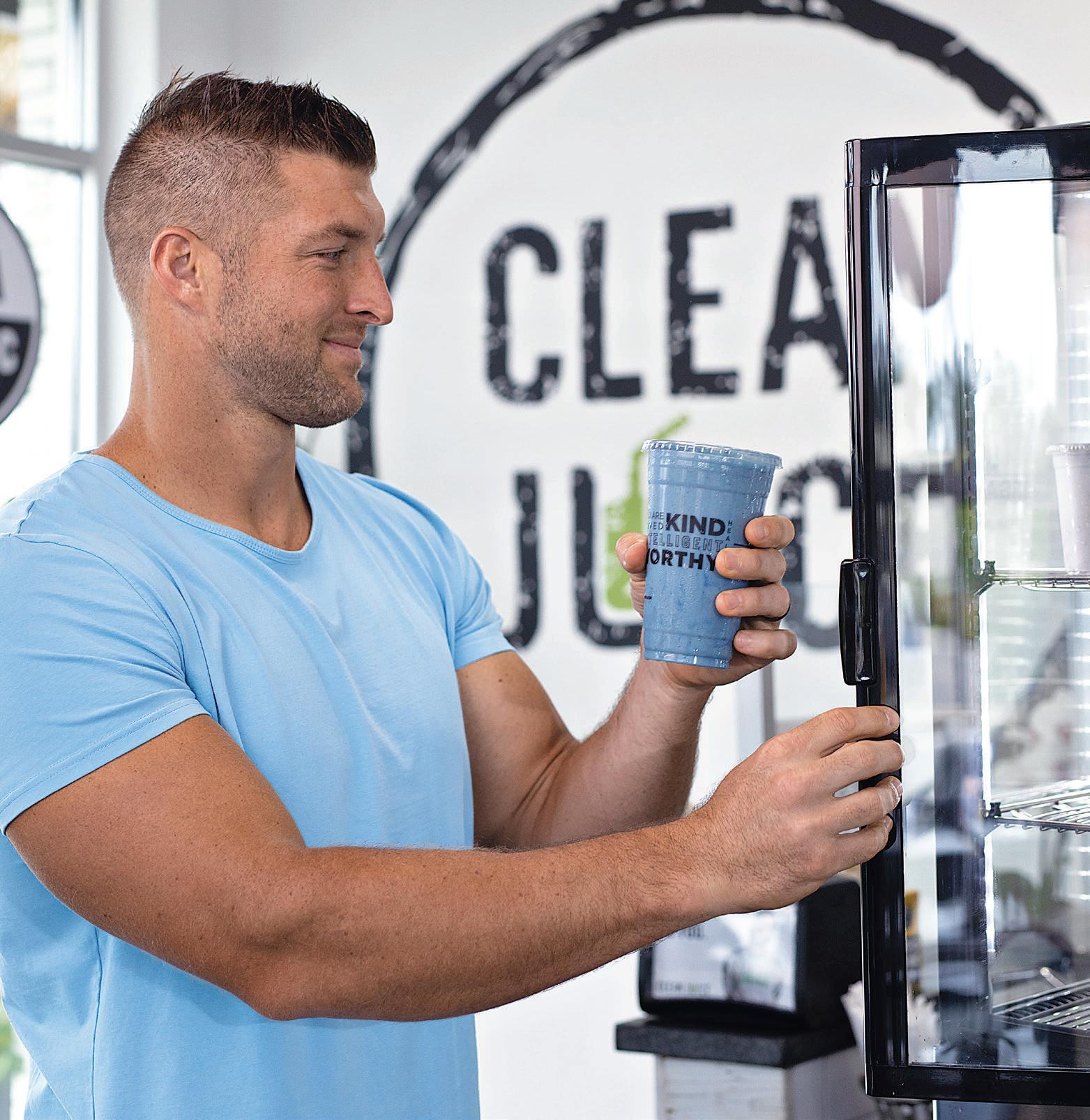
The early COVID headliner has plenty of life in a post-pandemic landscape.
BY LIZ MOSKOW
Growth With a Purpose
FRESH IDEAS
A Virtual Lock
One of COVID’s early trends has found lasting power. BY BARNEY WOLF

16
ONES TO WATCH
ROCA

The cofounder of a casual icon has a new,

2 BRANDED CONTENT 4 EDITOR’S LETTER 7 SHORT ORDER 63 ADVERTISER INDEX 20
found common ground. Now, they’re looking at plenty of opportunity ahead. 26 QSR’s
Disruptors
the blueprint for a
connected restaurant world than ever. 20 / TIM TEBOW JOINED A BRAND IN CLEAN JUICE THAT SUPPORTS HIS LIFESTYLE. O N T H E C O V E R Tim
isn’t
ambassador
a franchisee as well. PHOTOGRAPHY:
LLC N E W S 18
BY DANNY KLEIN Clean Juice and Heisman Trophy winner Tim Tebow fi rst
Digital
BY DANNY KLEIN, BEN COLEY, AND ISABELLA SHERK For the second year, we recognize the change-makers and innovators laying
more
Tebow
just an
for Clean Juice— he’s
CLEAN JUICE
OPERATIONS
N S I G H T
I
11
di erentiated pizza brand built for scale. BY BEN COLEY 60 OUTSIDE INSIGHTS Don’t Ghost Food Safety Virtual kitchens can’t take a backseat to industry-wide best practices. BY HAL KING 64 START TO FINISH Je Chandler The CEO of HiBar Hospitality continues to focus on building a best-in-class leadership team. DEPARTMENTS QSR is a registered trademark of WTWH Media, LLC. QSR is copyright © 2022 WTWH Media, LLC. All rights reserved. The opinions of columnists are their own. Publication of their writing does not imply endorsement by WTWH Media, LLC. Subscriptions (919) 945-0704. www.qsrmagazine.com/subscribe. QSR is provided without charge upon request to individuals residing in the U.S. meeting subscription criteria as set forth by the publisher. AAM member. All rights reserved. No part of this magazine may be reproduced in any fashion without the express written consent of WTWH Media, LLC. QSR (ISSN 1093-7994) is published monthly by WTWH Media, LLC, 1111 Superior Avenue Suite 2600, Cleveland, OH 44114. Periodicals postage paid at Cleveland, OH and at additional mailing offices. POSTMASTER: Send address changes to QSR, 101 Europa Drive, Suite 150, Chapel Hill, NC 27517-2380. FEATURES QSR / LIMITED-SERVICE, UNLIMITED POSSIBILITIES TABLE OF CONTENTS DECEMBER 2022 #298 CLEAN JUICE LLC December www.qsrmagazine.com | QSR | DECEMBER 2022 1
EDITORIAL
EDITORIAL DIRECTOR
Danny Klein dklein@wtwhmedia.com

MANAGING EDITOR

Nicole Duncan nduncan@wtwhmedia.com
SENIOR EDITOR
Ben Coley bcoley@wtwhmedia.com
SENIOR EDITOR Callie Evergreen cevergreen@wtwhmedia.com
CUSTOM MEDIA STUDIO DIRECTOR OF CUSTOM CONTENT Peggy Carouthers pcarouthers@wtwhmedia.com



ASSOCIATE EDITOR, CUSTOM CONTENT








Charlie Pogacar cpogacar@wtwhmedia.com
ASSOCIATE EDITOR, CUSTOM CONTENT Kara Phelps kphelps@wtwhmedia.com
ART & PRODUCTION
ART DIRECTOR Tory Bartelt tbartelt@wtwhmedia.com

GRAPHIC DESIGNER Erica Naftolowitz enaftolowitz@wtwhmedia.com
PRODUCTION MANAGER Mitch Avery mavery@wtwhmedia.com
SALES & BUSINESS DEVELOPMENT



GROUP PUBLISHER Greg Sanders gsanders@wtwhmedia.com
NATIONAL SALES DIRECTOR Eugene Drezner edrezner@wtwhmedia.com 919-945-0705
NATIONAL SALES MANAGER Edward Richards erichards@wtwhmedia.com 919-945-0714
NATIONAL SALES MANAGER Amber Dobsovic adobsovic@wtwhmedia.com 919-945-0712
NATIONAL SALES MANAGER John Krueger jkrueger@wtwhmedia.com 919-945-0728
SALES SUPPORT AND DIRECTORY SALES Tracy Doubts tdoubts@wtwhmedia.com 919-945-0704




FOUNDER Webb C. Howell
ADMINISTRATION
919-945-0704 / www.qsrmagazine.com/subscribe
QSR is provided without charge upon request to individuals residing in the U.S. who meet subscription criteria as set forth by the publisher.

REPRINTS


The YGS Group 800-290-5460


FAX: 717-825-2150 qsrmagazine@theygsgroup.com www.qsrmagazine.com/reprints
Sponsored content in this magazine is provided to the represented company for a fee. Such content is written to be informational and non-promotional. Comments welcomed at sponsoredcontent@qsrmagazine.com.
WTWH MEDIA LLC
RETAIL, HOSPITALITY, AND FOOD GROUP



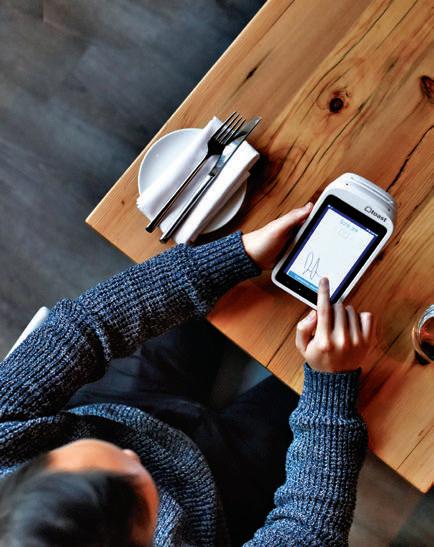

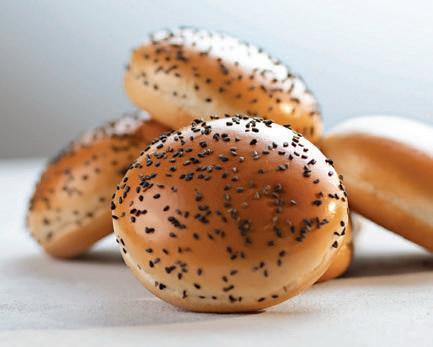
MENU TRENDS Clean-Label, Artisan, Sourdough: Digging into the Latest Bread Trends Engage customers with fresher, tastier, more natural breads. SPONSORED BY PURATOS MEDIA SOLUTIONS 3 Ways Restaurants Must Evolve Strategies for thriving— and surviving—amid the current landscape. SPONSORED BY MOOD MEDIA CULTURE Here’s How Tip Pooling Builds a Strong Brand Culture Tip pooling plays a big role—and it doesn’t have to be complicated. SPONSORED BY 7SHIFTS ONLINE SEE THESE STORIES AT QSRMAGAZINE.COM/SPONSORED IN THIS ISSUE BRAND STORIES FROM QSR BRANDED CONTENT SmartChain / p. 39 SmartChain / W O Do More with Less 40 Modern Tech 46 The Ideal POS 50 Key Players 56 Smart O C S / S Consumers and the back office need more, and point-of-sale systems are innovating. THE POS REVOLUTION ■ BY KARA PHELPS THE POS REVOLUTION / CONSUMERS AND THE BACK OFFICE NEED MORE, AND POINT-OF-SALE SYSTEMS ARE INNOVATING. 40 Doing More with Less Maximize resources with advanced POS systems. 46 The Modernized POS POS systems aren’t just for counter service anymore. 50 Powerful POS Practices What defi nes an ideal POS system? 56 Key Players Here are the biggest names in the world of POS.
14
This 56-Unit Premium Sandwich Concept Has a Unique Recipe for Growth
Mr. Pickle’s Sandwich Shop is ready to franchise nationwide.
SPONSORED BY MR. PICKLE’S SANDWICH SHOP
2 DECEMBER2022 | QSR | www.qsrmagazine.com
MR. PICKLE’S PURATOS MOOD MEDIA MOOD MEDIA

Is The Price Right?
Iwas invited in mid-October to address a room full of Bojangles franchisees at the chain’s fall conference. This was definitely a first on my end. I put a picture of my basset hound on the opening slide and told a story about how some teenagers threatened to break my legs when I was a sports writer. Thankfully, nobody did, but the experience made me rethink my career track. And, in some twisting way, that was day one of how I found my way to the stage that morning in Charlotte.
But beyond the nerves and Godfatherlike anecdotes, I wanted to share some feedback I had from operators. It was a revealing look into the state of things. My presentation covered the industry’s outlook, focusing mainly on inflation and drive-thru. Here’s what struck the loudest chord: I spent a good bit of time trying to answer how much price is too much price. Or, what’s the ceiling for brands to take? I had worked with Revenue Management Solutions in September on this topic. Its data, which analyzed in-store price increases by percentages (Q2 2021 versus Q2 2022) across 25,000 quick-service outlets, examined at what percentage price increases started to create a diminishing effect, ultimately hurting traffic and negating some/all of the additional net sales recorded in recent months. Put differently, at what inflection would price increases result in such an erosion in traffic that the upside vanished? What RMS discovered was net sales hit the highest threshold at about 13 percent. Beyond, traffic was so negatively dented that net sales turned downward. It’s a straightforward indicator. You can go up to 13 percent in price but should be wary thereafter. However, what was interesting
to me was the reaction between extremes. A franchisee asked whether I thought it made sense to sit at, say, 11–12 percent of price, in order to make sure they could pay the ( suddenly more expensive) labor needed to staff up. In RMS’ data, the traffic decline at 6–10 percent of price was negative 4.6 percent. At 11–15 percent, traffic dropped 5.3 percent (it cliffs at 15 to negative 10.2 percent traffic ) Just looking outside in, there doesn’t appear to be a ton of difference in guest kickback from 6 to early double-digit price increases—anywhere in that 11–13 percent range. My answer then: Yes. From all the data I’ve seen and operators I’ve spoken with, consumer studies, et al, it seems a better trade off to pass along price below the threshold than it does to cut hourly positions. Because one thing has felt very clear: Value doesn’t play by the old rules in this inflationary climate. It’s no longer as simple as racing to the $1 bottom. More than anything, value is defined by whether or not somebody feels the experience was worth what they paid for it. As we discussed at the conference at length, guests today are paying more, not just in food, but in everything they’re doing. Interestingly, it’s a reality that’s resulting, somewhat, in higher-income consumers trading down to fast food (14 percent noted this in Bludot’s study)

To date, the gains in price, alongside off-premises expansion, have shielded quick-serves. However, we can’t lose sight of the backbone and purpose of this segment and how far it all stretches. Know your customer and keep asking questions. We’ll find the answers together.
 Danny Klein, Editorial Director
Danny Klein, Editorial Director







ROSIE ROSENBROCK DKLEIN@WTWHMEDIA.COM QSR MAGAZINE
Inflation has created a convoluted value equation for a sector built on it.
4 DECEMBER2022 | QSR | www.qsrmagazine.com EDITOR’S LETTER










A Day for the Dogs
SHORT ORDER


SONIC-DRIVE IN GAVE ITS CUSTOMERS something to bark about in October. The chain launched a special, limited-time collection of Sonic-inspired merchandise for dogs and their two-legged companions through its online swag shop. From Cherry Limeade costumes to plush Corn Dog chew toys, the Sonic Wag Shop collection enabled customers to match their pets with their favorite menu items.
In addition, Sonic offered a surprise for dogs when they visited the drive-in. Across October, dogs could get a free Wag Cup (whipped topping) treat with any Sonic app purchase.

“Guests have been bringing furry friends along on their drive-in visits for decades,” says Kim Lewis, VP of integrated marketing for Sonic. “The new Wag Shop collection lets fans show off their love of Sonic and their pets, and trips to Sonic are even sweeter when you can reward your pups with a special Wag Cup treat.”

SONIC-DRIVE IN
Sonic’s famed swag turned its attention to pets this past spooky season.
www.qsrmagazine.com | QSR | DECEMBER 2022 7
At last, pets and owners can be united in their love of Sonic menu items.
Logic might suggest higher prices due to inflation would drive
consumers
away from already high-ticket restaurant delivery.
But is that actually the case? Deliverect, a global scale-up that simplifies digital orders for more than 27,000 locations across 40 markets, surveyed over 7,000 global consumers to identify preferences and changing habits when it comes to restaurant o erings. And what it found was guests were ordering more delivery and food for takeaway, inflation and all. What this portends is delivery guests, generally, might be more resistant to some of the external hikes than other cohorts. The reason being, they were already conditioned to fork up extra funds in the name of convenience. In the end, it’s a conditioned habit that’s proving very di cult to crack.
Here were some other findings from the survey:
57%





Consumers who are now PURCHASING UP TO THREE TAKEAWAYS IN A WEEK now, in comparison to 49 PERCENT prior to the inflation increase.

Aggregators count:






One-third (37 percent) of respondents found ORDERING FOOD FROM A RESTAURANT VIA APPS such as Deliveroo, Uber Eats, JustEat, Grubhub, Seamless, DoorDash the most reliable, followed very closely by ORDERING DIRECTLY FROM THE RESTAURANT (35 percent).

Just over one in seven (or 15 percent) said they ONLY TRUST PICKING UP TAKEAWAY DIRECTLY from a restaurant.
Don’t forget the tech:
FAST DELIVERY was likely to encourage people to order from a restaurant again (41 percent ), as was food ARRIVING AT THE PROPER TEMPERATURE (31 percent ) Thirty-two percent of customers were also likely to choose from one restaurant over another due to a quicker delivery time, and 25 percent of people noted they’d select a restaurant due to its proximity/ convenient location.
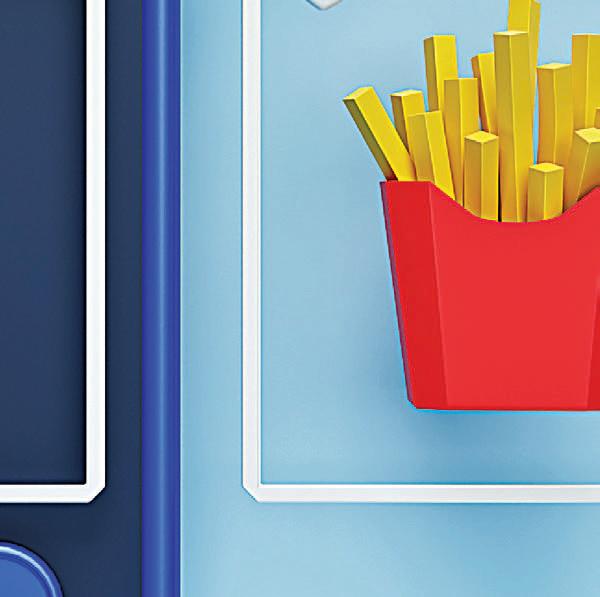
While people are putting more thought behind how they spend their money, they are more likely to CUT BACK ON OTHER ACTIVITIES such as BUYING CLOTHING (44 percent ), going out for DRINKS AND DINNER (47 percent ), and TRAVELINGMORE (43 percent )

The old ways still matter:
69 % watching their spending, as is the QUALITY OF RESTAURANT INGREDIENTS (67 percent ) Customers are also looking for SOCIAL PROOF before selecting where to eat, with nearly three in five (59 percent ) saying RESTAURANT RATINGS/ CUSTOMER REVIEWS are now more important than ever.
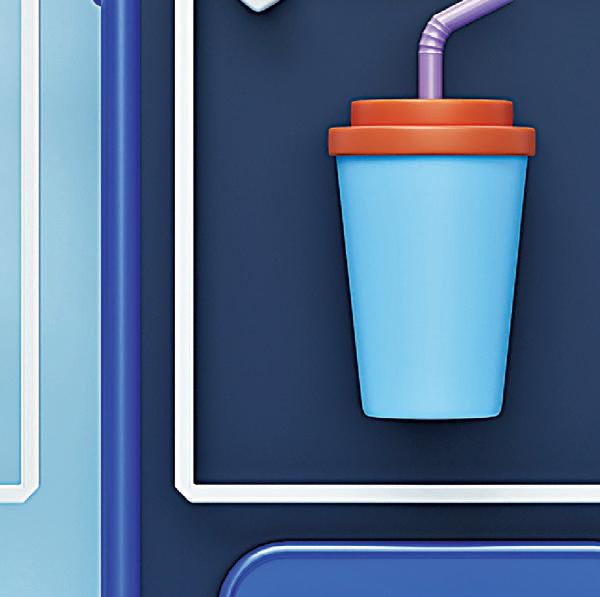
People who said the TASTE OF FOOD is more important when

38 %












The percentage of people who AGREED 21–30 MINUTES WAS THE MAXIMUM AVERAGE TIME TO WAIT for their order to arrive.



Overall, the top reason customers said they’d order from a restaurant again is because of its GOOD QUALITY of food (52 percent ). Diners are also looking for a variety of great menu choices, with people selecting a restaurant for delivery or takeaway if it has a VARIETY OF MENU OFFERINGS (27 percent )

MOBILE FOOD APPLICATION ORDER: ADOBE STOCK FOTOSPLASH, SCISSORS CUTTING MONEY ICON: ADOBE STOCK PIXELALEX, RUNNING WITH TRAY OF FAST FOOD: ADOBE STOCK / TATIANASUN, ONLINE ORDER, DRIVE THRU: ADOBE STOCK / MARIIA, MOBILE ORDER: ADOBE STOCK GRAPHIXMANIA 8 DECEMBER2022 | QSR | www.qsrmagazine.com SHORT
ORDER


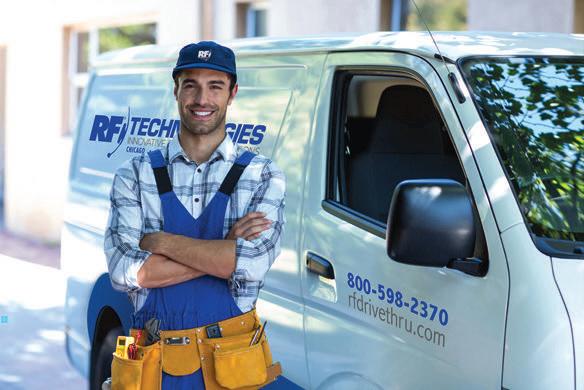








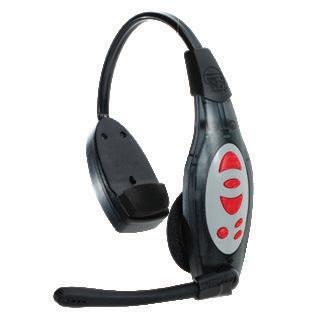














































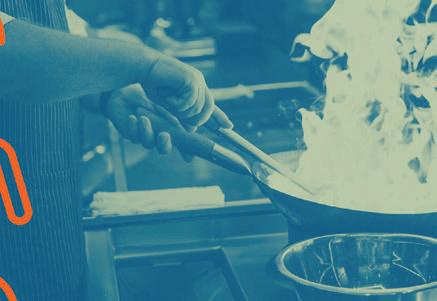


freshideas f A Virtual Lock







Although there’s something inherently transient and ethereal in the term “virtual,” the concept of virtual brands is very real and apparently here to stay.

The idea is not new, having been born out of the online orderand delivery-driven ghost kitchen trend that began in the early 2010s. However, virtual restaurants are distinct entities that allow kitchen facilities, including those at existing eateries, to set up their own, special online brands.

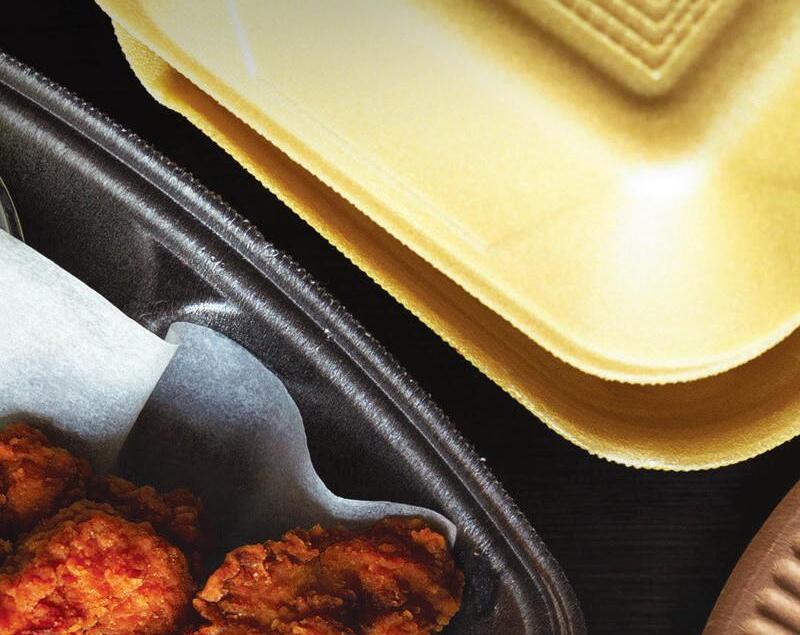
Virtual brands grabbed a foothold and gained strength during the COVID-19 pandemic due to restrictions on dining in and a resulting spare kitchen capacity. Even though many full-service restaurants logically took the plunge, so, too, did a budding number of quick-service businesses.
The result: There are hundreds of digital restaurant brands fueling a niche that potentially could grow into a $1 trillion industry



by 2030 if significant automation and heavy investments occur, according to ongoing analysis by research firm Euromonitor International.
It turns out, once again, that necessity is the mother of invention.
For limited-service restaurants entering this arena, their virtual brands are not only using existing kitchen space, equipment, and staff, but they are employing few, if any, additional ingredients or other stock keeping units (SKUs)—steps that keep costs down and boost margins.

One way to describe the operational philosophy succinctly is, “keep it simple.”

Not all online brands are built the same. Some are available only through units of the company that developed them, while others are also licensed to other operators. And some of the brands born

ADOBE STOCK ARTURSFOTO K I T C H E N S |
One of COVID’s early trends has found lasting power in multiple forms.
BY B A R N E Y WO L F
www.qsrmagazine.com | QSR | DECEMBER 2022 11
Delivery and digital ordering gave rise to the virtual brand movement. COVID’s cut on dine-in poured gas on the fire.
in the ether have been so successful they resulted in brick-and-mortar versions.
The growth in virtual restaurant brands was “definitely driven by the pandemic,” says Laura Rea Dickey, chief executive of Dickey’s Barbecue Pit, which has more than 550 fastcasual units and three virtual brands. “They are a creative way to add to the revenue stream.”
Demand for off-premises food service was growing even before COVID, and that led companies with a large in-restaurant business, like Chuck E. Cheese, to begin considering how to meet the trends, explains Sherri Landry, chief marketing officer for the brand’s parent, CEC Entertainment. The pandemic just shortened that window to develop CEC’s virtual brand, she says.
The coronavirus crisis served as a catalyst for virtual brands in the same way the Great Recession did for food trucks, notes Andrè Vener, founding partner of Dog Haus and its five virtual brands. In that sense, digital brands are “the modern version of food trucks,” he says. “You’re still out there bringing food to customers, but now it’s DoorDash, Uber, [etc.]”
Dog Haus launched its initial virtual kitchen in 2019 after the founders discovered few online customers were ordering anything from the chain’s units beyond hot dogs and burgers, even though the company also had items like hot Nashville chicken. The reason: digital delivery sites only used three or so food items or styles in their restaurant descriptors.

As a result, the company set up a virtual brand based on an existing item, Big Mutha Clucka, a sandwich it introduced in 2015. Using the Absolute Brands umbrella for its virtual concepts, four more digital brands were added afterward, using mostly existing ingredients and menu items.
The logic behind this is unassailable. “If there are 100 online restaurant listings for a city, Dog Haus was one of 100,“ Vener says. “But if we have five virtual brands, that makes it six of 100.”
Virtual sales now make up 20 percent of the company’s revenue. In some restaurants, one of the virtual brands, Bad Ass Burritos, which added only one ingredient, a 14-inch tortilla, has become so popular it resulted in earlier opening and later kitchen hours, creating additional dayparts. The virtual brands actually became the predominant items in one unit and helped keep that franchise afloat.
CEC’s virtual brand, Pasqually’s Pizza & Wings, which is named for one of the characters in the Chuck E. Cheese make-believe band, launched in spring 2020 after the pandemic shuttered
the company’s restaurants. The new brand has “a taste profile geared toward a broader audience,” Landry says.
“What we do is leverage the high quality we have at Chuck E. Cheese, including dough made fresh daily,” she says. The basic pizza ingredients are those already at the restaurants, “and it’s amazing with those ingredients what you can do differently,” Landry adds, and with more complexity and flavors.
There were also other considerations, including new packaging, especially for beverages and desserts. Additionally, the team at CEC learned it had to innovate more quickly, including offering additional, creative sauces for its chicken wings and new items like its dough-wrapped Meatball Dunkers.
Of the 465 locations in the U.S. and Canada, only two are not offering Pasqually’s. Since Chuck E. Cheese and Pasqually’s have different sales channels, there is no cannibalization, and comparable sales at the virtual brand are growing in mid- to upper-double digits, Landry notes.
Dickey’s joined the virtual movement after the company’s CEO listened in on a conference call during which another multiunit restaurant operation’s chief executive discussed the concept.
The pit-smoked barbecue enterprise had launched smoked wings a few years ago, “and we thought that would be a great opportunity for a virtual brand,” Dickey says. “So, we broke that off and did Wing Boss as a digital brand during the third quarter of 2020.”
Two more Dickey’s online brands have followed, with another in the wings. Additionally, Wing Boss opened its first brick-and mortar in 2021, and plans call for actual restaurants for each of the digital properties.

Few SKUs have been added for the virtual offerings, and the success is obvious—incremental revenue for each brand, and efficiencies in operations, and more buying power to negotiate contracts. “There have been wins on both the cost-cutting and sales side,” Dickey says.
The company is also receiving revenue for licensing the online brands, and Dickey notes that training is key to both company and licensed locations. A number of other limited-service brands are licensing their names and products to other kitchens, including entities like Wow Bao.
“[Virtual] is a huge opportunity, if you go all in,” Dickey says, “but keep it simple and keep it in your wheelhouse.” q
DOG HAUS (2)
| G H O S T K I T C H E N S |
Barney Wolf is a regular contributor to QSR and is based in Ohio.
12 DECEMBER 2022 | QSR | www.qsrmagazine.com fresh ideas
DOG HAUS HAS BEEN ONE OF THE VIRTUAL CATEGORY’S PIONEERS.


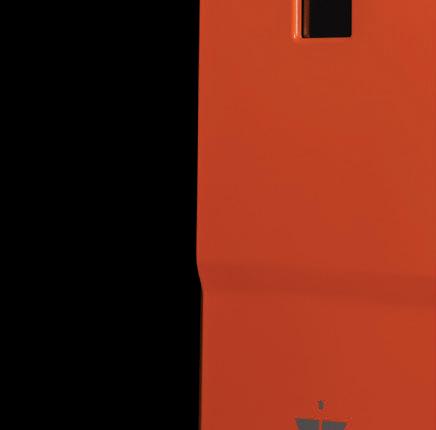


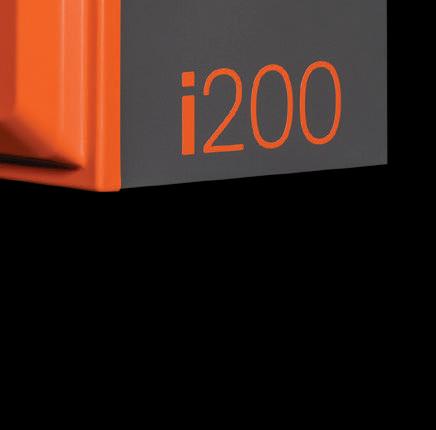

(And so compact we didn’t need a full page ad). Reliable, efficient and cost-effective tankless water heaters for the restaurant industry. Small Order, Super-Sized Savings The only tankless water heating system designed and built for commercial work Intellihot.com Only 26.2” tall
This 56-Unit Premium Sandwich Concept Has a Unique Recipe for Growth
The crowd favorite in northern California since 1995, Mr. Pickle’s Sandwich Shop is ready to franchise nationwide.
/ BY KARA PHELPS
Mr. Pickle’s Sandwich Shop, a beloved northern California brand that has grown from one to 56 locations over the course of almost 30 years, recently announced plans to expand franchise opportunities nationwide.
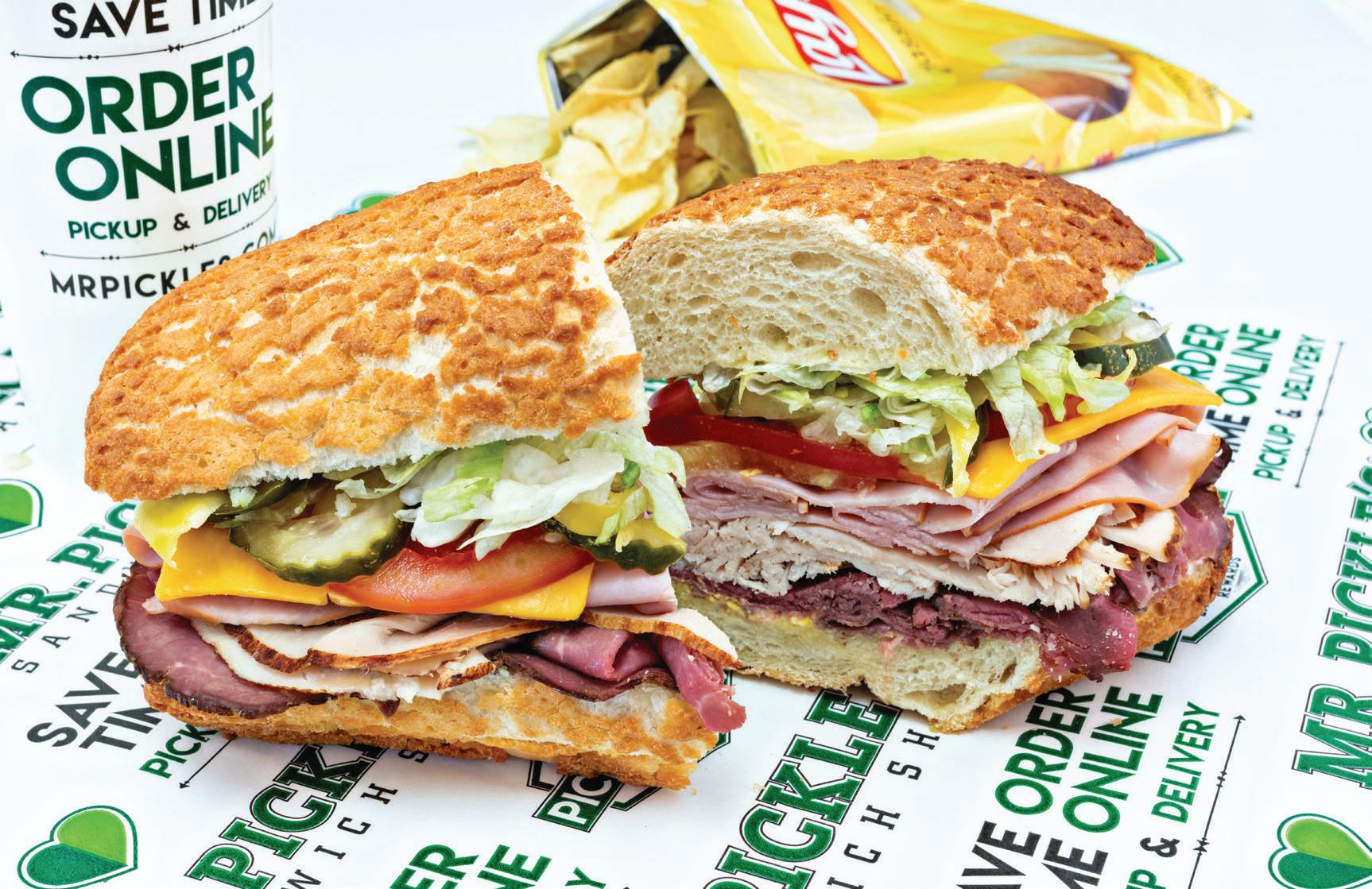
“We are bringing quality back to the sandwich segment,” says Michael Nelson, CEO of Mr. Pickle’s Sandwich Shop. “The brand is special in that it doesn’t turn to big-box vendors for its core ingredients such as its bread and bestin-class proteins—instead, we partner with artisan bakers, regional farms, and ranches to source those key products.”
Mr. Pickle’s core ingredients are unique by design. Its specialty bread isn’t bound by the sizing scrutiny seen for decades in the rest of the sandwich segment. Rather than the bland uniformity seen so often in other concepts’ breads and meats, Mr. Pickle’s prides itself on premium quality. For example, it o ers the only Santa Maria Tri-Tip on the market that’s free from liquid smoke.
The menu features a range of popular hot and cold sandwiches, notably the signature Mr. Pickle sandwich: chicken breast, bacon, Monterey Jack, avocado, and veggies. It specializes in salads and catering as well, and the brand is committed to maintaining close-knit relationships with its vendors as it grows.
Mr. Pickle’s is also a leader in online ordering technology. It’s invested in infrastructure for loyalty, order, delivery, mobile, and gift programs with a goal of getting to 50 percent online sales in the next 36 months. “We have the support to make that happen without sacrificing on quality,” Nelson says.
The Mr. Pickle’s concept is well-positioned for explosive growth. In the last few months,
it’s already garnered commitments for 25 additional locations in California and six in Arizona. It’s looking for experienced multi-unit restaurant franchisees across the country to sign on.
All franchisees receive strong and consistent support. “We stand with and behind our franchisees every step of the way,” Nelson says. “We use our long-term relationships with regional commercial brokers to assist with site selection. We also provide construction support, lease negotiation support, in-store training, mentorship, and more.”
The store design is adaptable to nontraditional construction and centers—it isn’t limited to a standard rectangular space, and very little build-out is required. Mr. Pickle’s also does not
use tra c counts for site selection—instead, it refers to state-of-the-art artificial intelligence technology that is free for the franchisee.
“The Mr. Pickle’s leadership team has a background both as successful multi-unit franchisees for several brands in the quick-service restaurant space, as well as decades of experience in franchise leadership and support,” Nelson says. “They are marrying everything they have learned through decades of hard work into this brand to ensure its long-term success. They have systems in place that will change the game, ensuring viability and profitability.” ◗
To learn more, visit mrpickles.com. MR. PICKLE’S SANDWICH SHOP
SPONSORED BY MR. PICKLE’S SANDWICH SHOP 14 DECEMBER 2022 | QSR | www.qsrmagazine.com



























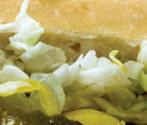
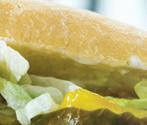




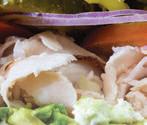



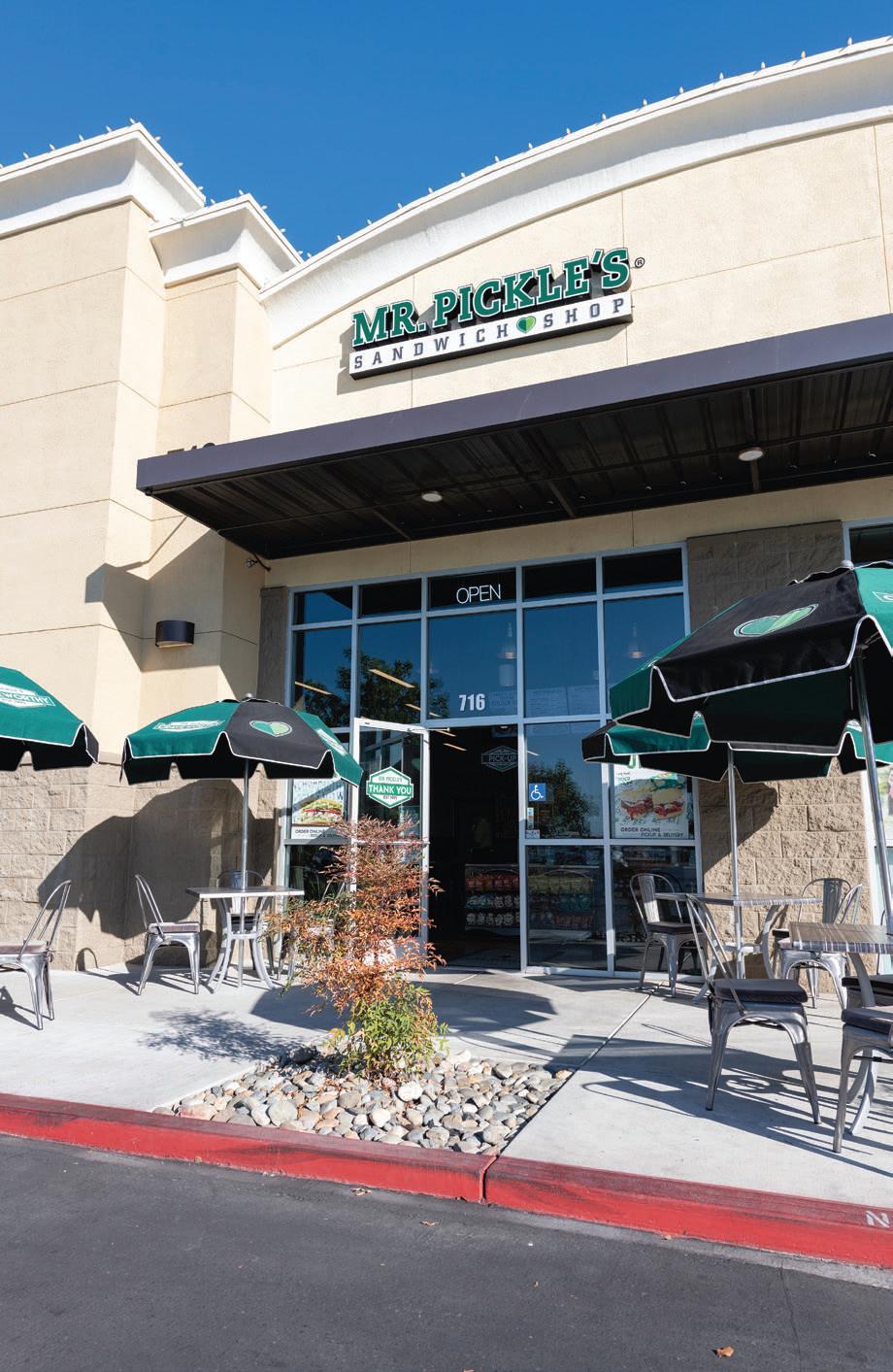
FOUNDERS: Rick Rosenfield, Esther Rosenfield
HEADQUARTERS: Los Angeles
YEAR STARTED: 2021
TOTAL UNITS: Two by early 2023
FRANCHISED UNITS: Zero
TO
UNDERSTAND ROCAA NEW FASTCASUAL

concept cooked up by California Pizza Kitchen cofounder Rick Rosenfeld and his wife, Esther—one must start at Roman pizza.
The married couple discovered it while on an extended trip to Italy more than a decade ago after Rosenfeld sold CPK. The style is called al taglio, which translates to “pizza by the cut.” Slices are divided into

small rectangular pieces.
“When I was there and introduced to it, I understood that there were several artisans in Rome taking this traditional street food and taking it to a new level,” Rosenfeld says. “As I started to study about Roman pizza, I really learned it has evolved over the last 50 years.”
One of the biggest distinctions is hydration. For a Neapolitan pizza, there’s 5 pounds of water for every 10 pounds of flour. Meanwhile, the Roman pizza calls for eight pounds of water for every 10 pounds of flour. It’s then placed in the refrigerator and cold fermented for 48–72 hours. Afterward, the pizza is put in an oven that heats from the top and bottom to remove all moisture. The result is a lighter and airier crust that’s more digestible.
That represents the “RO” part of the
ROCA name. The last two letters stand for the influence of California and its farmto-table ingredients. Some menu examples include Bell Pepper (tomato sauce, tomato sauce, roasted red and yellow peppers, balsamic glaze, chopped basil, and evoo), Italian Sausage Potato ( Yukon Gold potatoes, housemade Italian sausage, mozzarella, fried rosemary, and evoo), and Pepperoni Hot Honey (tomato sauce, pepperoni, mozzarella, gorgonzola, and Mike’s Hot Honey). Flour is organic and all meats and proteins are free of antibiotics and hormones. Pizza is offered by the cut, half, or full pan.
“That’s something that we did at CPK which is, pizza is a canvas that you can paint on, so we can do toppings that are not traditional toppings, and I say CPK introduced barbecue chicken pizza to the world,” Rosenfeld says. “It introduced Thai chicken pizza to the world. As it turns out, when we put barbecue chicken and our recipe on this crust, and we put Thai chicken on this crust, in my mind, it’s the best version that I’ve ever had. People who are tasting it are saying the same thing.”
Rosenfeld’s initial objective was to essentially recreate CPK with a full-service wood-burning oven, but he recognized the traditional Neapolitan or New York pizza didn’t travel well—and this was before the pandemic, when the rise of takeout and delivery was noticeably surfacing. The Roman style, however, is the most portable pizza product Rosenfeld’s seen.
In late May 2021, ROCA debuted as a pop-up experience at The Americana at Brand in Glendale, California. The plan was for the temporary store to last a few months, but the concept was the victim of the pandemic and struggled to get building permits. So the pop-up lasted a year, and in that time, ROCA was able to develop its team and menu. Yelp reviews were between 4.5 and 5 stars the entire time.
ROCA
ROCA
B Y B E N C O L E Y DEPARTMENT
CONTINUED ON PAGE 62 16 DECEMBER2022 | QSR | www.qsrmagazine.com
The cofounder of a casual icon has a new, differentiated pizza brand built for scale.
ONES TO WATCH

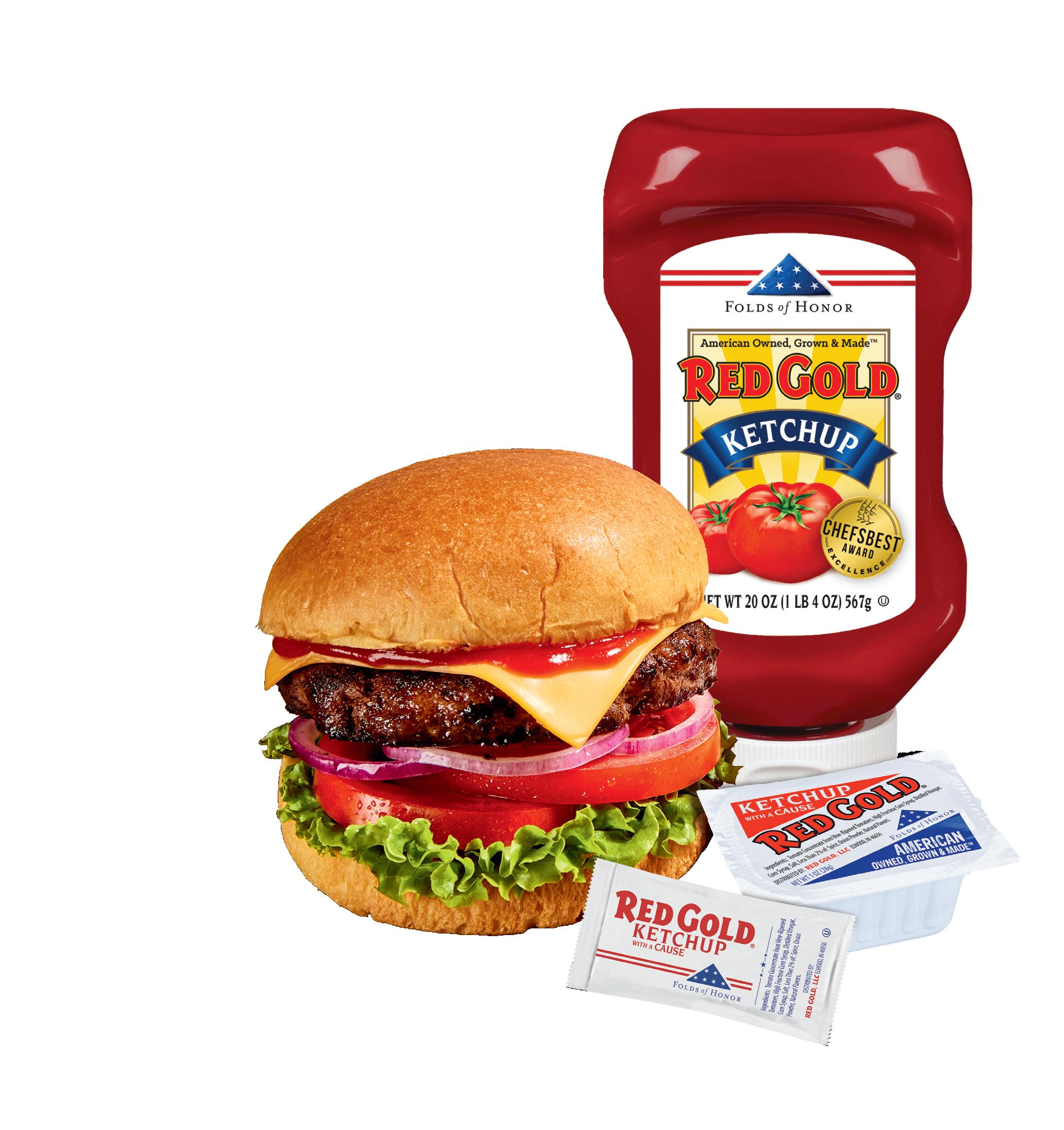





Red Gold is a registered trademark of Red Gold, LLC. Elwood, IN RG-1372-1122 The Ketchup You Can Count On. Products must earn the ChefsBest® Excellence Award by surpassing quality standards established by professional chefs. SCAN FOR FREE SAMPLE Red Gold® is the ketchup brand that worked hard for you during the pandemic. We’re the family-owned brand that your customers know and love. Now, like never before, we’re the ketchup you can count on. Learn more and REQUEST YOUR FREE SAMPLE at RedGoldFoodservice.com/sample-request
Dollars and Sense of Reviews
Engaging with feedback shouldn’t be an afterthought in today’s digital world.
sharing feedback, the manager or staff would respond, but online, guests are being ignored. It’s as if a guest is complimenting the manager on her experience, but the manager is standing with arms crossed not saying a thing.
Even worse, when it’s online, brands are doing that in front of tens of thousands of prospective guests who are considering whether they will select that restaurant.
The number of restaurants brands choosing to respond online and, as a result, the percentage of guest reviews we see being responded to is increasing, but is still surprisingly low. Many brands have not made engaging with their guests online a priority.
Not yet, at least. Likely, those brands are thinking most reviewers are negative or fake, other priorities are higher, it costs too much, there is no reward to responding, or if they ignore it, it won’t matter.
These thoughts are changing as data, technology, and experience are proving otherwise. As it turns out, most reviews restaurants receive are positive.
When I recently asked a group of restaurant operators how many reviews they believed the industry gets monthly, I was surprised at their estimates. Before sharing their answer, consider the question yourself. The answer? We see about four million restaurant guest reviews each month. That annual level has teetered up and down slightly from 2020 yet remains high at about 50 million reviews per year—and that’s just the restaurant industry.
Dining and ordering out is a frequent occurrence, and people love to talk about food and share their experiences.
Most of this feedback used to be exchanged face-to-face, often directly with the restaurant staff or to friends. Technology, smart phones, and social media have changed this, along with the impact of COVID, causing more and more guests to opt for online communication.

Despite an increased influx of online reviews and guest communication, restaurant brands aren’t drinking from the online guest feedback firehose as expertly as they should. The CEO of a large restaurant brand explained it well: If a guest was in the restaurant
The average rating of guest reviews for the entire industry is hovering around 4 stars out of 5. Furthermore, there is significant statistical evidence that a brand’s ratings correlate to their sales success.
A Harvard study found that a one-star increase is associated with a 5–9 percent sales increase. Merchant Centric has repeated similar analyses many times and found a one-star increase correlates with a 4–22 percent increase in sales, depending on the brand’s starting point.
Brands that respond to their guests and value their online star rating as an insightful business intelligence tool are reaping benefits that provide a virtuous cycle—they are enhancing guest relations, understanding guests better, identifying operational themes impacting business positively and negatively, building brand value, getting more reviews ( particularly positive ones) and likely improving SEO ranking, which is critical since search site algorithms promote businesses that engage online with users.
Having responded to more than a million reviews on behalf of brands we represent, we’ve developed best practices we share with all our restaurant partners.
These best practices also reveal how important
ADOBE STOCK MEEBOONSTUDIO
Online reviews can be troublesome and downright dishonest at times. But there are ways to turn them into a positive data tool.
B Y A DA M L E F F DEPARTMENT OPERATIONS [CONTINUED ON PAGE 62] 18 DECEMBER 2022 | QSR | www.qsrmagazine.com
Take control one napkin at a time
Save time and reduce waste with Tork Xpressnap

Tork Xpressnap® one-at-a-time dispensing reduces napkin usage by at least 25% compared to traditional napkin dispensers. Cut time on refills and save staff effort with improved, easy to use dispenser design.
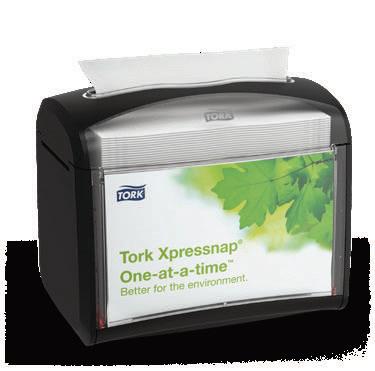



Visit torkusa.com/xpressnap to learn more
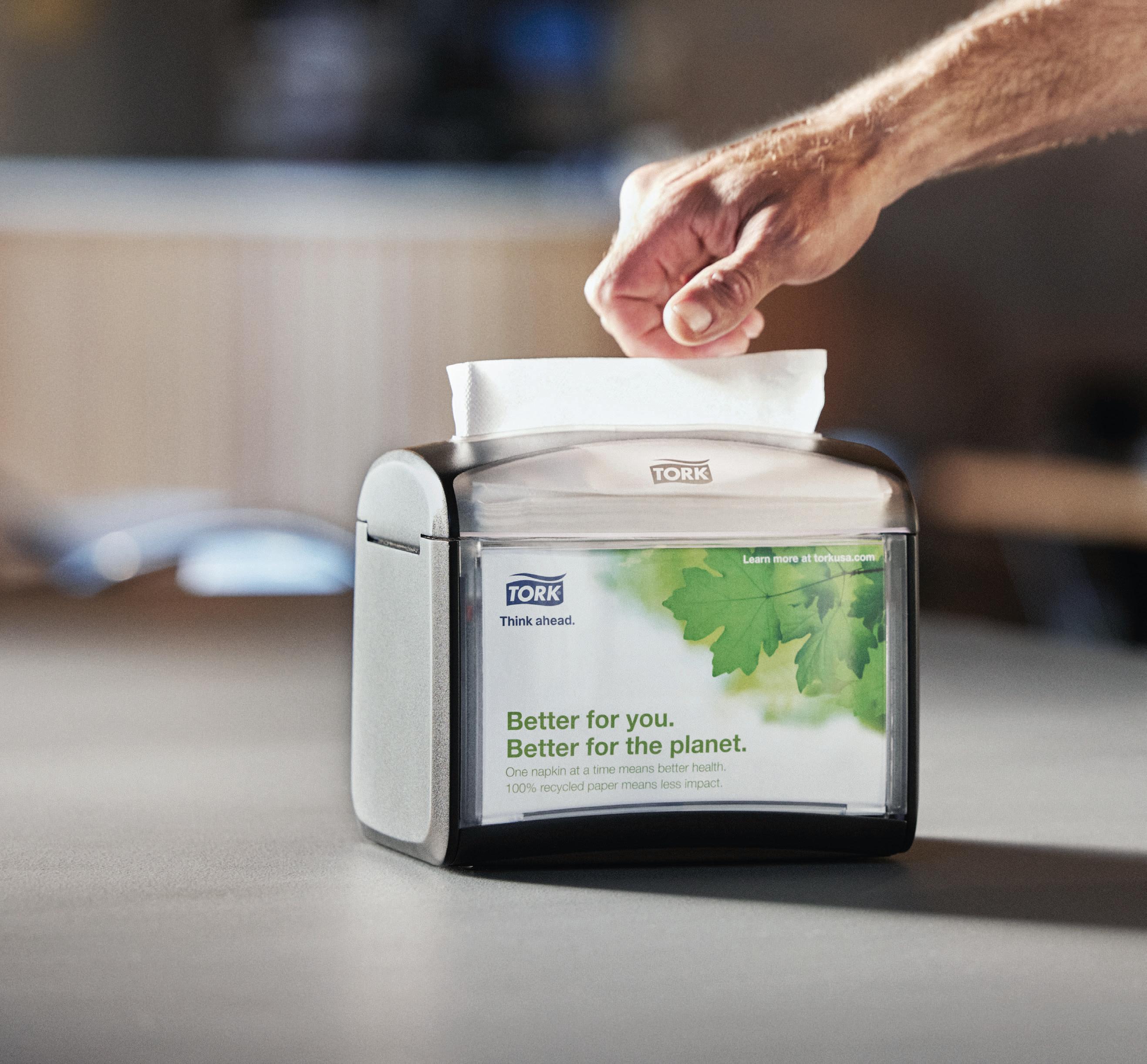
Tork, an Essity brand
GROWTH PURPOSE WITH A






 / BY DANNY KLEIN
/ BY DANNY KLEIN



CLEAN JUICE LLC FRANCHISING 20 DECEMBER2022 | QSR | www.qsrmagazine.com
is getting into a story on Clean Juice’s origins when interjects. “If she wouldn’t give [the food] to one of y’alls would you do that?” he jokes, referencing the brand’s guidepost—to serve product Landon and his wife, Kat, would giving their children (there are actually five). The between Tebow, the 6-foot-3, former Heisman Trophy husband-wife duo behind one of the country’s fast-















est-growing franchises, however, is evident. And it’s a relationship that began much like Clean Juice did in 2014 when it debuted in Huntersville, North Carolina—from a view broader than ROI.



Clean Juice was opening a store in Nocatee, a planned community located in northern St. Johns County, Florida, minutes from where Tebow won a state football title at Nease High School. Tebow was sampling juices and products and asked to meet the brass.
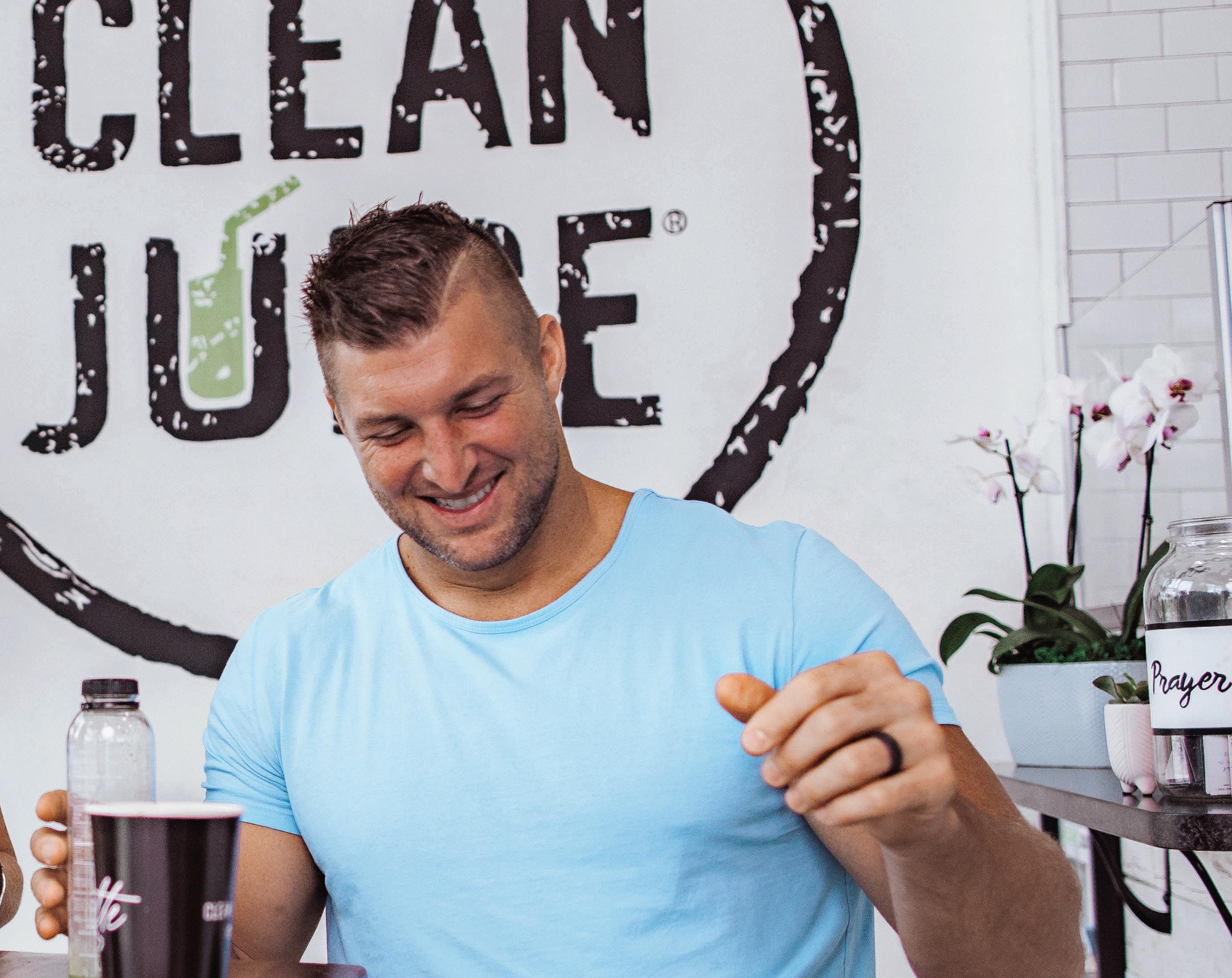
TIM TEBOW ( FAR RIGHT ) , KAT ECKLES ( CENTER ) AND LANDON ECKLES ARE READYTO EXPAND THE BRAND TOGETHER. Landon 19 early be rapport Clean Now, www.qsrmagazine.com | QSR | DECEMBER 2022 21
Juice and Tim Tebow first found common ground. they’re looking at plenty of opportunity ahead.
“And when Tebow says that, you go,” Landon recalls.
The Eckles flew down and met with Tebow and his wife, Demi-Leigh. Landon says they didn’t talk about business “for months.” It was mostly a conversation around making an impact with Tebow’s Quarters 4 Kids initiative, and finding synergy. For three hours, Tebow adds, they spoke about ministry, exercise, and even Jiu-Jitsu.
That’s not to say Tebow’s mind wasn’t churning, though. “I started to understand the background of all the product [Clean Juice touts itself as the nation’s first and only USDA-certified organic juice and food bar franchise],” Tebow says. “Since I was 15, I’ve just been so focused on health. I believe in the stewardship of it. I believe what we put in our body either gives us life or it takes life. And what I mean by that is it takes focus, it takes energy, or we lose it from it If we want to actually live life to the fullest and the best, let’s give ourselves the nutrients to actually do that.”
In August 2021, Clean Juice unveiled Tebow as its official brand ambassador and got moving on activations. This included social media, web, point-of-purchase materials, product development ( Tebow had his own curated meal), and the company’s first national TV spot.
“Started with a handshake and slowly worked into the partnership,” Tebow says.
Clean Juice billed the partnership as an accelerant for its next stage of growth. Or as Tebow puts it, helping “make it a household name in the organic food and beverage business.”

The chain opened seven stores in Q2 of this year and awarded an additional 13 units to first-time and multi-unit franchisees. That brought the total number of Clean Juice locations in the company’s system to 203, with 127 opened and 76 in development as of September. Its same-store sales rose 3 percent, year-over-year, with the total guest percentage up more than 9 percent from Q2 2021. Clean Juice cracked the Inc. 5000 for the fourth calendar and was ranked No. 21 on the top fastfood brands to watch.
It’s been a quick rise. Clean Juice had 72 franchise outlets at year-end 2019, which was up 25 net from the prior year. The brand would add a net of 17 locations in 2020 and 2021, respectively, alongside six corporate venues (none opened last year as franchising, which launched six years ago, has settled in as the main path).
Clean Juice reported its best Q4 in brand history to close 2021 with cumulative same-store sales gains of 20 percent. Across the year, comps rose 16 percent against COVID-riddled 2020. But notably, the brand served more than 3.3 million total guests,
which was 41 percent higher.
The period also included franchise entries into four fresh markets—Connecticut, West Virginia, Kentucky, and Montana.
Tebow’s role in this evolving story isn’t going to just be a front-facing one. On September 21, Clean Juice opened its third Northeast Florida location in the St. John’s Town Center, wedged between a Visionworks and BurgerFi. And Tebow was the franchisee.
His jersey is on his display and Landon says guests “definitely” realize it’s the “Tebow store.”
When asked if this is unit No. 1 of a potential fleet, Tebow nods at Landon and says, “hopefully.”
“I think there’s so much room and so much opportunity in the future to continue to grow to make this more available for people, to get to more stores,” he continues. “I would love to in the future after one, get to more, two, three, four, and continue to grow it. It’s not only something that I’m ambassador of, it’s something I use all the time.”
The sentiment covers Clean Juice’s wider ambitions, too. Landon says the brand hopes to serve 30 million guests some day. Eventually, 100 million, and beyond.
Through COVID, Clean Juice closed only one restaurant. Landon believes the reason dovetails with what’s also fueling expansion, and explains how a brand, relatively small in its category, could land a celebrity endorsement like Tebow. “It’s the passion of our owners,” Landon says. “They truly believe that when they open a Clean Juice in their community that they are making an impact and they’re serving food they can’t get anywhere else.”
Going back to Tebow’s first meeting with Clean Juice, he explained to the Eckles there were mega-watt offers out there from brands he couldn’t get behind. Clean Juice couldn’t touch the dollar figures, but it had a mission Tebow supported.
“Like we tell everyone who gets into franchising,” Landon says, “we have the team to teach you the rest. Start with the best. Start with what you care about it. There are 4,000 concepts you can be a franchisee of, so pick the one you care about.”
Tebow’s goal isn’t new to quick service. He wants to break down barriers to healthy food and widen accessibility. Tebow was on the chair of Florida’s governor’s council of physical fitness when he was in college at UF. He cites obesity studies and freely talks about nutrition.
Making his own juice, Tebow combines spinach, celery, cucumber, lemon, ginger, and turmeric. He generally loads up on protein and cycles through shots. Tebow “crushed” a couple of juices before taking the stage in August to surprise operators at Clean Juice’s annual “Juice Jam” conference, held in Charlotte.
CLEAN JUICE LLC 22 DECEMBER 2022 | QSR | www.qsrmagazine.com FRANCHISING
TIM TEBOW’S PHILANTHROPIC EFFORTS WERE AN INSTANT FIT FOR CLEAN JUICE’S BROADER GOALS.
COMPETE WITH COFFEE AND TEA
In today's environment, foodservice operators are facing ongoing challenges like inflation, labor shortages, and supply chain issues - just to name a few. According to Cleveland Research Company in their recent “State of the Foodservice Industry" webinar, research shows that despite inflation, consumer demand for restaurants looks to remain strong and the outlook for dining out is optimistic. However, with growing competition to win consumer loyalty, how do you ensure you're standing out?

By providing a full-scale, top-quality coffee and tea program, you are laying the foundation to greatly enhance your food offerings! By upgrading your coffee and tea programs, your establishment can become a destination for hot and iced coffee and tea all day long!
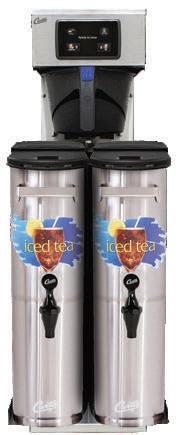
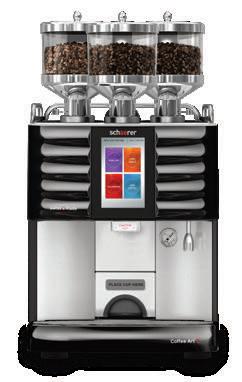


wmf-coffeemachines.com • schaererusa.com • wilburcurtis.com
But simply, just as the Eckles wanted to make a concept they’d feel good putting on the family table, Tebow felt the same about one he’d open franchises for. “There are a lot of places where you are saying, this is healthy, and they’re putting stuff in it. And I just think it’s really important that you build trust that what you say is accurate,” Tebow says.
Landon feels the same, which is why Clean Juice carries the organic banner. It’s an ethos that was never easy to execute and comes at a cost, especially as the brand expanded its menu in recent years to include sandwiches, salads, and wraps.
When Clean Juice debuted, it only offered juices, smoothies, and acai bowls. “But our promise was always we wanted to have something for everyone,” Landon says. “We wanted to be able to cater to somebody like Tim Tebow or cater to somebody who comes in and maybe they’ve never eaten healthy in their entire lives.”
“What does that mean? Put titles on this stuff,” he adds. “But let’s talk about what does it mean to be certified organic. What happens? What is the grasp? What is the story? And it was a really fun and enlightening conversation that then leads to a lot of conversations, right? Conversations of yeah, sometimes you have to charge more for that because it’s going to cost more to get healthy. We talk about we want to make it as affordable as possible but you’ve also got to keep it as healthy as possible. To do right by people. For us, it never started with ROI—it started with a belief.” Over the years, however, Clean Juice has worked on that profitability plenty. Landon spent years in sales and management in the pharmaceutical industry before moving into a managing partner role at Rose Rock Group, a global investment management firm specializing in Asia spe-
cific projects in 2012. He was spending weeks on the road and overseas. Landon stepped back as his family life suffered. The Eckles then moved to Charlotte and launched Clean Juice.
Last year, Clean Juice’s average gross sales ( 95 counted units ) clocked in at $570,816. Roughly half met or exceeded the number, with the top 50 percent averaging $684,621. The average gross profit across those 95 units was $361,315. At 12 corporate locations, average gross sales and profit were $527,059 and $325,921, respectively. Franchisees: $576,657 and $366,200.
It’s all helping the story. When Tebow spoke at Juice Jam, his message was to think about food as a circular opportunity. “Not only can you impact them with the product, but you can impact them with your smile, your kindness, with the way that you serve them, with the way that you care about them,” Tebow says. “And try to back it up with statistics. Statistics on belief. Statistics on loneliness. Statistics on obesity. All of those. When people walk into the store, there’s a lot of people who are hurting, who are lonely, who need someone to believe in them, who need encouragement. Right now, when someone walks in you have the opportunity to impact them in more ways than just a bowl or a smoothie or a juice.”
Landon says many of Clean Juice’s franchisees arrived with a reverse mindset from much of the industry. They came in buying in and then asked to learn. Tebow adds many he’s met so far aren’t major business groups or portfolio builders. “No, it’s hey, I want to be healthy and then I learned the business model. That’s been pretty cool,” he says. q
 Danny Klein is the Editorial Director of QSR magazine. He can be reached at dklein@wtwhmedia.com
Danny Klein is the Editorial Director of QSR magazine. He can be reached at dklein@wtwhmedia.com
CLEAN JUICE LLC 24 DECEMBER 2022 | QSR | www.qsrmagazine.com FRANCHISING
TIM TEBOW MADE A SURPRISE VISIT TO CLEAN JUICE’S “JUICE JAM” THIS YEAR.
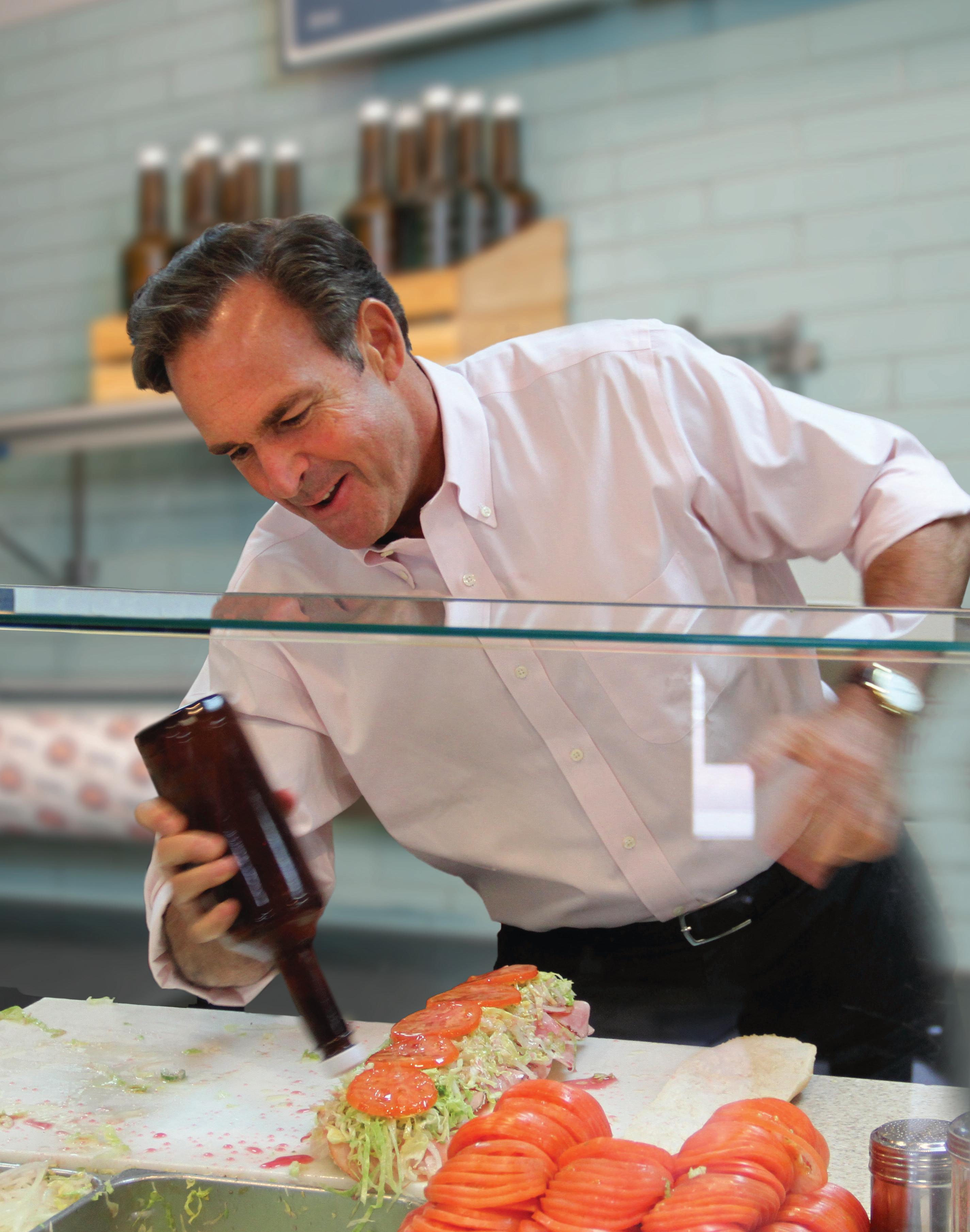
Domestically & Internationally! Join the Movement A Sub Above, LLC, 2251 Landmark Place, Manasquan, NJ 08736 Jerseymikes.com/franchise franchise@jerseymikes.com You can become a JERSEY MIKE’S OWNER! WE ARE JUST STARTING TO GROW... Founder / CEO Peter Cancro
























QSR’s
26 DECEMBER 2022 | QSR | www.qsrmagazine.com DIGITAL INNOVATION
DIGITAL DISRUPTORS
Rom Krupp
OneDine FOUNDER AND CEO
Pandemic conditions— namely the inability to dine in—cracked wide a world of innovation that historically had trailed other industries, like retail. The reason why wasn’t a great mystery. Food is a personal experience and operators have longed relied on their gut instincts to survive. But today’s landscape, rife with technology, flooded in thanks to adoption and, also, what’s fast become an understood point— that guest experience and solutions can, in fact, live side-by-side.
As breakneck as these innovations arrived over the past couple of years, however, restaurants are now recalibrating and asking themselves what comes next. There’s no lone answer or sure-fire reality. Yet there is, without debate, a lot to discuss.
For the second year, QSR recognizes its Digital Disruptors: the change-makers and innovators laying the blueprint for a more connected restaurant world than ever.
BY DANNY KLEIN, BEN COLEY, & ISABELLA SHERK
The year was 2018. Rom Krupp cleared the table and got dystopian for a moment. What if the restaurant industry never existed? Could a tech company approach food as an all-new sector? Krupp not only thought it was feasible, but fundamental to where consumers were taking restaurants. An industry built on guts was beginning to understand the value of data, as Krupp’s 2012-founded Marketing Vitals was proving out. But the next great disruption was unfurling within the structure of restaurants themselves. “The industry that we’re going to build will serve people food the way today food is being served,” Krupp says.
This was the starting point for OneDine, a company that’s capabilities web out into a lot of areas. At its center, though, it’s a platform that supercharges existing POS systems to enable contactless ordering and payment, to optimize labor, eliminate fraudulent chargebacks, and create a “triple-win for servers, managers, and guests alike,” the company says.
What Krupp, who has been in the business for 26 years, recognized was a lack of agility among POS devices.
As he explains it, “a ground-up rewrite of looking at the restaurant industry as a brandnew industry. Not one trying to adopt all of the things that have been adopted for the last 40 years.”










Krupp doesn’t believe restaurants need a brick-and-mortar tech stack anymore. Consider a project OneDine recently tackled. It completed a baseball stadium setup—23 concession stands, eight kiosks, 12 handhelds for VIP suites, 7,000 QR codes, and 180 pickup cubbies. But the key was OneDine did so without installing a single piece of software in the building. Everything runs from secure browsers.
“Cloud-based POS are not really cloudbased POS, they’re cloud-based databases,” Krupp says, “which means the POS is running




locally but the database is running in the cloud; but there’s software running in the building. That means you have to upgrade it, version control it. We don’t. Even the software is running as a web service. So there’s nothing really deploying to the field. And that’s a brand-new way to look at the industry, which is you don’t need actual software to run the physical locations.”
OneDine early on created handheld tablets that interfaced with a merchant’s existing tech stack. It was a solution focused on labor and creating a contactless and efficient ordering and payment process for servers and diners. It established PCI and EMV compliance and eliminated fraudulent chargebacks.
However, this was just an opening shot. OneDine expanded to incorporate additional contactless payment tech, mobile menu browsing, and curbside order and payment options to help restaurants generate off-premises revenue. AI surveys, guest preference tracking, and offer management eventually made their way into OneDine’s 360-degree solution as well. It then expanded to accommodate multi-merchant venues (like malls), hotels, airports, retail establishments, and event venues, such as the stadium case.
In Krupp’s two-plus decades working with restaurants—he spent 16 years with Custom Business Solutions before Marketing Vitals— he’s seen the space evolve from POS’ infancy in 1996 to now. And what’s happened since, he says, is commerce has become increasingly decentralized. That began in the early 2000s as online ordering arrived. Krupp himself was involved in launching the integrated system for Jason’s Deli from the internet into the POS in 2000.
Restaurants quickly had different channels for online ordering and different ones for digital menus. It was an OK concept when that slice of business represented a “few percentage points here and there,” Krupp says. But in 2018, the world had morphed to 30–50 percent of sales for countless brands sector-wide.

So given how many transactions were now decentralized, the amount of effort it was taking operators to manage commerce ballooned into a massive, and often messy, undertaking.


“Because everything was still anchored in the POS systems,” Krupp says, “and the POS system was built to run the brick-and-mortar; they were never built to run kind of an Amazon concept. An ecommerce concept. Commerce is not only happening in multiple channels for you as a brand that you can control—commerce was also happening in channels you couldn’t control.”
Krupp is referencing streams like thirdparty marketplaces and Google ordering.
Again, going back to the ideation of OneDine, Krupp says he didn’t look at the industry’s evolution only through the lens of labor. There were a bevy of solutions working to help restaurants maintain new channels
/
Restaurant technology is no longer the laggard.
www.qsrmagazine.com | QSR | DECEMBER 2022 27 DIGITAL INNOVATION
ONEDINE JOHN DAVIDSON
ADOBE STOCK BY BLANKSTOCK
and improve flow.
Krupp says efficiencies in throttling and quoting times, and just managing kitchens in general, flashed on the horizon. “When you have multiple commerce channels, POS, onpremises, off-premises, third-party, not only do you have six or seven vendors to do commerce, but how do they know to quote the delivery driver the right timing and not effect negatively the people who showed up in the building and are sitting in the tables?” Krupp says.
And this is where OneDine staked its future: recentralize commerce and build a platform that brings all of it into a single cloud. With it, they could know what’s happening in the building, outside, in real time. Every table, guest, and third-party. In turn, restaurants won’t have to throttle in a way that had become all too common—an effort to stop people from ordering. Krupp says “throttle” remains a misused practice that can refer to slowing down the business. “For me, throttling is moving it around to optimize revenue. If you try to place an order for 12:30 and based on your mix and the time and how busy the restaurant is, I’ll tell you it’s 12:42,” he says. “You’ll probably complete the transaction and come 12 minutes later. I can squeeze that over and have that low in the kitchen where I can actually do it. We’re not throttling away business, we’re throttling it to optimize the kitchen to be busy all the time.”
Naturally, when COVID hit, these topics lit up. Brands had to rely 100 percent on offpremises. Ghost kitchens were thrown into the pool. Now, restaurants didn’t just have to throttle their own brands; they had to throttle multiple from the same station and equipment. “We had to create a system that was built for commerce and modern time,” Krupp says, “and it didn’t exist.”
“Think about how many vendors and how many partners and how many places you have menu curation and databases,” he adds. “All of that is trying to figure out in real time what’s happening. It cannot work. It just cannot. You hit the limitations of the old digital technologies of restaurants. POS as an anchor doesn’t work anymore.” To put it plainly, the engine driving the industry was flawed. “The key here is the commerce cloud to really be the one engine to drive 100 percent of commerce,” Krupp says. “Because then all of the features up to that can work. But without that commerce cloud you can build a million features and it won’t work.”
The opposite charts as follows: Use a POS to enter orders and collect payments, and nothing else. Deploy a third-party kitchen technology and third-party reporting platform. The same for labor and inventory. “But everything has to go to that engine because that’s the engine that controls the kitchen at the end of the day. And that flaw is what creates every downstream problem,” Krupp says.
On the B2C side, OneDine wanted to funnel
information just as it did with systems. Generally today, because consumer data is distributed, you can have 100 customers of the same POS companies or online ordering platforms, and 100 profiles. Or 100 times a restaurant needs to set preferences and 100 different systems to conduct machine learning.
With one commerce engine, though, Krupp says, there’s a lone identity for every consumer that translates across. “Then when you go to a new restaurant that you’ve never been and you tap in with your phone or you go online to place an order, the moment you interact with anybody in the same commerce cloud, the preference engine, the recommendation engine, the filtering, is applicable to you on the first visit ever,” he says.
Zach Goldstein Thanx CEO AND COFOUNDER
and butter at Thanx.”
Before Thanx, Goldstein, working as a consultant at Bain & Company, helped bring a private-equity owned restaurant back to life. The chain was debt saddled and new units were less successful than existing ones. Using data, he helped refine site selection, menu innovation, marketing segmentation, and executive hiring. But at the time, Goldstein says, e-commerce giants were growing larger by the day, propelled by the sophistication of their loyalty programs and the ease with which they measured and acted on customer lifetime value and customer acquisition cost. “These concepts were largely absent from restaurants and I wanted to change that,” he says.
Much has shifted since 2011. Goldstein says the world “loyalty” itself was long a pejorative for restaurants—or something only discount-oriented brands embraced.
“While brands shied away from rewards, they also continued fumbling around in the dark with marketing,” he says. “Famously, Chipotle announced they would never launch a loyalty program; theirs is now among the fastest growing in the industry, alongside previous holdouts such as McDonald’s. Loyalty has become essential because brands are competing in a digital-first arena—not just with each other, but with their third-party partners as well.” And now, other than some fine-dining concepts, nearly every restaurant is leaning into digital and off-premises, and finding loyalty integral to all of it, especially when it comes to stripping discounts and guarding margins. “This next era in restaurant technology will move beyond ‘does it integrate to my POS’ and toward true data interoperability and transferability,” Goldstein says.
Zach Goldstein founded loyalty and digital engagement platform Thanx in 2011 to help brands use data to drive lifetime value. Like many elements of restaurant tech those days, the industry was lagging other fields, like retail. Goldstein felt if restaurants could catch up, they had an untapped avenue to nearly double revenue without adding a single guest. It would all come from existing users.

Thanx focuses loyalty programs on access, status, and personalization over rote discounts, and it delivers marketing automations and lifecycle campaigns (like converting a two-time customer to a third visit) to enable segmented, personalized marketing. “Since 2018, I have been writing and speaking about the massive disruption and threat restaurants face from third-party delivery,” Goldstein says. “Never has it been more important for brands to own their customer relationships directly; this starts with exceptional first-party digital experiences [online ordering] and on-brand incentives for customers to come back overand-over again [loyalty]—these are our bread
No longer will the POS be the core of a restaurant’s tech stack, he adds. “Capturing 360-degree data about your customers and the ability to interact with them personally, regardless of channel, are becoming just as mission-critical as producing differentiated food,” he says. Goldstein believes the next big tech trend will be automation and ease-of-use across tech platforms. “This is an area where set-it-and-forget-it—but with the help of an intelligent engine at the core—is actually possible,” he says.
Stacy Peterson Androes Wingstop ( former ) CHIEF TECHNOLOGY OFFICER
Stacy Peterson Androes joined the company in 2013 when online ordering represented 5 percent of sales (she departed Wingstop in December to become CEO at a privately held company). The experience then was so frustrating operators would often turn off the
28 DECEMBER 2022 | QSR | www.qsrmagazine.com DIGITAL INNOVATION
THANX
100% recyclable branded take-out packaging for easy mobile pickup, catering, and drive-thru orders.
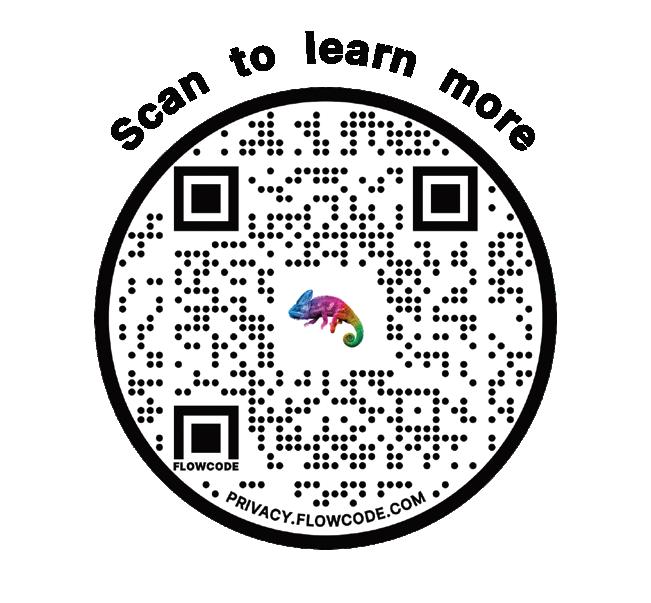


channel in favor of serving the in-store guest. But for the past few years, the digital experience at Wingstop couldn’t be a bigger 180. More than 60 percent of the chain’s sales are now digital, and the long-term goal is to digitize 100 percent of transactions. The concept took a big step forward in this endeavor with the opening of a 1,300-square-foot digital-only restaurant in Dallas. The store is optimized for carryout and delivery customers; if one didn’t order ahead they can use a QR code to order inside the store.
“It’s not exactly easy to do this kind of transformation,” Androes says. “It requires a lot of foundational work. You can’t just have a digital business and have that underlying technology deprecating at the store. So there was a good solid two years of converting the system to a common point-of-sale system, making sure our menus were aligned across every single one of our stores, so that when we did layer on top these extensions to our brand like a digital business, it had the right foundation to be successful both for the operators and the guests.”
For Wingstop, Androes says the next frontier is building its digital presence internationally. The brand is repeating some of the early steps it took while reimagining the domestic business. The goal is to make the right initial decisions so the fast casual can grow the right way in terms of store count and operational capabilities, “unlike a lot of the pizza players where their growth got ahead of their technology investments,” Androes explains.
Androes also recognizes that sometimes technology can be too much. Wingstop strives to have a simple and efficient model, and its rule of thumb is that a solution can’t stand in the way or add a bunch of steps to existing operations. Even though sales are now a majority digital, it takes the same amount of time for a worker to prepare a web/app order as it would if they rang it up at the in-store POS system. Androes says there are a number of initiatives Wingstop turned down over the years because they didn’t pass a multi-step test of—can it be easily adopted into operations, is it good for franchisees, does it work well for customers, and is it worth it from a cost and complexity perspective? Some of the things that didn’t make the cut in the past include automated pickup lockers and AI phone service technology. At the time, Wingstop chose not to pursue this infrastructure because either the technology wasn’t quite there or the cost model didn’t make sense. But, with business changing significantly in the past two years, including the labor environment, the fast casual is taking a fresh perspective at resolving phone ordering issues.
“Using machine learning and AI solutions as well as call centers, and it’s under different conditions, that technology may make sense yet again,” Andores says, projecting Wingstop’s potential future.
Meredith Sandland
Empower Delivery CEO, AND CO-AUTHOR OF DELIVERING THE DIGITAL RESTAURANT


sion through a holistic architecture that uses data from each part of the process to inform decisions. It was battle-tested at ClusterTruck, delivering more than 3 million orders during the last six years. “I stepped into the CEO role because the Empower Delivery software is exactly what I have been looking for these last two years while writing the book,” Sandland says.
“Empower Delivery is software purposebuilt for the delivery-optimized restaurant,” she adds. “It enables faster delivery times, higher quality food, better margins, lower prices, and less complexity.”
Sandland, who along with Carl Orsbourn, co-authored the Axiom 2022 Business Book Award Winner, “Delivering the Digital Restaurant,” came to restaurant technology through development. Her first large-scale tech project was digitizing market planning at Taco Bell, a brand she helped build 1,000-plus units for as chief development officer. “We created sales forecast models, cannibalization models, and data visualization tools using the latest data sources like mobile phone traffic,” Sandland says. “Now, these approaches are an expected part of an advanced real estate strategy. The big change? The SaaS-ification of our industry. Even a one-unit restaurant can access the tools huge chains historically spent millions building internally.”
Sandland’s next exposure came through Kitchen United, which she joined as employee No. 4 to create its business model, raise initial capital, and serve as the public face of the GVbacked disruptor. “To work, a ghost kitchen must have a top-notch digital ecosystem because, by definition, most consumers are accessing the food digitally,” she says. “What we see now is an explosion of MarTech and OpsTech. On the MarTech side, companies are creating digital relationships with the consumer—everything from the third-party marketplaces, which are really just food-specific search engines, to CDP and loyalty platforms like Bikky and Thanx. On the OpsTech side, players like Galley and Restaurant365 are infusing technology into the back-of-house.”
In September, Sandland and co-founder Chris Baggott announced the launch of a new venture—Empower Delivery, which is the software that powers vertically integrated virtual restaurant and ghost kitchen ClusterTruck. As a SaaS company now available to all, Empower Delivery enables restaurants to profitably and sustainability serve the delivery occa-
Broadly, Sandland believes the industry is headed for a period of consolidation after five years of breakneck innovation. Point solutions could be acquired into larger entities that offer more end-to-end technology suites for restaurants. “SaaS was exciting for smaller players because it leveled the access playing field to great technology,” she says. “But it does tend to create a lot of complexity, and independents and smaller restaurant chains don’t always have the staff to keep track of so many different pieces of tech. As more holistic suites become commonplace, the playing field will be further leveled.”
And the next big trend? Automation, but not in the sense of robots replacing humans. “As we’ve seen in cars, electrification and smart augmentation of human operators are pre-conditions to automation,” Sandland says. “I think we will see increased adoption of electric cooking equipment, smart ovens, and software that increases human productivity in the restaurant.”
KFC
MANAGER OF DIGITAL
Celeste Stevens
U.S.
CUSTOMER EXPERIENCE AND ENGAGEMENT
Celeste Stevens, KFC U.S.’s manager of digital customer experience and engagement, loves her role’s intersection between marketing and technology. She is responsible for guests’ technological journey across CRM, e-com-
KFC 30 DECEMBER 2022 | QSR | www.qsrmagazine.com DIGITAL INNOVATION
EMPOWER DELIVERY
merce, loyalty, and customer-facing digital programs inside restaurants. At its core, the job is geared toward leveraging data and segmentation in a thoughtful way to determine how, when, and where KFC engages. Stevens says the most successful personalization strategies are those that anticipate the wants and needs of each consumer.
Thanks in part to her efforts, KFC U.S.’s digital sales increased 70 percent year-overyear in 2021, driven by delivery and a new e-commerce platform. In Q4 2021, the chicken giant rolled out Quick Pick-Up, a process in which customers are able to grab mobile orders off cubbies inside stores.
“KFC has made significant progress in understanding who our customers are, what they purchase, and what drives them,” Stevens says. “We’ve built a world-class marketing technology stack to analyze and measure our customer behavior and have started to put it to work to activate against our customer segments.”
Stevens began her career in digital advertising before entering the quick-service space and quickly falling in love. When she started, restaurant technology was mostly focused on back-of-house systems, but recently, she’s noticed a shift to customer-facing solutions. That doesn’t mean the kitchen is taking a backseat, however. Stevens predicts the industry will see full automation in respect to food prep and order fulfillment based on realtime demand, inventory levels, and forecasts. This in turn will allow workers to focus more on the hospitality side of business.
Gagan Sinha Inspire Brands SVP, RESTAURANT TECHNOLOGY
Gagan Sinha sees the next wave of restaurant tech as an operations system that acts as a “self-driving car.”

“What I mean by that is there are so many routine aspects of our business models that no longer need to be overseen by a person, and instead can be monitored and executed with artificial intelligence,” he says. “There are many tasks that can be managed with the right technology, like creating weekly schedules for team members or overseeing food equipment. If we’re able to streamline these processes with AI, employees can shift their focus to the customers and help create a more personalized experience.”
Sinha joined the space as a software engineer in hospitality. After spending 17 years working with a variety of restaurant and retail
brands, and building global teams to lead transformation and innovation, Sinha was approached by Dunkin’ to direct its next-generation technology. When Dunkin’ was acquired by Inspire Brands in 2020, his role expanded to include the full portfolio of Arby’s, BaskinRobbins, Buffalo Wild Wings, Jimmy John’s, Rusty Taco, and Sonic Drive-In.
Sinha’s experience with Dunkin’ transcended much of what was happening industry-wide. Namely, although the sector had broadly taken a laggard approach to technology, with some prioritizing digital transformation more than others, Dunkin’ was on the forward-thinking path. “Dunkin’ had the desire to join this new wave from the start and began creating a roadmap for technology innovation,” Sinha says. “Along the way, we adjusted the underlying foundation of our brand to create a new point-of-sale, as many other companies followed suit. As restaurant technology continues to advance, I’m eager to witness how it will lead to more growth not just for Dunkin’, but for the industry as a whole.”
Returning to the future, Sinha says Inspire Brands continues to ask itself two questions: What can we do to simplify repetitive actions to focus on the big picture? And, how can the multi-brand platform use technology and progress to provide a better experience? “At Dunkin’, we’re thinking through new ways to address these questions, particularly with our drive-thru. We want to cultivate VIP experiences that recognize our guests’ commitment to the brand, including the generation of more personalized digital menu boards that present relevant suggestions based on previous order history,” he says.
Sinha adds Inspire Brands is “extremely interested” in the power of AI. Dunkin’ is fleshing out ways of using the tech specifically to automate daily operations and individualize guest services and interactions. “We want to create a space where our team members can place a larger focus on our guests, and we recognize the role that advanced tech will play in doing so,” he explains. “We recognize with our ability to leverage back-of-house software to further develop as a brand, and we plan on doing exactly that.”
Elevating its drive-thru is another focus. Dunkin’s sales run predominantly through the channel and the industry, in general, saw the category burst forward through COVID; not just in usage, but also in how tech could elevate the bar.
“This includes modernizing digital menuboards that highlight relevant menu items depending on time of day, adding more efficient dual-lane locations, and implementing loyalty member-only lanes,” Sinha says. “We’ve also continued to evolve our loyalty app, update and enhance our infrastructure to enable curbside pickup options, and strengthened integration with our delivery partners. “
Krystle Mobayeni
BentoBox COFOUNDER Fiserv HEAD OF RESTAURANT SOLUTIONS
Krystle Mobayeni was a web designer and consultant when she started taking on restaurant clients. One thing she couldn’t find, though, was a resource focused on the specific tools operators needed to drive revenue, things like catering orders, selling tickets for private events, and managing a concept’s presence on Google and Facebook. What Mobayeni also recognized was existing technology was driving a wedge between restaurants and guests.
In 2013, she cofounded BentoBox with Pierre Drescher to empower modern restaurants to build their online presence, diversify revenue, engage with diners, and increase operational efficiency.

Today, Mobayeni leads the restaurant solutions team at Fiserv, a global payments provider that acquired BentoBox in November 2021. Restaurant Solutions, which includes the BentoBox and Clover brands, delivers a best-in-class option and enhanced experience to restaurants, she says.
“A few years ago, restaurants and technology co-existed. Restaurants knew that they needed technology to support their business, but they looked at the on-premise and off-premise as two different experiences.” Mobayeni says. “Additionally, the restaurant landscape was built on layers of fragmented technology. Today, we see technology in restaurants shifting to a unified, modern experience that connects the on-premise and off-premise, and eliminates friction among the different technologies.”
The coming evolution, she feels, will center on an opportunity that doesn’t get the spotlight it warrants. “We hear a lot about diner data, but the real power, which gets little attention, is how technology can help restaurants make better decisions and deliver great service with this data. Knowing consumer preferences is important—what we should
INSPIRE BRANDS
www.qsrmagazine.com | QSR | DECEMBER 2022 31 DIGITAL INNOVATION
BENTOBOX FISERV
really be talking about is how to apply that information so restaurants can focus on the diner experience,” Mobayeni says.
The task rings familiar. Mobayeni is working to solve the fragmentation that exists in restaurant technology. To do so, her company is strengthening its omnichannel platform to deliver a blended on-premises and off-premises restaurant and diner experience. “One specific area of focus is first-party reservations,” she says. “We are working to combine reservations, POS, and websites to create a powerful offering that empowers restaurants to engage directly with their diners rather than through a third-party service.”
Claiborne Irby
Focus Brands
SVP OF CUSTOMER ENGAGEMENT AND STRATEGY
ments in how we engage with our customers,” Irby says. “We are using years of historical data to build an impressive offer engine and suggestive selling capability. By leveraging existing data, we are building the right infrastructure and tools designed to delight customers and drive returns for our brands and franchisees.”
In the future, Irby believes the biggest opportunity for Focus Brands—and the restaurant industry overall—is determining what portion of technology should be owned and managed internally versus outsourced. Bringing in the right tools and resources in-house will lead to significant competitive advantages, the digital executive says.
Sterling Douglass Chowly COFOUNDER, CEO


Sterling Douglass began his career as an actuary. Or as he puts it, one of “nerdiest jobs” you can have. The combination of statistics and finance, rooted in data, provided him a foundation. But after two years, he noticed every project started with the same six-word question: “What did we do last time?” Eventually, he tackled a fresh task that left him realizing entrepreneurship might be in his path. He turned to building a mobile ordering app for bars and taverns. It allowed customers to have drinks brought to their table or be available for express pickup at the bar; no more waiting to close your tab or flagging down a server.
of the inaugural U.S. launch of Uber Eats. The Chowly integration was live the same day.
Then came Eat24, DoorDash, and other marketplaces. Customers turned in requests for call center order integrations. Voice automation, which Chowly has had live since 2018, was added as an integration partner. Customers said they needed to sync their menus directly from their POS. Chowly claims to be the first company to release that in 2020.
Next, they wanted reporting. After, customers asked for a Google integration, and Chowly did so for SMB customers in 2021.
Over the past six years, Chowly has added more than 12,000 restaurants to its platform and supports north of 300 online ordering integrations and 50 point-of-sale integrations.
“Everyone is talking about virtual restaurants and omnichannel ordering, and they should,” Douglass says of the current and future tech field. “It’s big, and every restaurant should be looking at it. However, underneath the hood, there’s a deeper issue going on at restaurants, and it’s not robots or drones—it’s boring old data. I believe the innovation here will be the next stage of reinforcements restaurants will receive to improve their businesses.”
Karl Goodhew BurgerFi CHIEF TECHNOLOGY OFFICER
Karl Goodhew is relatively new to the restaurant industry.
In Claiborne Irby’s role, he is responsible for all customer, commercial, and strategy teams, with an emphasis on using customer insights and data to drive performance of loyalty and digital channels. Focus Brands aims to understand guests better so it can serve up experiences worth repeating. Over the past few years, the restaurant group—comprising McAlister’s, Schlotzksy’s, Moe’s, Jamba, Auntie Anne’s, Carvel, and Cinnabon—has doubled down on its customer-centric approach. For instance, the company created a full machine learning engine that automates better offers to members of McAlister’s rewards program. The engine learns from each successive run and automatically improves offers in the next go-around. It’s an improvement upon wide-casting generic offers that are often more expensive and less effective. A customer who buys just one entrée may not want a BOGO deal, but they may go for additional loyalty points. Focus Brands is now scaling this success to other brands in the portfolio.
“We are sitting on a treasure trove of data and have worked quickly to use the information we already have to make critical advance-
Douglass ran into a problem, however. Bars wanted the platform to integrated with their POS instead of getting a separate tablet to receive orders on. So he created one of the first POS integrations back in 2015. It made him face another point, though: If you could integrate orders into the POS, why not just do it for Grubub? Fellow restaurateurs in Chicago said the same thing.
And Chowly was born. The POS integration company enables restaurants to expand and maintain a diverse set of off-premises capabilities. It integrates online ordering solutions, such as third-party marketplaces, which include Grubhub, Uber Eats, DoorDash, and Postmates; third-party menu management using POS sync technology; and direct order with Google, an integration for orders placed on Google Search, Google Assistant, or Google Maps—directly into a restaurants’ POS system. The company has expanded to offer tools needed to launch virtual restaurants as well.
Douglass founded Chowly with Justin McNally. After the duo integrated their second order at local Chicago pizzeria, D’Agostinos, another light bulb clicked. There was an industry challenge at hand when it came to moving data between systems. In 2016, one of Chowly’s first restaurant partners was part
In fact, BurgerFi is his first executive position in the food and beverage segment, after past stops at Macy’s, Omni Hotels & Resorts, and JCPenney. Yet he’s leading a fast casual that always seems to be on the forefront of innovation. As chief technology officer, he’s responsible for all aspects of the customer and employee experience that includes a technological component, in addition to corporate cyber security, internal systems, data, and IT operations. The most public-facing initiative is arguably BurgerFi’s implementation of digital ordering kiosks throughout its company footprint. A pilot resulted in increased sales, 18.5 percent average check growth, and absorption of 133 orders per day on average. Franchisees, which make up about 80 percent of the system, are beginning to pick up the technology, as well. Goodhew also noted the chain’s partnership with Gopuff, a delivery platform that will introduce the fast casual to new markets
FOCUS BRANDS
32 DECEMBER 2022 | QSR | www.qsrmagazine.com DIGITAL INNOVATION
BURGERFI

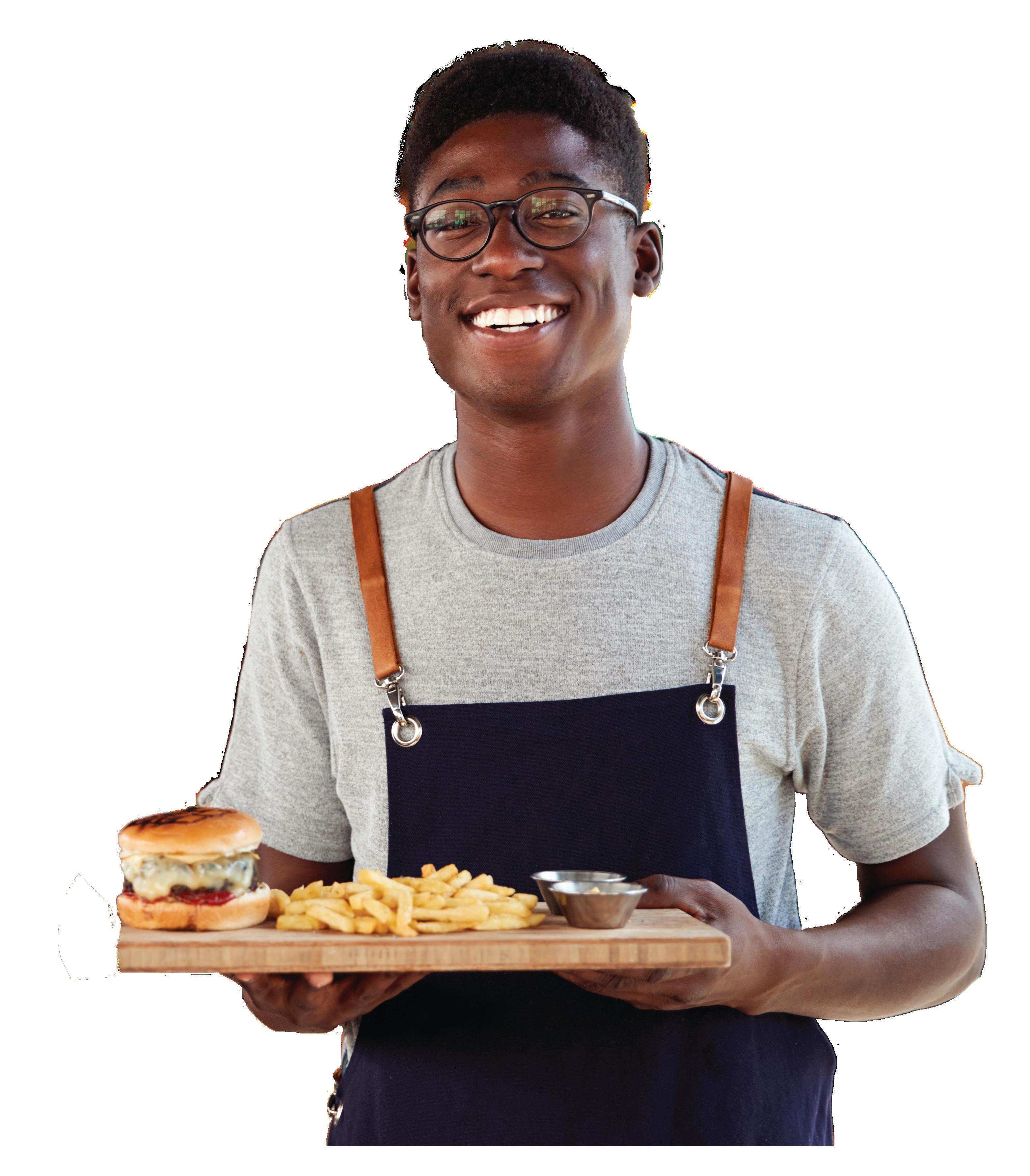

across the country. The brand will be available at more than 30 Gopuff Fresh Food Halls, which is equivalent to adding five to 10 franchise restaurants in terms of revenue and EBITDA.
Additionally, BurgerFi is working through a revamped loyalty program and more behindthe-scenes innovation around a new network stack, security, enterprise resource planning, inventory, and a human resources information system. As for what Goodhew thinks the future of restaurant technology will be, dynamic pricing appears to be on the horizon.
“The restaurant industry is a lot like retail in that there are fixed costs that must be endured no matter if you have customers or not,” Goodhew says. “It’s also a lot like hotels and flights in that there is a limited number of dining slots available for a given period. There may be incentive to eat a little bit earlier or a bit later to ease that rush. There may be incentives placed to order in a typical lull to drive demand. Dynamic pricing is not something the customer is used to in a restaurant so careful testing is needed to ensure there’s little downside.”
Hope Neiman
Tillster
CMO
Before Hope Neiman joined Tillster, a company that provides quick-serves with digital tools like mobile and online ordering, kiosk ordering, coupon and loyalty programs, delivery in-restaurant solutions, and messaging, she worked in ecommerce for large companies and digital-only brands. She saw how much opportunity there was in the restaurant industry for the introduction of more solutions, though many were hesitant to implement technology into their businesses. Now, restaurants have had to embrace innovation in order to keep up with the consumer and their competition.
“I could see how ripe the restaurant space was for a digital transformation and I really wanted to be part of it, as my career has been built on using technology to change consumer behavior,” Neiman says.

Neiman adds one technology innovation people need to talk about more is better integration across tool sets.
“On the consumer side, this means starting with a customer data platform across all components,” she says. “But there is a lot of integrated back office technology that is easy to use, integrate, and requires limited skill sets that are really the next frontier.”
Tony Smith Restaurant365 COFOUNDER AND CEO
Tony Smith loves to solve problems and has done so for many businesses throughout his career using software. This interest drew he and his cofounders to a largely underserved and fragmented market—the restaurant industry. When his group learned of the difficulties faced by operators and the complexities of different software solutions only meeting partial needs, they sought to create a unified answer. That was the genesis of Restaurant365, an all-in-one cloud-based accounting, inventory, scheduling, payroll, and HR solution developed specifically for restaurants. Customers run the gamut—major franchise brands, enterprise restaurant groups, multi-location groups, small businesses, and accounting firms in the industry.
“Over the years, the industry’s pain points continue to change based on market conditions and outside factors,” Smith says. “While I loathe to hear about operators facing difficulties, that always provides us an opportunity to continually evolve our solution and solve more problems for this industry I’ve grown a deep love for.”
Restaurant365 invests heavily into research and development to continually release new innovations. These efforts are informed by customers’ needs and the industry’s overall evolution. Human resources management appears to be the most common pain point, which is why the company is working toward expanding its payroll solution, driving food cost improvement, and providing better communication between workers and managers. This includes a new Mobile Manager Logbook, which allows managers to keep a digital record of customer concerns, personnel issues, vendor mishaps, and other impactful events.
Sam Zietz GRUBBRR CEO


Sam Zietz helms
GRUBBRR, a selfordering technologies company focused on automating commerce, which includes kiosks, smart lockers, kitchen display systems, order progress boards, digital menu signage, mobile ordering, online ordering, and more. Zietz also leads TouchSuite, a payment processing company he founded nearly 20 years ago. His work with TouchSuite certainly had connections to the restaurant industry with its involvement in credit card processing, commerce solutions, and POS. He noticed the shift toward mobile and kiosk ordering and, four years ago, looked into getting into the sector because of it.
He met GRUBBRR founder Bhavin Asher, who also saw this shift in ordering technology, and became CEO and majority owner of the company. Zietz focused on developing the company and its products as well as making strategic partnerships, including a partnership with Samsung.
COVID-19 popularized self-ordering technology much quicker than Zietz once thought feasible, bringing GRUBBRR’s suite of options to the forefront of the industry’s response.
Zietz says the next battleground will be customer personalization, AI forecasting, using automation to integrate front and back-ofhouse operations, and gathering and reporting data in real time.
GRUBBRR is working on conversational AI-based voice ordering for different channels. It is using a machine learning process called deep learning that uses a structure resembling the human brain to process data.
“One of the biggest issues with AI ordering is that it lacks a human touch: it cannot always accurately pick up on the idiosyncrasies contained in regular human speech,” Zietz says. “This is the next iteration of AI ordering software.”
Brendan Sweeney Popmenu CEO AND COFOUNDER
The idea for Popmenu wasn’t born from a complicated place. Brendan Sweeney, with a background in internet product development, user experience, and marketing, had a clear observation: marketing a restaurant with a
TILLSTER
RESTAURANT365
34 DECEMBER 2022 | QSR | www.qsrmagazine.com DIGITAL INNOVATION
GRUBBRR
text menu was just not the right way to put your best foot forward in a digital world rife with expectations, he says.
So Popmenu created interactive menus to serve as modern day ecommerce funnels with multiple ways for guests to engage. They feature criteria like photos, reviews, ratings, and social validation. “We treat each dish as a separate, indexed page for search engines like Google, so there is more relevant content to consider for queries such as ‘restaurants near me,’” Sweeney says. “This significantly increases traffic to the website and that traffic converts to sales at a higher rate because of the interactive elements. And because we capture guest data and preferences throughout our funnel, restaurants can automatically remarket to them with ongoing engagement plays to keep them coming back.”
Popmenu’s offering is core to its all-inone, guest-facing platform that includes digital marketing solutions with website design/ hosting and online ordering and delivery. Additionally, there’s AI phone answering with customer responses and other solutions, such as streamlining third-party delivery orders. “The platform is built specifically for restaurants. It was made to fit into their world, not the other way around,” Sweeney says.
Popmenu currently provides services to more than 10,000 restaurants. And it’s an origin story that traces back to Europe.
Sweeney was organizing an event in Paris when he noticed the restaurants they were considering all had PDF menus.
“I kept wondering why a business that is focused on taste, smell and ambiance is using text to showcase its product,” he says. Popmenu’s first-party, first-of-its-kind platform launched in December 2016. Since, Sweeney says, the company has seen more restaurants take a retail approach to marketing—a reality you can blame Amazon for. The ecommerce giant changed the game for how people make purchasing decisions. They expect photos, rich descriptions, reviews, and recommendations. “Amazon gets you to keep buying because they know everything about your searches and purchasing behavior on the site. Restaurants are bringing those same principles to the hospitality experience and it’s paying off for them,” he says.
When COVID hit, restaurant tech adoption skyrocketed. Sweeney says the industry essentially witnessed “10 years of tech adoption within 10 weeks.”
“Agility comes from willingness,” he says.
Much of that now revolves around understanding consumer behavior and meeting it head-on. It’s a process, Sweeney believes, that starts from an elemental level. “I’ve often said that the difference between restaurants getting by and blowing the competition away is the answer to one simple question: ‘How well do you know your customer?’” he says. “What you serve, how you serve, how you
market, how you build relationships all becomes smarter and better the more you know your customer. Getting a centralized view of customer preference data is going to be even more critical going forward as restaurants compete digitally. As mentioned, guests have been trained by sites like Amazon to expect— and demand—experiences that are tailored for them. That includes when they make dining decisions.”
“It is extremely difficult to design tailored marketing outreach when your guest data is scattered across different systems that don’t talk to each other and are not intuitive,” Sweeney continues. “Building customer preference profiles requires consolidation, needs to be on autopilot and needs to be optimized all the time.”
Aman Narang
Toast COFOUNDER AND PRESIDENT
here, he adds, is to talk more about how tech is helping power personalization. “Which at restaurants can actually mean a better hospitality experience,” Narang says. “Some guests experience hospitality as engaging directly with a server who might be holding a handheld device, for example, while for another guest the desired experience is about an entirely digital, contactless interaction.”

“It’s incredible to think about the possibilities with personalization,” he continues. “Imagine a world where you walk into a restaurant and the staff greets you by name, knows your food preferences and what you’d like to see on a menu—including elements such as allergy modifications—and you simply walk out of the restaurant when you’re done because the restaurant has your preferred payment method. Toast helps enable all of this to be a reality.”
Mary Melvin Checkers and Rally’s DIRECTOR OF RESTAURANT TECHNOLOGY
Mary Melvin has been with the classic chain for three years, and was initially brought on to help with the development of its new restaurants’ IT initiatives. That involved bringing together all of Checkers and Rally’s partners to coordinate the installation of new systems.

You could say restaurants found Aman Narang—it wasn’t the other way around. Along with Steve Fredette and Jonathan Grimm, the trio often parked at a local eatery after work to sort through potential ideas. Soon, they had their “aha moment.”
“We realized there was a huge opportunity right in front of our eyes to help restaurants,” Narang says.
When they founded Toast, the idea of an integrated experience was nowhere near where it is today. In the last decade, operators have seen point solutions expand, integrations abound, and the idea of an end-to-end solution as a possibility crystalize into view. Toast’s North Star has continued to target the latter, which is to create an all-in-one platform that enables restaurants of all sizes to run. “Combined with our partner ecosystem, we continue to innovate to help our customers stay focused on delivering hospitality—not trying to be CTO,” Narang says.
Where Toast—and the industry—goes from
Melvin began her restaurant career as a cashier at Olive Garden. During that time, the company switched out its POS, and Melvin excelled at using it. Olive Garden then recruited her to work on the help desk for the new system, and she has stayed in the field since.
“I got my foot in the door and I never looked back,” Melvin says.
Checkers and Rally’s has been implementing AI-powered drive-thrus with voice ordering since August 2021. The AI recognizes when a car pulls up to order their food and takes the car’s order, leaving the cashier to bag food and hand it off once a guest reaches the window. This takes a lot of the stress off the employee, Melvin says.
The initial pilot last August included 10 restaurants, but the company has since expanded that to 75 as of mid-August. This leaves Checkers and Rally’s with 150 corporate restaurants to bring the technology to, though some franchisees are also getting in the mix.
Melvin says that along with easing the burden of cashiers, AI-voice ordering is improving speed of service. There’s no wait time when the guest pulls up to order and the AI knows every ingredient and menu item.
TOAST
www.qsrmagazine.com | QSR | DECEMBER 2022 35 DIGITAL INNOVATION
RALLY’S
“It’s great because the responses are immediate and it can answer questions and free up that cashier’s time,” Melvin says. We are seeing some really good changes in our speed of service at the menuboard, so that’s really exciting. “While the company has been successful using this AI technology in a customer-facing way via the drive-thru, Melvin says the future may be in using that same kind of innovation in the back-of-house to help employees manage things like adding items to orders or checking the temperature of the freezer.
For now, the brand is looking toward taking its restaurant of the future model up a notch. This could unfold as technology to be able to recognize certain cars when they come through the drive-thru in order to be able to remember their order and identify if they are a loyalty member. This vision of a technologycentered restaurant also includes digital menuboards where customers can see their orders in front of them.
“Right now, what we’re doing is taking a look at the architecture that needs to be in place to support some of these innovations,” Melvin says.
Jessica Valenzuela GoGoGuest CEO/COFOUNDER
launch consumer brands in local and international products. She started GoGoGuest as a way to help coffee shops get more value from customers using their WiFi without buying much product. Then, the company pivoted to focus on a guest engagement platform for restaurants.
“As buying habits shifted dramatically into the online space during the pandemic, we began helping restaurants leverage their already rich tech stacks into actionable insights for marketing and operations,” Valenzuela says.
Customer value management, or CVM, is something businesses are starting to pay attention to, she says. Valenzuela notes CVM is “the process of aligning the product with sales, marketing, and ongoing success with the customer to expand revenue.”

GoGoGuest is tapping into using CVM to help customers. This means building a restaurant guest engagement platform that uses analytics and works with cloud POS, omnichannel payment platforms, reservation systems, and customer feedback platforms.
“We make it easy for restauranteurs to differentiate the value of their brand with the right data, customer analytics, and insights without the need for a data engineer, data analyst, or a costly technology custom development project,” Valenzuela says.
Angela Diffly Restaurant Technology Network COFOUNDER
The Restaurant Technology Network came to life in July 2018. Diffly created the membership community to bring together tech executives, from operators to suppliers, academics, and consultants, to foster innovation. Members collaborate via working groups to create and disseminate technical guidance, best practices, and industry standards, and RTN also hosts various networking events throughout the year, including Town Hall and partner-focused events. Perhaps most notably, RTN nurtures new restaurant tech talent via Start-Up Alley, held annually at MURTEC.
ghost kitchens, dark kitchens, automats, virtual brands, and celebrity brands, AI/ML in every facet of the operation, native/delivery-as-aservice, third-party, drone, robotic delivery, marketplace mayhem, kitchen robotics, robot hosts, servers, and so much more,” she says. “The real question is what hasn’t changed? The one consistent driver is technology. And I believe restaurants are waking up to what’s possible with technology in the driver’s seat.”
It’s a future rife with possibilities, Diffly adds. New generations are often more comfortable with tech than people. “And they want what they want, whenever and however they want it,” she says. “I believe the quick-service restaurant is prime for radical evolution. Even faster food—in whatever shape that can take— will be table stakes.”
Diffly suggests envisioning a category with AI-centric hyper-automation, whereby people are not present at all to serve, and also via newly imagined drive-thru experiences, like Taco Bell’s Defy, but taken up a notch. “The combination of digitally native consumers paired with smart tech innovation will put a whole new spin on fast food, and the quick-serve as we know it will become as nostalgic as the elusive Hamburgler hiding out on eBay today.”
“Restaurants are hungry for technology standardization,” she continues. “We are climbing the mountain every day, creating brick-by-brick standards to help restaurants move quickly when it comes to integrating technologies.”
Zhong Xu
Deliverect CEO AND COFOUNDER
GoGoGuest is a restaurant guest engagement platform that leans on customer analytics and AI. It first launched guest WiFi marketing in 2016 and has since evolved to help restaurants have access to data and to give them insights into the right marketing and operations steps.
Valenzuela has a long history of working in the space. She clocked time in a restaurant during college and grew up around the eatery her mom co-owned and managed. After college, Valenzuela held in-person and digital product marketing roles, helping activate and
“As co-founder of RTN, I steer the membership community’s overall direction, keep my finger on the pulse of restaurant tech trends, utilize my platform to spotlight innovative voices, and connect people who need connecting,” she says.
Before RTN, Diffly was closely tied to tech in editorial and corporate communications roles, as well as a “few sideline entrepreneurial adventures.” And like all of the disruptors on this list, her years of experience and know-how rocketed to the surface when the pandemic hit. Diffly says COVID changed the definition of what a restaurant is, and operators had to respond. “We have cloud kitchens,
Zhong Xu began his career in software engineering and eventually combined this experience with his passion for the restaurant industry. The latter came from his father, who migrated from China to Europe in the 1980s and worked in restaurants to make money. Xu’s father was also an engineer and learned the difficulties restaurants had firsthand. He started a POS for Asian restaurants in Belgium that he still runs today.

“My father’s trajectory and ethos not only inspired me to work in the hospitality industry, but gave me an understanding of the importance of the ‘why’ behind building a business,” Xu says.
Xu’s Deliverect is a software company that helps simplify the management of online
36 DECEMBER 2022 | QSR | www.qsrmagazine.com DIGITAL INNOVATION
GOGOGUEST CJ VARELA DELIVERECT


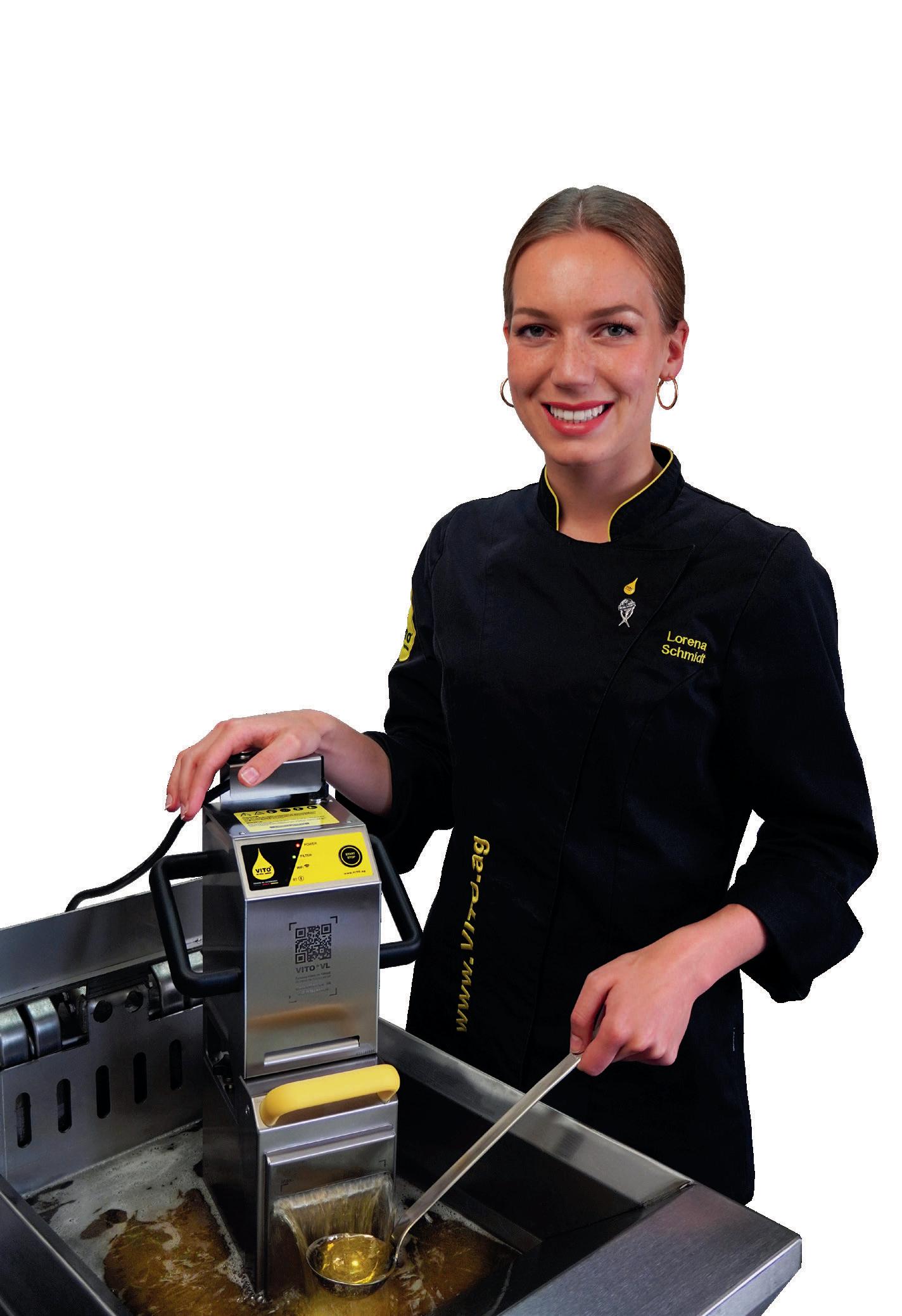


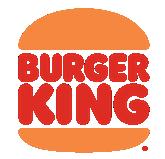










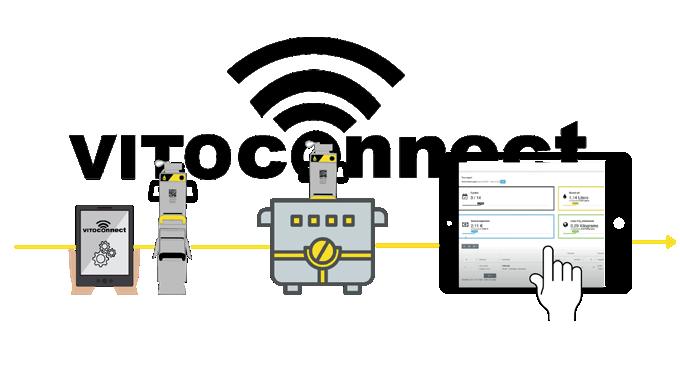
VITO Fryfilter, Inc. 847-859-0398 | info@vitofryfilter.com | www.vitofryfilter.com Award winning filter system proven by over 50,000 satisfied customers
food delivery. It combines online orders from different delivery providers in order to allow restaurants to improve services and customer satisfaction. Automation and AI technology to help improve day-to-day operations is the future of the business, Xu says. He also notes that using smart technology like robots and drones for the distribution of food from warehouses and virtual kitchens is also becoming more popular. “In 2023 and beyond, we’ll see continued momentum for this smart device explosion, including increasing use of intelligent delivery robots and drones,” Xu says. “Additionally, we expect ghost kitchens to continue in popularity as the industry continues to seek efficiencies and grapple with staffing shortages.”
Denny Marie Post
Nextbite CO-PRESIDENT
Post brought starpower to Nextbite when she joined the company as co-president in May. The former Red Robin CEO, who also held leadership roles at Starbucks, KFC, and Burger King in her career, had served as an adviser to Nextbite since September 2021. She had a front-row seat to a burgeoning movement that’s begun to settle into something lasting. Nextbite helps operators enter the virtual restaurant space with its delivery-only menus. Post oversees marketing, operations, and culinary innovation along with providing a strategic focus with Nextbite’s restaurant fulfillment partners. “I chose to join Nextbite because I see a tremendous opportunity to re-imagine the future of the restaurant industry to derive maximum return from existing brick-andmortar assets,” she says. “There is so much upside potential to be realized.” Post has been in the industry since joining KFC in 1995. Back then, in-restaurant technology consisted of POS systems and the most innovative thing was a digital menuboard. Off-premises? Call-ahead takeout was about as far as that went.

“So much has happened in the intervening three decades and much more rapidly in the last 5–7 years,” Post says. “Consumer adoption of digital tools in restaurant and at home, driven in part by the contactless pandemic demand, has picked up tremendous momentum and has highlighted multiple gaps in restaurants’ ability to fulfill.”
Alex Canter, Nextbite’s CEO, founded Ordermark (which would change its name to

Nextbite in November 2021), to address the challenges of managing orders from multiple delivery services for independent restaurants—like his family’s famed Canter’s Deli— that lacked the ability to integrate into POS.
“The biggest changes? Consumer digital adoption, operator engagement, and true and evident ROI for investment in technology,” Post says what’s taken place across the pandemic. “We just completed 45 hours of in-home ethnographic interviews on food delivery. The in-home business has an unlimited future with consumer expectations for seamless and informative digital engagement growing daily. We must continue to set the bar for UX higher and higher.”
Going forward, Post expects the industry to see an increased interest in harnessing data gathered from customers to create a better experience, including higher guest return rates and satisfaction. “This needs to be truly dynamic, daily input to maximize the opportunity,” Post says. “Monthly look-back reporting is no longer sufficient.”
Markus Sturm
Tim Hortons SVP, DIGITAL
Tim Hortons’ market share positioning in Canada is enviable, to put it lightly. The brand sells seven out of every 10 coffees. That makes its digital footprint and ability to engage with one of the industry’s most fervent fanbases a job that’s also difficult to rival. “I consider myself incredibly lucky; I have one of the best jobs in Canada,” Markus Sturm says.
The brand’s digital leader has spent eight years in the sector. Tech adoption, both by consumers and operators, has rocketed through that stretch. On the former, Sturm says, smartphone adoption stirred a proliferation of restaurant apps. And in turn, how brands position them. “Initially, most restaurant apps were focused on functional benefits such as lineskipping via mobile ordering or earning and redeeming loyalty points or digital coupons,” he says. “But those functional features have now become table stakes, and restaurants are competing for a deeper, more emotional digital relationship with their guests.”
From the operations side, it’s been a race to provide experience for customers and workers alike. Newer service models, such as drive-thru, mobile ordering, and delivery, were all heightened throughout COVID. Meanwhile, the labor market tightened and
restaurant complexities increased to meet guests’ growing tastes. “We believe the pace of change will only accelerate, which is why Tim Hortons is highly focused on building, testing, and adopting digital technologies— both consumer-facing and at the restaurant level,” Sturm says. “At Tims, we and our franchise restaurant owners are embracing a bold digital mindset across every department and in practicality, everything we do. This includes, among countless other examples, an even greater focus on: advertising on digital/ social media in our marketing department, testing new back-of-house technologies to improve operations, and designing and evolving our restaurants in ways that encourage digital guest adoption.”
In particular, Sturm is interested in the notion many retail consumer companies today derive a portion of revenues from “non-core” digital services. These have become easier and more cost efficient for consumer brands to integrate into their digital ecosystems. In large part, it’s a trend that owes to cloud technologies and “infrastructure as service” providers. Think Uber. It started as a ride-hailing or delivery company and has expanded to offer other digital services within its ecosystem. “Those additional services now represent an impressive portion of their businesses,” Sturm says. “And for good reason: they have large and highly-engaged captive audiences and they can tailor their digital products to seamlessly integrate into their ‘core’ business models. I believe large consumer brands might increasingly extend their digital guest relationships and app ecosystems to offer additive products and services to power their core business.”
Digital currently represents roughly a third of overall sales at Tim Hortons in Canada. The chain boasts the largest monthly active app user base (it also has the highest app usage frequency) within the F&B industry in the country—even higher than third-party delivery aggregators.
For perspective, about 11 percent of the entire Canadian population uses the Tim Hortons app at least once per month. Sturm says, in part, the success is a reflection of engaging experiences the brand added over the past two years, like fully digitizing its Roll Up To Win campaign and launching the Tim Hortons NHL Hockey Challenge. Additionally, it integrated community-oriented features in its loyalty offering, like “Round Up,” which allows users to instantly benefit the Tim Hortons Foundation Camps. A more recent example is “Scan & Pay,” where guests can earn/redeem rewards points in a single scan. “This will help save time at the counter or drive-thru window because guests can scan for Tims Rewards and provide payment in one simple step,” Sturm says. “This is a massively impactful feature; we anticipate it will cut current loyalty payment times in half.' q
38 DECEMBER2022 | QSR | www.qsrmagazine.com DIGITAL INNOVATION NEXTBITE TIM HORTONS
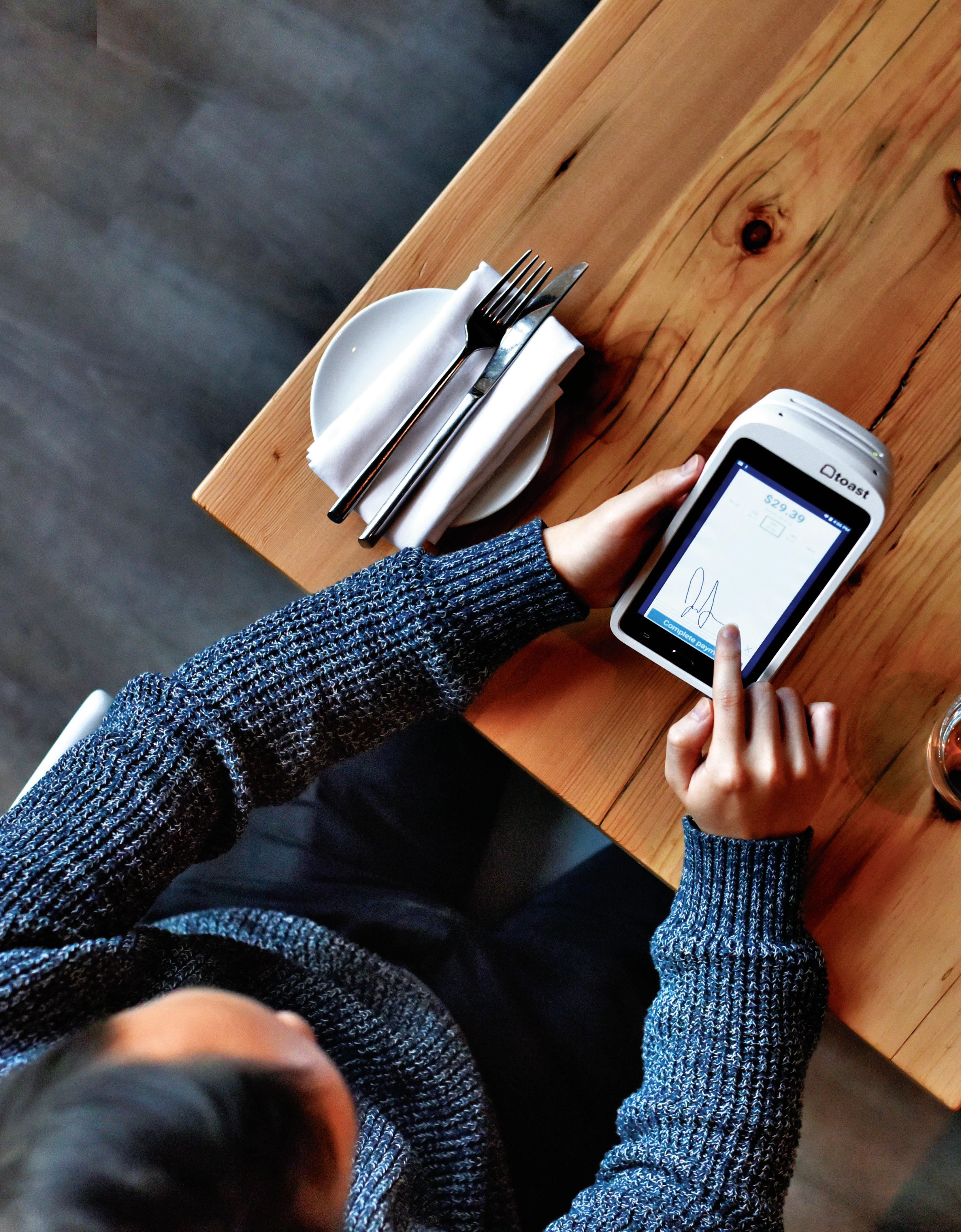

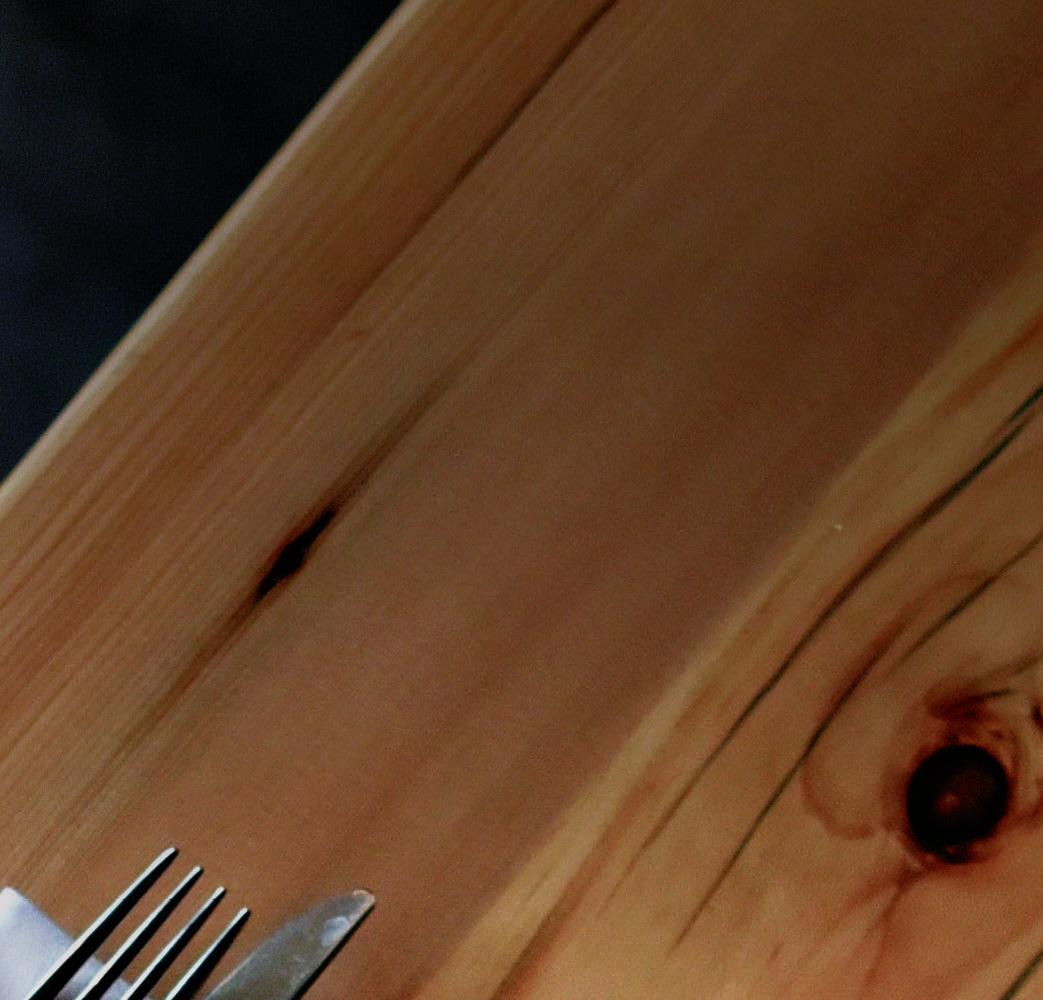




















SmartChain / N E W P R O D U C T S ® Do More with Less P. 40 Modern Tech P. 46 The Ideal POS P. 50 Key Players P. 56 DECEMBER 2022 Smart V E D O R O U N Consumers and the back office need more, and point-of-sale systems are innovating. THE POS REVOLUTION
TOAST SPONSORED SECTION | DECEMBER 2022 39
■ BY KARA PHELPS
Doing More with Less
Advanced POS systems can be the key to maximizing resources.

In one way or another, restaurant operators’ profit margins and operational efficiencies have always been under siege—but the last couple of years have been unlike anything the industry has ever seen.
While foodservice and drinking establishments added 60,000 jobs in September, according to the U.S. Bureau of Labor Statistics, the hospitality sector still lags about 500,000 jobs behind preCOVID employment levels. A report from Alignable showed that seasonal hiring in the restaurant industry is down significantly this year.
Consumers are also changing the ways they prefer to order and eat, which upends predictability and adds complexity to operations—especially with a short staff. “The
ongoing impact of the pandemic has perhaps forever changed customer ordering and dining preferences ranging from traditional counter orders to an often-unpredictable mix of counter order, drive-thru order, self-order, remote order to eat-in, takeout, and delivery orders,” says Doyle Ledford, senior vice president at Posiflex.
Meanwhile, inflation and rising food costs continue to wreak havoc. Sales data gathered by Lightspeed from nearly 6,000 U.S. hospitality merchants showed that while inflation rose 8.26 percent on a yearover-year basis in August 2022, menu prices have only increased 5.56 percent on
SmartChain POS Solutions
POSIFLEX
“The ongoing impact of the pandemic has perhaps forever changed customer ordering and dining preferences.”
40 DECEMBER 2022 | SPONSORED SECTION
Posiflex
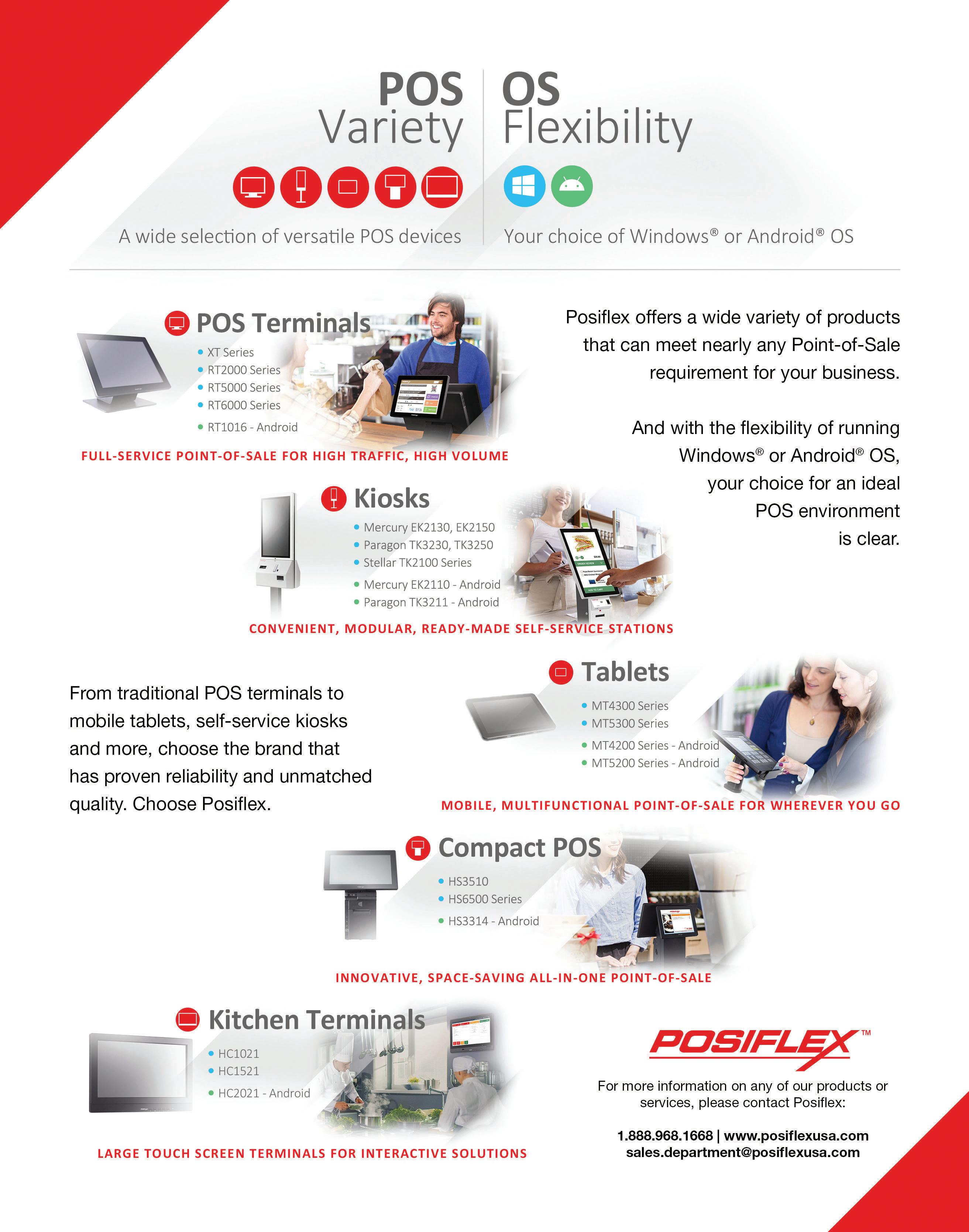
SmartChain POS Solutions
average over the same period. At the same time, food costs are pacing ahead of inflation. “When adjusting for inflation, this means margins for restaurants are going down,” says Sara Basdeo, communications specialist for Lightspeed.
These challenges obviously add up. “From labor shortages to shrinking margins to the explosion of ordering, payment, and delivery choices, restaurants are facing and embracing the tough realities of today’s operating environment,” says Jessica Bryant, vice president of marketing for NCR Aloha.
How are restaurant brands managing increased complexity and doing more with less in today’s environment? And most importantly, how are they continuing to exceed customer expectations and turn a profit?
The right technology, implemented properly, can help save time and money. “Point-of-sale solutions can help restaurant operators address these challenges by providing an all-in-one system that simplifies the day-to-day operations of a restaurant, streamlines back-office tasks via the POS platform, and ultimately helps the business owner operate more efficiently,” says Ann Cave for Clover
Contemporary POS solutions go beyond the traditional systems for recording transactions to cover every facet of restaurant operations—front and back of house. They can automate time-consuming or menial tasks, and they can minimize the likelihood of human error. “If we look across the globe, Asia faced the same challenges much earlier than we have and found automation technology to be an exceptional solution,” says Rajat Suri, CEO of Presto. “Next-gen automation technology has become more prevalent for POS and related solutions as operators realize they can reduce costs and optimize their labor efficiency.”
In the front of house, POS platforms are now designed to support restaurant staff with repetitive tasks like taking orders.
“Handheld POS devices and QR-codepowered mobile order-and-pay reduce wait times and increase the efficiency of front-of-house staff by making it easier for guests to order on their own terms,” says Kelly Esten, senior vice president and gen-
eral manager of enterprise at Toast.
This is a win for customers, who are now accustomed to having more control over their ordering experience from start to finish. Granting access to more options for ordering creates more opportunities to drive customer loyalty, and smart POS systems can manage all of this for staff. “It may seem obvious, but one way today’s POS solutions are helping restaurants maximize resources is by simply
making it easier for customers to order,” says David Werner, vice president of product marketing at HungerRush “With the right POS, restaurants can receive orders from all digital channels and third parties, routed seamlessly to the kitchen.”
Where the supply chain is concerned, a modern POS system can account for 86-ed items in real time, triggering adjustments across all digital menus—including thirdparty listings—so customers can’t pur-

LIGHTSPEED 42 DECEMBER 2022 | SPONSORED SECTION
Lightspeed
Unleash your team’s potential
Introducing the OneDine otg Tablet
Order • Pay • Engage
• Easy-to-read 7” screen
• EMV, NFC, and Processor Agnostic

• All-day battery with rapid charging tower
• Dual LTE Connectivity
• Eliminate trips between guest and register
• Interfaces with existing POS, Loyalty, Gift, and Processor

• Increase table turns, eliminate lines, and improve the guest experience
• Higher staff wages, tips, and retention
® Scan here or visit www.onedine.com to learn more
chase items that are unavailable. Data visualization also helps operators make quick decisions about product replacements for high-grossing items and stay ahead of reordering based on historical demand and forecasting. Operators can use this information to plan promotions or
minimize waste.
“When deployed correctly, the POS is the heart of the business. It’s central to all of the necessary functions, and it’s able to keep integrated systems operating at maximum efficiency for the business’s long-term health,” says Chris Lybeer, chief
strategy officer of Revel Systems.
Contemporary POS systems can help with day-to-day operations—and they can also set up brands for success as they grow over the years. “For restaurateurs who are looking to grow their business, whether it be new brick-and-mortar locations, franchise models, ghost kitchens, or other virtual brands, it’s important to ask
questions about a POS provider’s ability to scale from a single location to multiple sites,” says Amber Trendell, senior director of strategy at Oracle Food and Beverage.
“A scalable POS solution saves operators valuable time and money, as they will not have to scavenge for the right integrations, because they are already in place,” says Savneet Singh, CEO of PAR Technology “A scalable POS solution ensures brand operators do not need to pay for new technologies that integrate with their new advanced POS.”
Of course, POS systems are more than just software applications. They also need devices like ordering kiosks or handhelds to fulfill many of their functions. Proprietary hardware can become more difficult—and expensive—to repair and replace over time. POS hardware that uses common or shared components, accommodates standard USB connections, and supports primary operating systems, such as Windows, Android, and Linux can help maximize long-term returns on investment. “Focus on shared services and standard hardware that uses shared or off-the-shelf components as much as possible to simplify the overall environment, shorten deployment times, and lower long-term support costs,” says Eric Symon, vice president, hospitality industry at Panasonic Connect of North America.
Saving time and money has never been tougher or more critical for restaurants. Modern POS solutions help simplify operations, arming restaurants with the tools to navigate today’s environment. SC

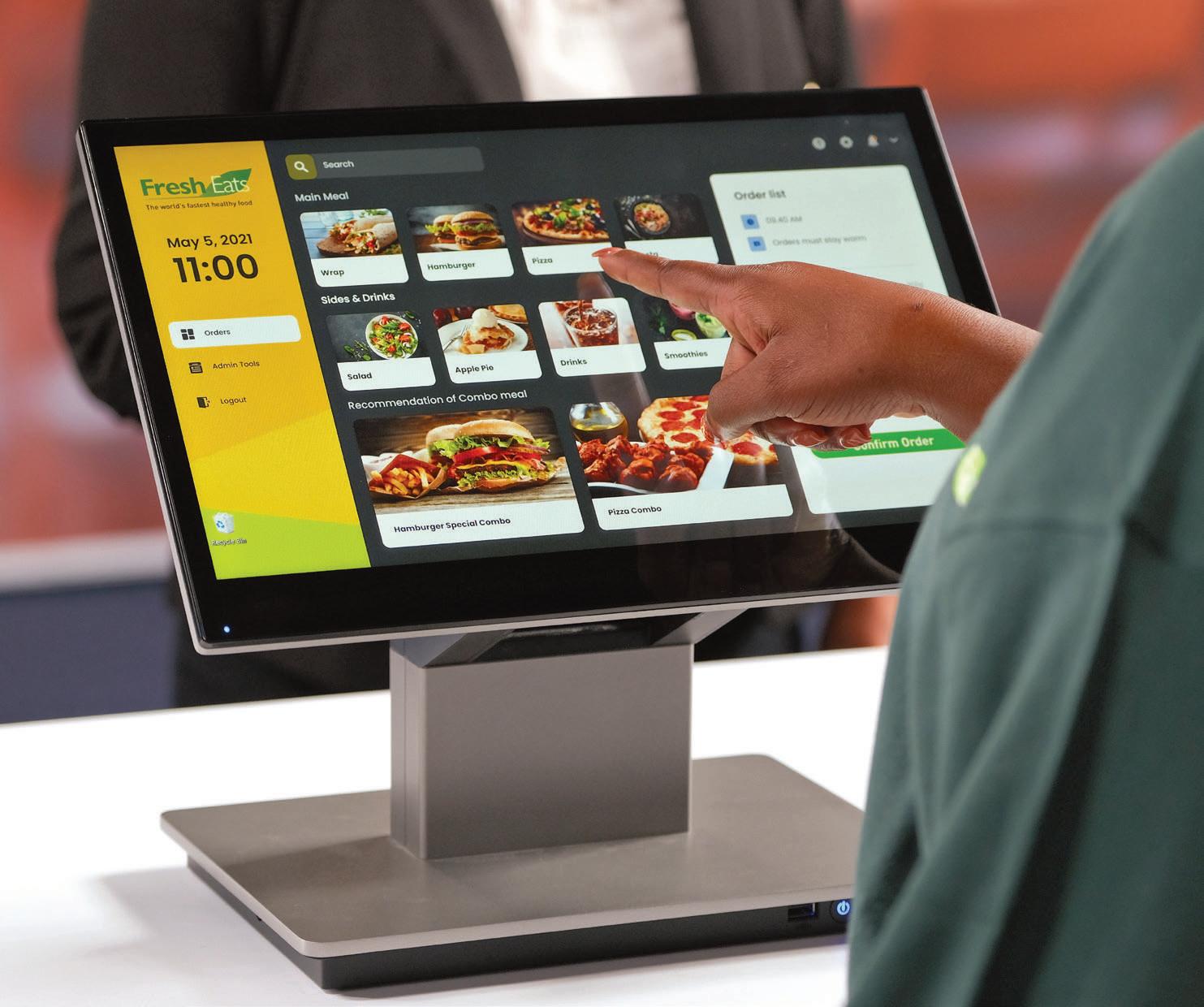
POS
SmartChain
Solutions
Panasonic Connect
“A scalable POS solution saves operators valuable time and money.”
NCR Aloha
44 DECEMBER 2022 | SPONSORED SECTION
NCR ALOHA PANASONIC CONNECT

The Modernized POS
Not just for counter service anymore, POS systems now power entire brands.
The point-of-sale system has long since evolved beyond its humble beginnings as a vehicle for handling transactions. Today’s POS systems are allin-one solutions that touch every part of a restaurant’s business strategy. They link the digital world with the physical and serve as the driving force behind most— indeed, if not all—daily operations.
“As technology has advanced, POS solutions have evolved from transactional devices for payment acceptance to fullfledged business management systems,” says Ann Cave for Clover “While payment acceptance and payment security remain foundational to ‘point-of-sale’ interactions, wherever that point may be, contemporary POS devices are helping business owners connect their physical and digital presence, improve how they engage with customers, and simplify the day-to-day life of a business owner by streamlining backoffice operations.”
One of the most significant advancements in POS solutions was the addition of cloud-based services. The cloud paved the way for mobile ordering and POS software-as-a-service: Restaurant operators can now access their POS software on any device with an internet connection. “This has made kiosk technology relevant and available, increasing a brand’s speed of service and improving its CX strategy,” says Savneet Singh, CEO of PAR Technology
With kiosks and other cloud-enabled ordering technology, restaurants can stay flexible, shifting easily between service models on the fly. “Whether that means using handheld POS devices to line-bust, implementing mobile order-and-pay, or pivoting from POS terminal to kiosk, restaurants can choose the right service model for their guests at any given time
and check on inventory or sales without having to drive into the restaurant,” says David Werner, vice president of product marketing at HungerRush
without tech limitations,”
says Kelly Esten, senior vice president and general manager of enterprise at Toast
The cloud has also transformed the back office. Restaurant operators are finding that many of their tasks can be done remotely with a cloud-based POS.

“Operators can open a laptop from home
With the right capabilities or integrations, a contemporary cloud-enabled POS system can help operators with everything from menu engineering and staff planning to expanding locations and keeping up with growing demand. In fact, it’s safe to say the cloud is an essential part of doing business in today’s world.
“Cloud-based commerce is a ‘must-have’ to not only remain operational but capitalize on changing consumer behavior,” says Sara Basdeo, communications specialist for Lightspeed
The last two years have seen an explo-
SmartChain POS Solutions
“Operators can open a laptop from home and check on inventory or sales without having to drive into the restaurant.”
46 DECEMBER 2022 | SPONSORED SECTION
Clover
CLOVER

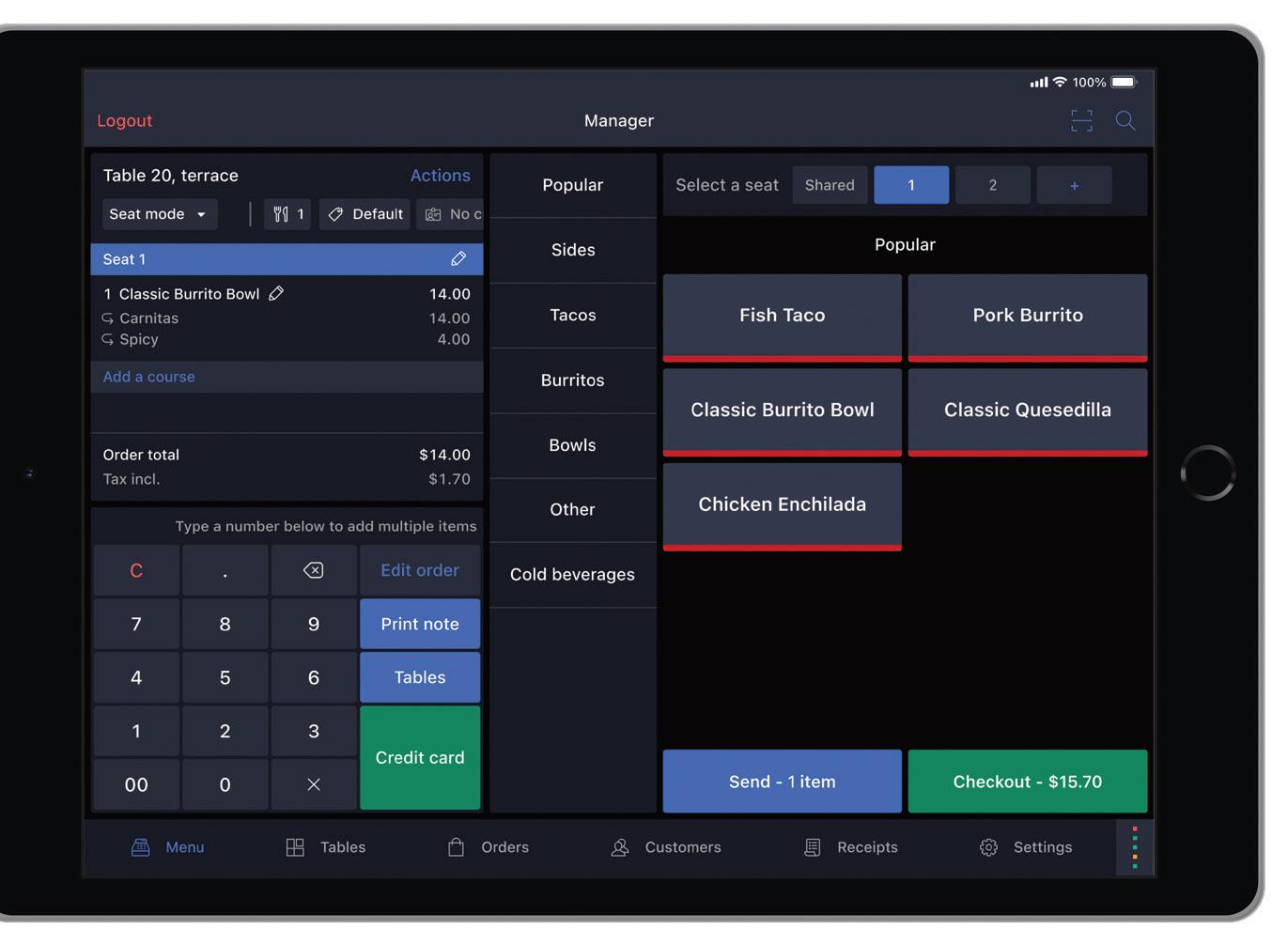
sion in online ordering, which has created an entirely new revenue stream for many restaurants. Customers want to be able to engage digitally, and restaurants have had to adapt. “Traditionally hospitality was a very manual business resistant to modernization,” Basdeo says. “The industry has been pushed to adopt new technology— technology that operators will need in the future and not just in this moment.”
Restaurant operators can now explore an invaluable trove of customer and operational data, gaining insights into how to enhance the customer experience and increase efficiency. Advanced POS systems can integrate with a wide variety of data-rich channels. “Brands should have access to all transactional and payment data via a single analytics dashboard so that restaurants can forecast revenue, profits, and cash flow accurately and in real time,” says Amber Trendell, senior director of strategy at Oracle Food and Beverage. “This can help restaurateurs make informed decisions and concentrate on their long-term business strategy.”
On the customer experience side, the increase in available data allows restaurant brands to craft distinctive, person-
alized journeys beginning even before a customer places an order. Operators can learn which high-margin items appeal the most to specific customers, for example, and they can offer tailored upsell opportunities whether that customer is online or at the counter. “Brands can move past generic guest experiences to ‘Amazon-like’ personalization and upsell capabilities in both physical and digital experiences,” says Jessica Bryant, vice president of marketing for NCR Aloha. “Imagine what type of loyalty a brand could drive if a cashier had access to loyalty profile data on the POS to surprise and delight guests based on their preferences.”
Other innovations in the POS space are arriving via artificial intelligence. “The POS can do things for restaurants that it could never do before,” Werner says. “For example, AI-driven phone bots can now answer the phones, take orders from customers, receive payment, and submit the orders directly to the kitchen—all while upselling every order and never making mistakes.” Voice-activated AI order-taking at the drive thru or self-service kiosk helps streamline the customer experience and frees up employees for less repetitive, more important tasks.
Through AI-adjacent technologies like machine learning and natural language processing, customers can even place an order online in a way that feels similar to the in-person experience they’re used to today. “AI can help restaurants to have intelligent, personalized guest interactions,” Trendell says.
AI can be a powerful component of a modern POS system. Not only does it help answer the consumer demand for seamless digital ordering—when combined with voice, vision, and touch technology, it can aid operators in brand-wide efforts to optimize efficiency. “AI voice technology works as a friendly 24/7 virtual assistant that accurately automates order-taking,” says Rajat Suri, CEO of Presto. “Vision technology integrates with existing restaurant cameras for real-time monitoring of vehicles, order assembly, or food levels. Touch technology—in the form of lightweight server tablets—tackles multiple use cases and helps ordering and payment for staff and guests to be more efficient.”
The pace of technological change is rapid in the POS space, and—just like in restaurants themselves—conditions shift constantly. “Not that long ago, traditional POS stations at the counter were the main— and sometimes only—game in town,” says Doyle Ledford, senior vice president at Posiflex. “The restaurant industry can undergo changes quickly. An operator must consider that anything can happen, and they should be prepared accordingly. That includes ensuring you have a solid POS solution that can adapt to the ever-changing requirements dictated by you, your customers, and the industry as a whole.” SC
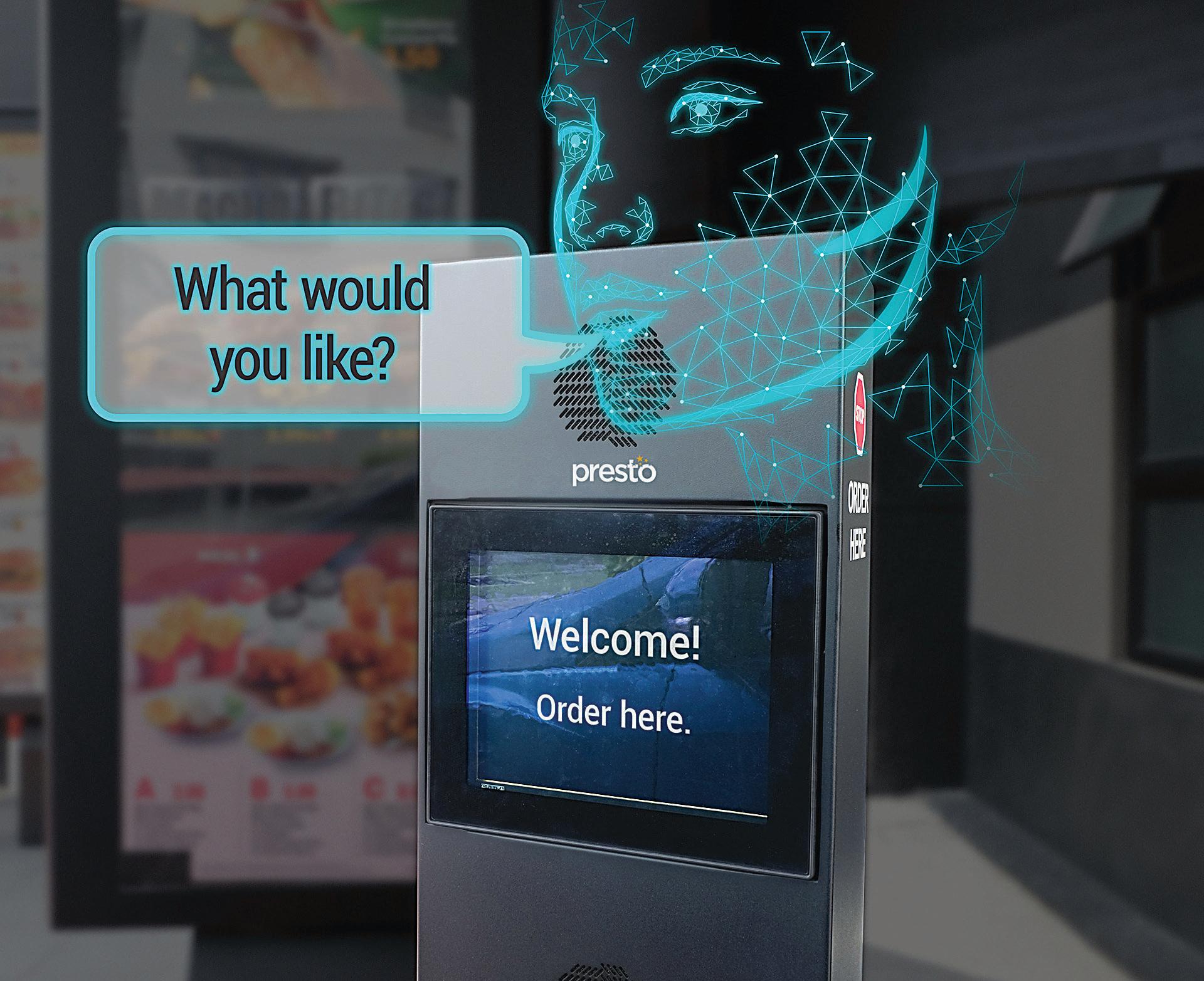
POS
SmartChain
Solutions
Presto
“Brands can move past generic guest experiences to ‘Amazonlike’ personalization and upsell capabilities in both physical and digital experiences.”
48 DECEMBER 2022 | SPONSORED SECTION
PRESTO










Voice Automation solves the labor shortage. Using a proven leader guarantees results. Presto Voice uses A.I. in the drive-thru to accurately take orders and upsell consistently. With over 95% order automation and the widest deployment, Presto is the clear leader in enterprise-grade drive-thru voice automation. presto.com/voice
Powerful POS Practices
What does it mean to have an ideal POS system?
The ways that consumers interact with restaurants have changed drastically in recent years. Consumers want their restaurant experiences to be even more convenient and fast, and they want simple, intuitive digital ordering. According to The NPD Group, digital ordering rose 117 percent from February 2020 through February 2022. Over the same period, delivery and drive-thru orders also grew while carry-out orders slightly declined. The study found that convenience was the key—and in today’s world, tech and convenience are linked. As operators adjust to consumers’ new demands, many are taking a second

look at the capabilities of their existing POS systems and considering upgrades. During COVID-19-related lockdowns, some operators added one-off solutions to their POS systems to satisfy consumers’ rapidly shifting concerns around ordering and picking up food in a safe, contactless manner. More than two years on, how-
ever, these quick fixes may not be playing nicely with other parts of the business— and operators may discover they need more holistic, connected answers.
“One of the biggest themes I hope restaurateurs take from this is that investing in the right technology stack for their business is perhaps more mission-critical than ever before,” says Chris Lybeer, chief strategy officer of Revel Systems “In order to avoid fragmented operations, operators need those solutions to fully integrate with their POS.”
Today’s advanced POS solutions are extensions of a brand’s staff. With sophisticated integrations, they can help with line-busting, omnichannel strategies, support for contactless payments, drive-thru services, inventory management, and data management, as well as other critical restaurant operations.
Operators relying on legacy POS solutions rather than upgrading may find the power to integrate and automate operations is out of their grasp. They risk increasing staff frustrations and even losing tech-savvy customers. “The problem with legacy POS solutions is they create ‘vendor spaghetti,’” says Savneet Singh, CEO of PAR Technology. “These outdated systems create nightmares for restaurant operators, turning a front-of-house station into an array of poorly managed cables and devices—ultimately increasing downtime and decreasing the brand’s speed of service, order accuracy, and most importantly, overall customer satisfaction.”
In fact, integrations are changing the definition of POS. “Restaurants shouldn’t limit themselves by the POS systems of the past—today’s systems can help grow your business across the board, with more insight, more understanding, and more
SmartChain POS Solutions
“Investing in the right technology stack is perhaps more missioncritical than ever before.”
50 DECEMBER 2022 | SPONSORED SECTION
Revel Systems REVEL SYSTEMS
Revel Enterprise is the Leading Cloud-Native Enterprise POS Platform Built for Today’s Restaurant

Revel Enterprise® is the leading cloud-native POS platform with a broad footprint of national, big brand restaurant implementations. Restaurants are transitioning to a hybrid business model and managing an increasingly disparate number of customer ordering channels. Revel Enterprise provides the flexibility required to easily manage this complexity to maximize profits, improve operations, and reduce risk.
For more information, visit revelsystems.com/enterprise
SmartChain POS Solutions
control of your operations and guest experiences,” says David Werner, vice president of product marketing at HungerRush. “The right POS system will be cloud-based and capable of scaling with business demand while ensuring all payments, reporting, and inventory are seamlessly integrated with all restaurant systems to inform marketing and loyalty strategy.”
POS systems that can integrate with business intelligence and transactions services give restaurant operators an advantage. “With the right integrations and technology stack in place, POS systems can help brands analyze and improve inventory utilization, demand planning, menu engineering, total cost of goods sold (COGS) inclusive of packaging, sales channel performance, staffing plans, and new KPIs associated with off-premises front- and back-of-house operations,” says Amber Trendell, senior director of strategy at Oracle Food and Beverage
POS hardware, too, must be able to work seamlessly with a range of devices and components. Hardware that supports modern POS solutions should be remotely accessible and have maximum uptime and reliability. “Speaking from a hardware perspective, an ideal POS solution is one that offers operators flexibility using shared components in multiple form factors, such as POS, kiosk, and so on, along with the ability to centrally manage and monitor devices and support the relevant operating systems,” says Eric Symon, vice president, hospitality industry at Panasonic Connect of North America.
In order for consumers to experience the high level of convenience they demand these days, it’s—of course— essential to have access to any given service in the first place. Reliability is critical for soft-
ware as well as equipment, and advanced POS systems can incorporate failsafe measures to minimize downtime. “There’s
nothing more harmful to a business than having its technology go down during the lunch rush due to an internet outage,” Lybeer says. “Selecting a POS that can take credit card payments while the system is disconnected from the internet is a great way to protect yourself from this type of situation.”
The modern POS opens up more possibilities for consumer interactions, and it streamlines restaurant operations. With an advanced POS system, operators can eliminate the need for a back-office server, offer safer and more convenient payment options, reduce inventory spending and space, redeem personalized coupons and offers, and create a seamless customer experience across all channels. “Advanced
POS solutions must be prepared to handle any situation that may arise in the restaurant to create a smooth front-of-house in one or all service locations,” Singh says.
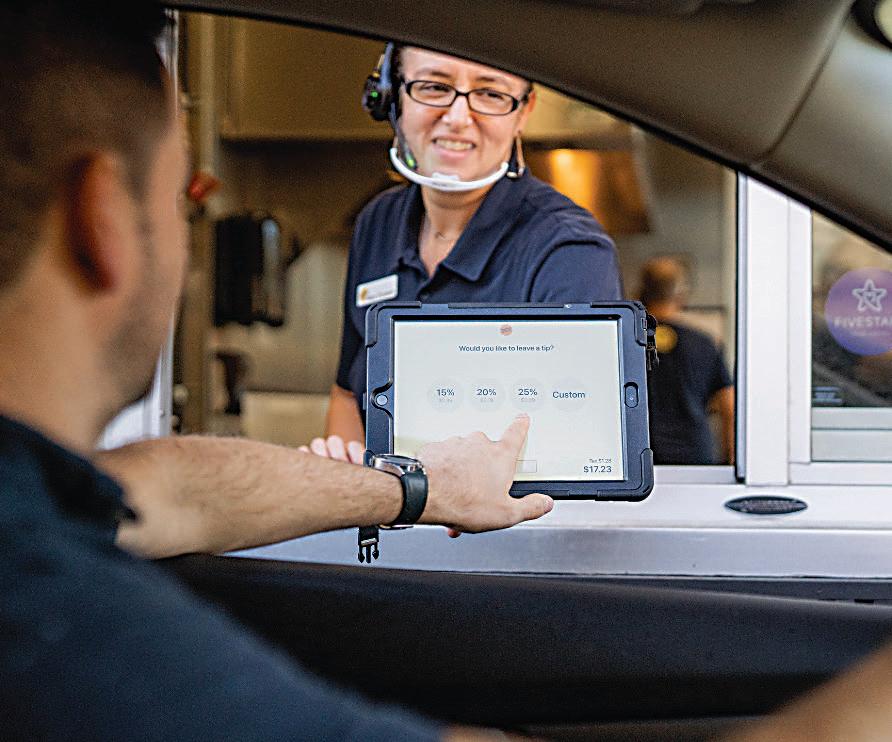

Front-of-house and back-of-house, today’s POS systems are designed to remove friction and frustration. “A modern POS should help restaurants do three critical things: delight, integrate, and inform,” says Kelly Esten, senior vice president and general manager of enterprise at Toast. “Delighting guests in today’s environment means implementing a POS that lets guests order, enjoy, and pay for food on their own terms. Integration means ensuring that a POS works well with the other platforms an operator may use and makes them more valuable in the process. Through native reporting capabilities and

“A modern POS should help restaurants do three critical things: delight, integrate, and inform.”
Revel Systems
Toast
Oracle Food and Beverage 52 DECEMBER 2022 | SPONSORED SECTION
REVEL SYSTEMS TOAST ORACLE FOOD AND BEVERAGE
Do More. Talk Less.
That’s the power of OrderAI Talk.




















Try It Yourself At pos.hungerrush.com/orderai The automated phone bot that answers your calls, takes orders by phone and SMS, receives payments, and sends personalized marketing messages to drive repeat orders. 18:30 Your Favorite Restaurant 01:15
the ability to export data to external business intelligence tools, a POS should make it easier for operators to transfer data between the tech platforms they use and generate useful insights.”
Every brand has unique goals, and the definition of the perfect POS will vary depending on each specific use case. Brands should weigh each POS solution’s capacity to address their operational pain points. Customizable solutions also offer flexibility when needs change. “I would encourage restaurant operators to consider the big picture of their operation, beyond just accepting payments, and evaluate a POS solution on its ability to enable the operator to run their business better,” says Ann Cave for Clover. “The technology needs of a retail store differ from that of a neigh-

borhood pizzeria. To that end, business owners should look for platforms that can be tailored to meet their specific needs.”
“No two restaurants are the same, and no two years in business are the same,” Lybeer says. “Monthly or quarterly product releases are a great example of a POS provider that understands the importance of consistently offering new features and enhancements to its clients to help them stay agile. An open API is also a powerful way to customize a POS to meet the exact needs of a growing operation, providing built-in innovation and agility.”
Other important considerations include both the consumer and employee experience. As consumers and employee expectations for ease of use get higher, their patience wanes. When combined with other frustrations like supply chain delays and staffing shortages, a streamlined user experience can go a long way— for consumers as well as employees. “How user-friendly is the application for new staff to rapidly onboard?” Trendell asks.
“How easy is it to configure upsell and cross-sell prompts? How extensible is the POS to accommodate brand-specific business logic and processes?”
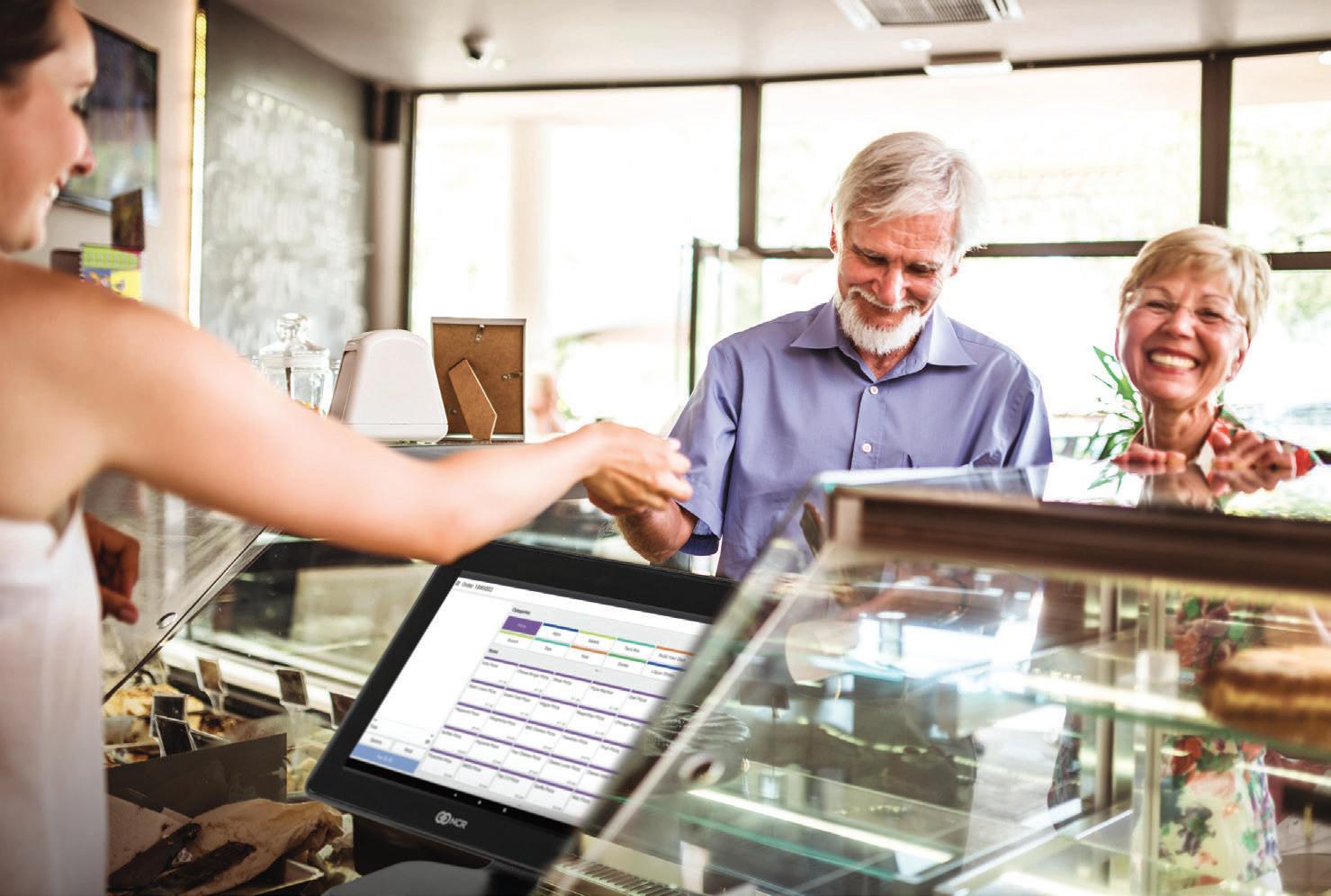
“A POS solution should have the capability to drive superior consumer and staff experiences by unifying transaction and guest data for a single view of the consumer that can be used to drive relevant, personalized offers and experiences,” says Jessica Bryant, vice president of marketing for NCR Aloha
In the coming years, POS systems will only continue to innovate, fine-tuning their capabilities and adding new ones. As operators seek to automate as much as possible to help with labor shortages and improve the employee experience, POS solutions will continue growing in power. “Many restaurant concepts have already integrated next-gen automation technologies, and about half of U.S. operators expect to deploy automation technology in the next two to three years,” says Rajat Suri, CEO of Presto. “Now is the time to upgrade your POS to improve operational efficiency, increase revenue, and stay ahead of the competition.”
It’s also important for operators to consider the longer-term implications of any solution they consider adopting—after all, the impact of the decision could resonate for many years to come. “When modernizing your technology, it’s about more than how POS is defined today,” Bryant says. “It’s about having a tech platform that unlocks new possibilities with a modern microservices architecture. The ideal solution powers modern business processes and enables a brand to match pace with consumer expectations using open APIs to create a digital ecosystem unique to the brand.”
Ultimately, the goal of any POS system is to support great guest interactions. “All the metrics the restaurant industry uses— table turn times, average tips, revenue per labor hour, return visits—are just ways of measuring human hospitality,” Esten says. “A modern restaurant technology stack allows brands to collect better data and plug in new technologies from the POS or partners to adapt to an environment where change happens faster than before.” SC
SmartChain POS Solutions
A streamlined user experience can go a long way—for consumers as well as employees.
NCR Aloha 54 DECEMBER 2022 | SPONSORED SECTION
Clover CLOVER
NCR ALOHA
The Future of Point of Sale is Here
The future is Xenial Cloud Point of Sale: the cloud-based restaurant management platform that is trusted by thousands of restaurants and top brands to help them operate efficiently.

KEY FEATURES
Give your employees everything they need to keep orders flowing and lines moving.
» Intuitive, app-like interface requires no special training

» Conversational ordering for fast, accurate order-taking
» Requires ZERO in-store servers – only a connection to the cloud to store your data securely












» Stays fully functional even when offline by sharing order data between devices as a backup and syncing with the cloud once online





» Centralized management control over every cash drawer
» Customizable configurations for order flow and destinations

» Automates end of day business processes
» Helps meet guests’ ever-changing demands with sophisticated pricing mechanisms and native third-party integrations
» Hardware and OS agnostic, compatible with Apple, Android and Windows






BENEFITS

» Reduce training time and labor cost
» Eliminate capital expenses and IT costs
» Ensure order accuracy at high volumes
» Keep orders flowing at the speed of conversation




» Reduce theft by tracking cash at all times
» Grow your business affordably
» Keep customers coming back for more
A Global Payments Company Contact us to discover how the Xenial Cloud POS can help drive revenue for your brand. www.xenial.com/products/pos-software sales@xenial.com
SmartChain Key players
Clover
415 N Mathilda Ave. Sunnyvale, CA 94085
855-294-3163
clover.com
Clover is an all-in-one business management system enabling SMBs to maximize their operating efficiencies and grow, while offering comprehensive and flexible payment methods. As a point-ofsale platform supporting hundreds of thousands of businesses globally, Clover processes over $234 billion in annualized payment volume.
HungerRush
1315 West Sam Houston Pkwy., Suite 100 Houston, TX 77043
877-738-7444
hungerrush.com
HungerRush is a Houston, Texas-based point of sale technology provider. HungerRush works to provide every restaurant with an easy-to-use, completely configurable holistic system to streamline operations, drive repeat business, and put control back in the hands of restaurant operators.


Lightspeed
700 St-Antoine Est, Suite 300
Montreal, Quebec, Canada H2Y 1A6
866-932-1801
lightspeedhq.com
Powering the businesses that are the backbone of the global economy, Lightspeed’s one-stop platform helps restaurant owners simplify, scale and provide exceptional customer experiences. The cloud solution unifies online and physical operations, lets restaurants expand to new locations, powers global payments and more through an advanced, fully-integrated restaurant platform.
NCR Aloha
864 Spring St. NW Atlanta, GA 30308
888-679-7147
ncr.com/restaurants
NCR helps restaurant brands transform, connect and run their technology platform. Trusted by more than 50 of the top brands, NCR provides deep industry expertise and services with a unified commerce platform that enables brands to delight their customers in every interaction, liberate staff from manual tasks and accelerate innovation.
Oracle Food and Beverage
2300 Oracle Way Austin, TX 78741
800-633-0738
oracle.com/food-beverage
Oracle Food and Beverage, formerly MICROS, brings 40 years of experience in providing software and hardware solutions to restaurants, bars, pubs, clubs, coffee shops, cafes, stadiums, and theme parks. Thousands of operators, both large and small, around the world are using Oracle technology to deliver exceptional guest experiences, maximize sales, and reduce running costs.
Panasonic Connect
Two Riverfront Plaza Newark, NJ 07102
201-392-4181
na.panasonic.com/us/clearconnect
Panasonic Connect is a B2B company offering device hardware and professional services for the connected enterprise. Our diverse portfolio includes self-ordering kiosk, POS hardware, BOH solutions, and drive-thru communications. By working with our customers and ecosystem of partners, we provide the right technologies to address our customers’ needs.

56 DECEMBER 2022 | SPONSORED SECTION







SmartChain next/ For advertising opportunities/ Eugene Drezner: 919-945-0705 / edrezner @ wtwhmedia.com January: Restaurant Equipment & Technology february: Restaurant Franchising march: Digital Signage Special FEATURED SECTION Special FEATURED SECTION Chain ese special reports in the pages of QSR help busy restaurant operators understand current trends & sources in a variety of areas vital to your business.
PAR
8383 Seneca Turnpike
New Hartford, NY 13413
800-382-6200
partech.com
PAR™ is a leading vendor of software, systems, and service solutions to the restaurant industry. With over 40 years of POS experience and supporting over 100,000 brands, we are devoted to restoring the bond between restaurants and guests while delivering solutions that connect people to the restaurants, meals, and moments they love.


Posiflex
30689 Huntwood Ave. Hayward, CA 94544
888-968-1668
posiflexusa.com
A long-time hardware provider of award-winning POS terminals, Posiflex has grown exponentially to provide not only full-service POS stations, but also versatile self-service kiosks, state-of-the-art mobile tablets, and scalable embedded PC solutions. Offering full-service, self-service, mobile POS and internal service components, Posiflex is your dependable, resourceful all-points-of-service hardware provider.
Presto Automation, Inc.
985 Industrial Road, Suite 205 San Carlos, CA 94070
650-817-9012
presto.com
Presto overlays next-gen digital solutions onto the physical world. Our enterprise-grade voice, vision, and touch automation technologies help hospitality businesses thrive while delighting guests. With over 300 million transactions processed, Presto is one of the largest automation technology providers in the industry.
Revel Systems
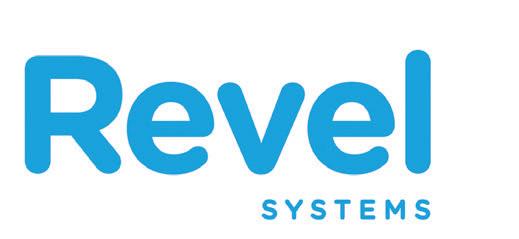
600 Peachtree St. NE, Floor 38 Atlanta, GA 30308
833-437-3835
revelsystems.com

Revel’s cloud-native point of sale ( POS ) and business management platform enables multi-channel transactions and enterprise scalability at the heart of our clients’ businesses. Our leading platform helps restaurants and retailers deliver a better customer experience, diversify revenue streams, and grow their businesses with ease.
Toast
401 Park Drive, Suite 801 Boston, MA 02215 857-301-6002
pos.toasttab.com/restaurant-pos/ quick-service-pos-system
Toast is a cloud-based, digital technology platform purpose-built for the restaurant community. Toast provides a single platform of software as a service—products and financial technology solutions that give restaurants everything needed to run their business across point of sale, operations, digital ordering and delivery, marketing and loyalty, and more.
Xenial
3420 Toringdon Way, Suite 400 Charlotte, NC 28277 704-295-7000

xenial.com



Xenial™ is a leading complete technology solutions platform for the quick-service restaurant (QSR) industry. With more than 35 years of experience, Xenial is a proud subsidiary of Global Payments—a Fortune 500 company—and is present in 62 countries, serving 51,000 locations including 20 of the top 50 QSR brands in the U.S.

SmartChain Key players
58 DECEMBER 2022 | SPONSORED SECTION
A Second Look at QR Codes
The early COVID headliner has plenty of life in a post-pandemic landscape.
Restaurants have many pressing issues to contend with to ensure their survival in the current post-pandemic world. Struggling with inflation, labor shortages, supply chain, and impending recession, some might argue that there isn’t any real incentive for restaurants to focus their attention on menu QR codes.
The implementation of QR codes solved a problem initially—to provide customers with a contactless way of reviewing what’s on the menu. With that “problem” solved, operators can focus on the real issues at hand, or so they may have thought. Static QR codes, while solving for “something” are generating additional problems for consumers who exhibit strong opinions either for or against them. For restaurants, they’re also a massive missed opportunity to effectively engage their audience, generate sales, and create loyalty.
QR codes can, and should be, used differently to enhance the customer experience for restaurant diners. With the right approach, the QR code menu can morph into an interactive ordering tool that enhances hospitality rather than hampers it, resulting in increased check averages and happier, more loyal customers.




A quick look at how these black-and-white squares are currently being used in different sectors of business shows us QR codes can enable consumers to directly connect to brands in a robust way. On the retail shelf for example, there is a strong trend toward using QR codes to offer promotions to shoppers. Pre-pandemic estimates aggregated by Juniper Research show more than 5 billion QR code coupons would be redeemed in 2022—a figure that has only grown as consumers (nearly 50 percent, as of last year) become more and more comfortable scanning marketing-related codes. Furthermore, QR codes are at the forefront of the $40 billion global connected packaging industry, with three quarters of shoppers willing to scan product packaging to gain more detailed information.
Sarah Ellenbogen is the CEO of Digiphy, a Techstars, M13, and LightShed Ventures backed startup that supports restaurants in amplifying the relevance and effectiveness of QR-based marketing. Digiphy is one company actively helping restaurants solve these problems in order to satisfy their customers, but also to help them capitalize on the full potential that dynamic content can provide for their business.
“In the restaurant setting, QR code PDF menus often fail to provide a multi-dimensional experience and seem to only showcase a utilitarian one-way PDF menu that is hard to absorb, difficult to navigate, and often leads to frustration and aggravation for the customer, the opposite of a positive hospitality experience,” Ellenbogen says. During COVID, the PDF menu was a functional solution for providing contactless menus. But many, if not most, restaurants have done away with paper menus altogether, defaulting to the QR code despite the fact this practice often leads to an underwhelming and often maddening user experience for their guests. The main frustration is this: PDFs are not optimized for mobile viewing, forcing users to pinch, zoom, and scroll their way through the document in order to comfortably read it.
This is bad for the customer, but also really bad for the restaurant as early data has shown that QR code PDF menus lead to lower check averages and less order volume due to the unnecessary friction it creates. For diners over the age of 40, few things can frustrate you faster than having to hold your phone at arm’s length because you can’t read the small print.
DEPARTMENT INNOVATION
ADOBE STOCK BUFFALOBOY
B Y L I Z M O S KOW CONTINUED ON PAGE 62
www.qsrmagazine.com | QSR | DECEMBER 2022 59
Although its applications might be changing, the QR code remains a viable option for operators.
Don’t Ghost Food Safety



foodservice establishments must ( and are regulated by local and state health departments) The CDC currently does not track and report foodborne disease outbreaks caused by ghost kitchen foodservice. However, because of the rapid growth of this business, there is a strong probability it will contribute to the burden of foodborne diseases. In the absence of any CDC or state reports, there is considerable social media chatter about illness and food quality issues specific to delivery from ghost kitchen brands. Thus, now is the time for all operators in the space to ensure food safety, including those that license their brand and menu items.
So what are some food safety risks unique to ghost kitchens and the best practices to reduce them? We’ll focus on kitchen design and location.


The pandemic devastated the industry, and the new digital transformation of the food sector has changed the business for years to come. One of the models that has grown significantly is the ghost kitchen; accelerated by the continued expansion of off-premises sales. Digital ordering and deliveries in the U.S. have grown 300 percent faster than dine-in sales since 2014. These delivery-only venues may also include mobile kitchens designed for pickup only (food trucks or trailers where food preparation occurs and delivery service pickup is completed ). It’s a model expected to grow domestically from $43.1 billion in 2019 to $71.4 billion by 2027.
Foodservice establishments continue to cause the greatest number of foodborne diseases outbreaks every year in the U.S. Before COVID-19, as reported by the CDC in 2017, 60 percent of all cases. Today, when you look at the most currently available data, nothing has changed. There were 184 outbreaks ( or 61 percent of the total), 3,074 illnesses, 337 hospitalizations, and three deaths in one year.
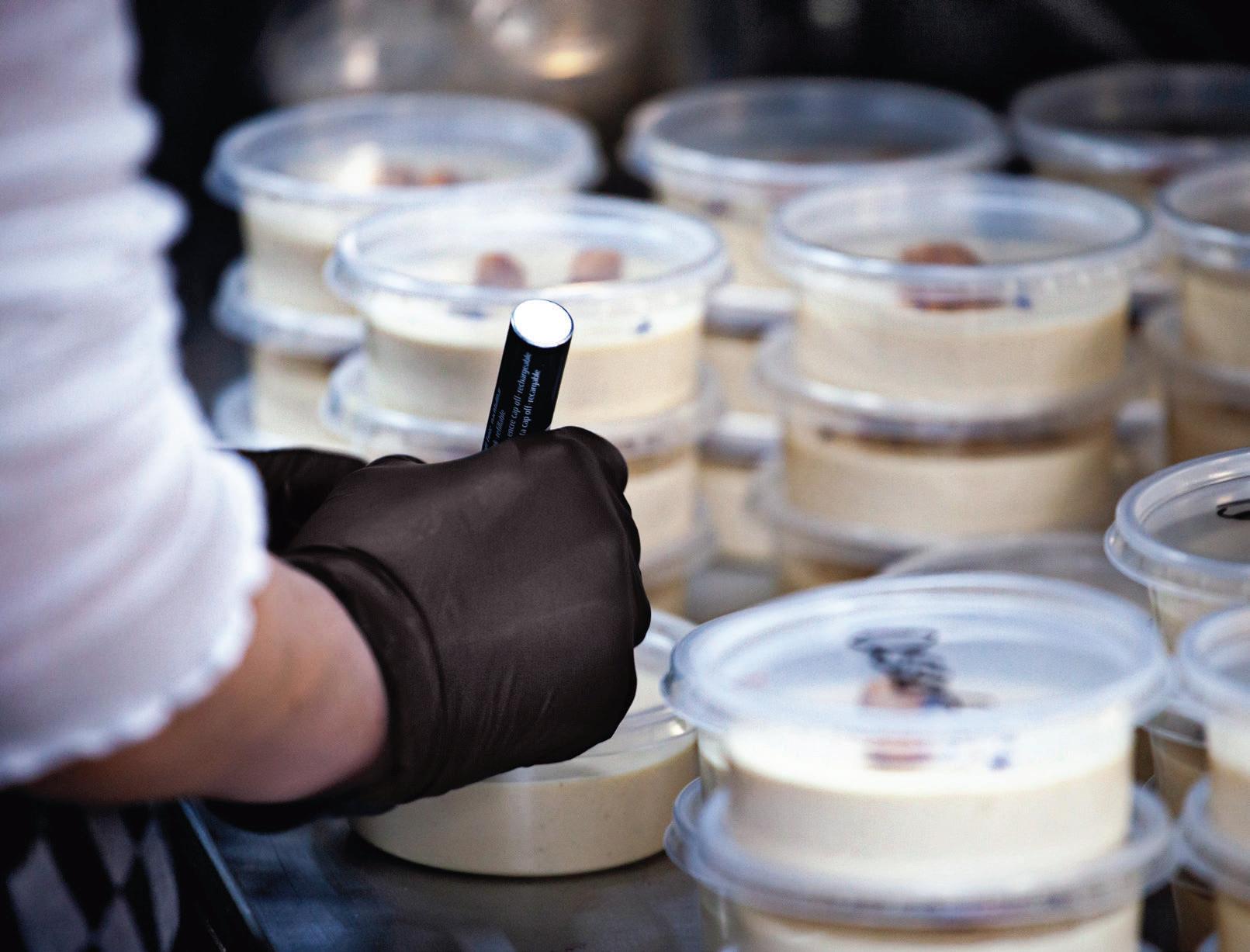
Ghost venues operate like any other foodservice kitchen, preparing and serving foods for immediate consumption based on orders, and they follow the same state version of the FDA food code all
The FDA food code is used to regulate ghost kitchen establishments, permitting, plan review, and health inspections. It does not specifically address ghost kitchen operations, but does outline food safety requirements of mobile foodservice establishments based on a menu prepared and served in mobile and fixed food trailers as extensions of brick-and-mortar establishments. These include requirements for personal hygiene, food preparation, temperature/equipment requirements, safe potable water and sewage use, physical facility design for food safety, chemical safety, servicing, and enforcement of compliance. In turn, if a ghost kitchen business location with or without a mobile foodservice component follows these rules, the risk of causing a foodborne disease outbreak would be very low. Nevertheless, because of the digital transformation of the industry, and its current model for location selection, setup, and operations, there are some inherent risks associated with ghost kitchen operations that should be considered.
Traditional permitting of a restaurant for food preparation and sales to the public are based on the menu items prepared in the facility and the design ( called safe flow of foods ) to ensure food safety. Likewise, the inspections of the operations to ensure the public health, and to ensure compliance to food code, are also based on the menu and facility design. If menu items and preparation methods change, there can be new food safety risk introduced into the kitchen beyond what the kitchen was designed to produce. This is augmented if the volume of sales is too large to
ADOBE STOCK JESSE
B Y H A L K I N G DEPARTMENT OUTSIDE INSIGHTS CONTINUED ON PAGE 63
Virtual kitchens can’t take a backseat to industry-wide best practices.
60 DECEMBER2022 | QSR | www.qsrmagazine.com
Ghost kitchens can be a bit of a wild west for food safety. Don’t let that be the case.
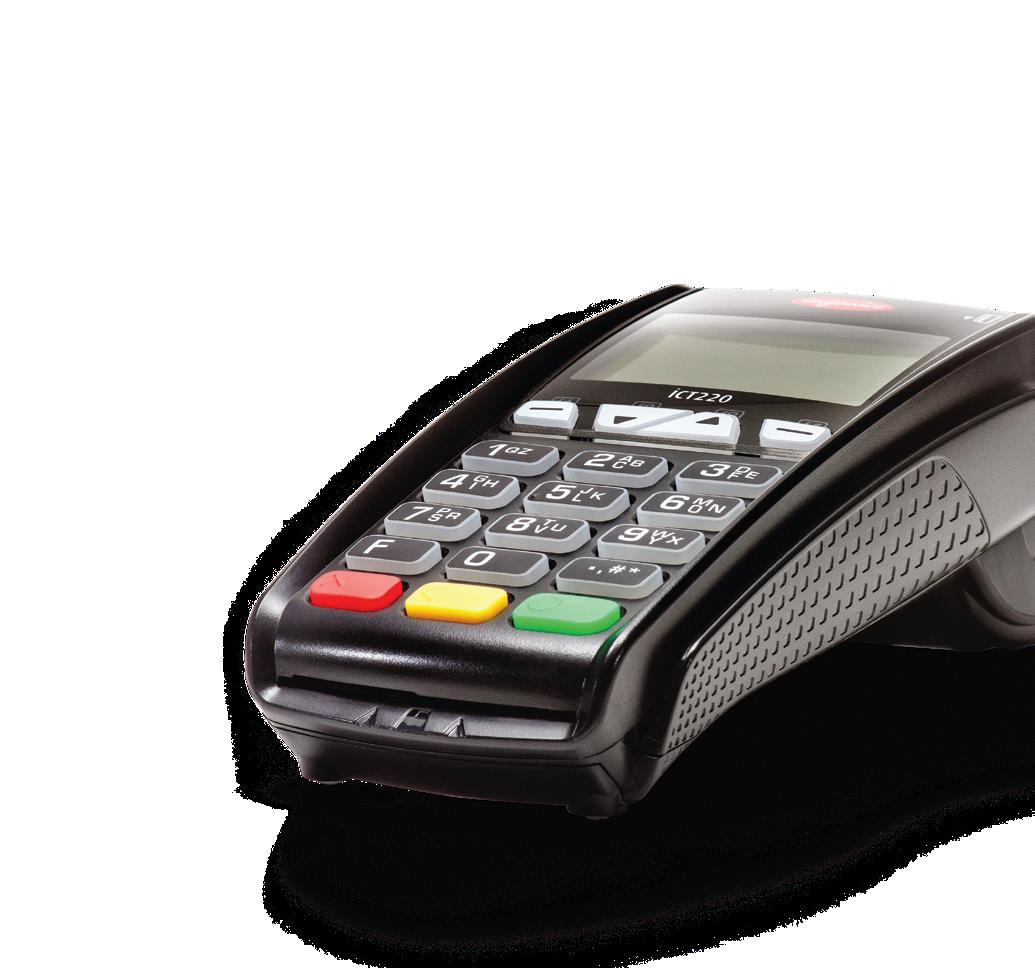

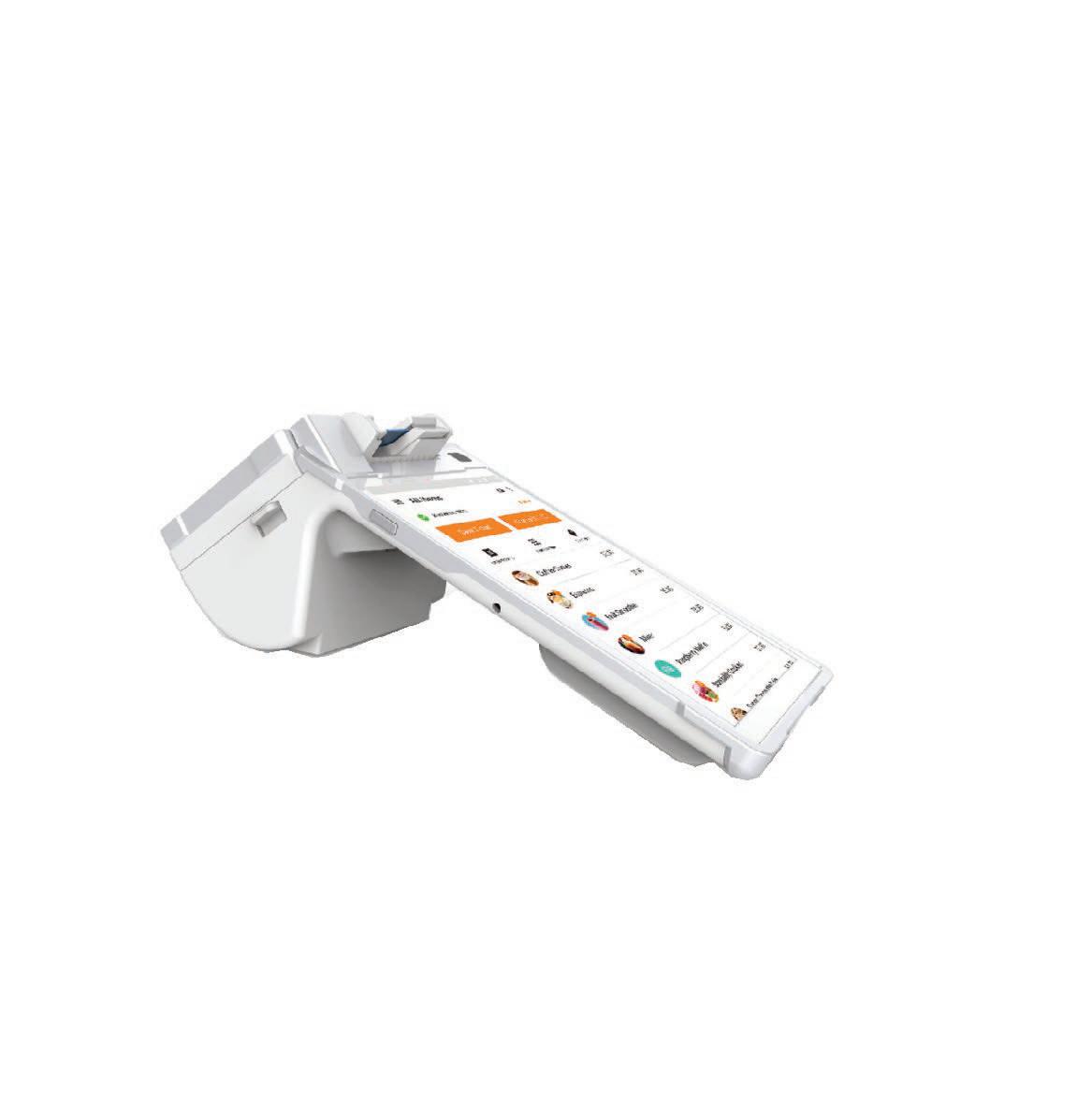

• FREE NFC & EMV-Ready Terminal & Pin Pad or wireless terminal. • Accept payments in-store, online, or on-the-go. OPTIONAL PROGRAMS: EDGE: The Best CASH DISCOUNT PROGRAM from North American Bancard Are you ready to get rid of the impact of payment processing costs on your business? With the Edge Cash Discount program you will enjoy the same profit margins from cash payments as you do from non-cash payments. • Point of Sale Systems Recommendations, Solutions & Integrations • Accept EBT/Snap Low Transaction Fee Accept EMV/NFC (Apple Pay, ETC.) EBT, Snap, Checks and more Next Day Funding with weekend settlement Rates as low as .05%* REDUCE YOUR CREDIT CARD PROCESSING FEES FREE Credit Card Terminal Placement Wireless/Landline/High-Speed/Dial-Up Easy setup (with no setup fees and quick approvals) Seamless integration with your current POS $295** towards your early termination fee (if you have one) with your current processor Access to Payments Hub - our secure, online merchant portal Free paper** GROW YOUR BUSINESS. PARTNER WITH NAB TODAY! 866.481.4604 © 2022 North American Bancard, LLC (NAB). All rights reserved. NAB is a registered ISO of BMO Harris Bank N.A., Chicago, IL, Citizens Bank N.A., Providence, RI, The Bancorp Bank, Philadelphia, PA, and First Fresno Bank, Fresno CA. American Express may require separate approval. *Durbin regulated Check Card percentage rate. A per transaction fee will also apply. **Some restrictions apply. This advertisement is sponsored by an ISO of North American Bancard. Apple Pay is a trademark of Apple. WWW.NYNAB.COM INTEGRATE WITH YOUR POS
“The reviews were fabulous for what we were doing. People loved it,” Rosenfeld says. “Just exactly what I said—so many people say it’s the best pizza they’ve ever had. Well, that’s what we’re trying to do. Our reaction is, we want to introduce a new product to people. Most people in America have not seen this product, which is amazing. For me, it’s amazing because I started CPK 37 years ago, and it’s hard to imagine that there is a great product like this roman-style pizza that I’m describing that most of America has not seen.”
Now the brand is gearing up to open its first two brick-and-mortar stores, which will both be grab-and-go restaurants in Los Angeles. One will debut at Palisades Village at the end of 2022—a venue that attracts a younger crowd and a place Rosenfeld calls “one of the Instagram capitals of the world.” The location, developed in partnership with billionaire real estate mogul Rick Caruso, features outdoor dining and a delivery window. Then in early 2023, ROCA will enter Marina Del Rey, an area that houses a 30-year-old CPK store that produces one of the highest volumes in the system. Each store will have display cabinets to showcase full pan pizzas and a section of pre-packaged salads and sandwiches made from pizza dough. “What’s really beautiful about this is that this is going to be very clean, light-colored stone,” Rosenfeld says. “So basically, these are beautiful little bakeries, and we didn’t have the chance to do that in that way at the pop-up. You walk in, there’s pans lined up of all these colors. That’s what I think will really be attractive to people. They’re little jewelry boxes. Just the rainbow of flavors is not something that a U.S. customer is really accustomed to.”
The two shopping centers are small, but welcome dense traffic and high-income customers. Rosenfeld believes they’re the perfect spots to build awareness, and that the next step would be nontraditional like ghost kitchens, airports, and stadiums. Rosenfeld also thinks ROCA is capable of going global via franchising, something he did little of while at CPK. When he sold, there were 212 company-owned units. q Ben Coley is a senior editor at QSR. He can be reached at bcoley@ wtwhmedia.com
this feedback is for restaurant businesses.
Establish guidelines, FAQs and the appropriate brand voice for your replies. You train your staff on how to greet and interact with guests in person, so as you build your brand, make sure you’re employing those same tactics with online guest responses.
Reply to all or nearly all your reviews on top sites. Don’t just reply to negative reviews. Guests who praise your brand may think you are not listening, and others will not post their positive comments.
You also miss a wonderful opportunity to turn a positive guest into a loyal guest. Additionally, don’t try to take all your criticisms offline with, “We are sorry. Please contact us at this email,” as it does not show how you address issues.
Sometimes apologizing and/or explaining issues publicly earns you more points with guests and prospects.
Be authentic. Don’t “dumb-bot” your guests with canned replies. They can tell and so can review platforms, and there are consequences.
Quid pro quo. Use short replies for short reviews and longer replies for longer reviews. Try to address the key themes mentioned in the review in your reply to show you are paying attention.
Have a system and policies in place to address issues. For example, flag negative reviews for removal if they violate site content guidelines—removing a single one-star review is like adding four 5-star reviews.
Escalate critical issues internally, including disgruntled employees, upset guests with an axe and social media following to grind, legal threats (food poisoning claims, slip and fall, etc.) or bad actors threatening extortion. Establishing crisis management protocols and acting proactively can help combat the effects of negative, viral media.
Remember that that CEO mentioned earlier? He prioritized guest engagement for his brand by increasing their reply rate from sub-20 to over 90 percent in a few short years. During that time, they saw dramatic unit growth and sold their brand for a remarkable valuation. Don’t miss your opportunity to make your mark. q
The risk of alienating some of your highest spending consumers is too great to overlook. In fact, in 2021 Syntegon indicated nearly 80 percent of consumers shared a willingness to scan a QR code if the experience is easy for them. Contactless is no longer required; it’s time for diners to engage in a better way. It’s time for restaurants to offer a dynamic ordering experience. By design, PDFs are static, and static content is the enemy of engagement. Once a customer tries to find and then perhaps gets the information they need, there is nothing else for them to do. There is no action or incentive to stay on the page and no opportunity to build a relationship with the menu, the food, or the brand.
If PDFs are flat and lifeless, then what are the alternatives? The obvious answer may be to direct consumers to a website or ordering platform, but that creates the opposite problem: too much choice. A website generally functions as a type of catch-all for brands. For customers coming from a QR code, this means that there is no clearly defined action to take. If the user must navigate the site on their own to find what they need (or has to intuit what you want them to do), they are unlikely to stay long and are even less likely to order more than what was first shown to them. Landing pages work better and can feature a single call-to-action that is designed to convert customers to buy, join, give feedback, claim an offer, or complete some other action. A QR code that sends users to a dedicated page with relevant content and a clearly defined action is the key to a positive and engaging experience.
Ultimately, what separates a good QR experience from an exceptional one, is context. While landing pages are a strong option for a QR-to-web strategy, their ability to suit a specific occasion or drive a certain action means little if they don’t fit the right moment in the consumer journey, especially at mealtime. The answer: create a dedicated experience for each information, ordering and payment touchpoint so that consumers always get the most relevant content possible. q
ONES TO WATCH / CONTINUED FROM PAGE 16
59
INNOVATION / CONTINUED FROM PAGE
Liz Moskow is an F&B industry expert with a Culinary Institute of America pedigree and over two decades of brand, culinary, hospitality and CPG experience. She is based in Denver and is Principal of Bread & Circus Ltd, a consultancy focused on the future of food.
OPERATIONS / CONTINUED FROM PAGE 18
Adam Leff is the cofounder and chief strategy officer for Merchant Centric, a leading reputation management solution that caters to the restaurant, veterinary and automotive industries. Leff and his cofounder David Bay started Merchant Centric in 2010 to help companies of all sizes take advantage of online and social media technologies to market and build their business.
62 DECEMBER 2022 | QSR | www.qsrmagazine.com
OUTSIDE INSIGHTS / CONTINUED FROM PAGE 60
be accommodated by the labor and kitchen space/equipment use design; a likely risk from the large number of virtual customers that can order from any one kitchen.
Because of the access to a large swath of customers via digital, some ghost kitchen businesses have evolved out of social media celebrities or directly by social media businesses due to the large volume of potential customers. The business model is the same as a ghost kitchen where a social media company partners with a kitchen design and location operation.
However, some social media celebrities (with access to their millions of followers) also offer their menus to existing restaurants for the opportunity to prepare and sell the food from their current kitchens. Because of the faster launch, a new restaurant concept can take using a ghost kitchen partner (say, 21 days versus 6–8 months), and almost an immediate access to customers ordering food via digital marketing, many of the ghost kitchens are not properly vetted by a regulatory authority that would normally perform a plan review of the facility and the menu until after they are in operation and serving food. Some ghost kitchen facilities may also not be constructed properly according to best practices to prevent cross contamination/cross contact.
Best practices
Choose venues that support kitchen design with proper potable hot water for cleaning and sanitation. Design kitchens according to the menu items being prepared including separation of raw proteins and allergens from ready-to-eat food preparation. Ensure a plan review of the kitchen design and menus being prepared by the local regulatory authorities that include the proper number of hand wash sinks (including assurance of hot water capacity needed if in mobile establishments) and equipment use that will reduce the risk of cross contamination and cross contact of allergens. Ensure customers have access to local health inspection scores/grades to build confidence in the safety of the location. Ghost kitchens, as novel and booming a trend as they are, still live by the age-old best practices that define our industry. q
AD INDEX
Accurate Box ........................................29 973-345-2000 | accuratebox.com
Clark Foodservice ..................................3 717-392-7340 | clarknationalaccounts.com
Ecolab ....................................Back Cover 800-529-5458 | ecolab.com
FatzFoodz ..............................................6 202-840-8958 | fatzfoodzrunners.com
Ghirardelli ............................Inside Front 800-877-9338 | ghirardelli.com
Intellihot .............................................13 877-835-1705 | intellihot.com




Jersey Mike’s .......................................25 732-292-8272 | jerseymikes.com/franchise
Mr. Pickle’s Sandwich Shop .............14, 15 mrpickles.com/franchising
For more information on these companies, visit www.QSRmagazine.com/connect/
NAFEM Show ........................................10 thenafemshow.org/register
National Sign Systems ............Inside Back 800-544-6726 | nationalsignsystems.com
NorthAmerican Bancard .......................61 866-481-4604 | MYNAB.com
Red Gold ...............................................17 866-729-7187
redgoldfoodservice.com/sample-requests
RF Technologies ...........................5, 9, 63 800-598-2370 | rfdrivethru.com


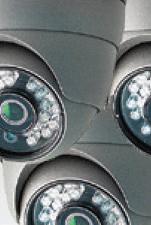

















SEB Professionals ................................23 wmf-coffeemachines.com | schaererusa.com Wilburcurtis.com

ShiftPixy ..............................................33 888-798-9100 | shiftpixy.com
Tork .....................................................19 866-722-8675 | torkusa.com/xpressnap
Vito Fryfilter ........................................37 847-859-0398 | vitofryfilter.com
SMART CHAIN ...............................................40-58

HungerRush .......................................53 pos.hungerrush.com/orderai
Lightspeed .........................................47 888-780-9644 | lightspeedhq.com

OneDine .............................................43 888-551-3463 | onedine.com


Panasonic Commercial Foodservice ....45 877-726-2767 opt. 2 napanasonic.com/us/ClearConnect
Posiflex .............................................41 888-968-1668 | posiflexusa.com

Presto ................................................49 presto.com/voice
Revel System ......................................51 833-437-3835 | revelsystems.com/enterprise
Xenial ................................................55 800-253-8664
Xenial.com/products/pos-software
 Hal King, Ph.D. is the managing partner of Active Food Safety, an advisory services company whose partners developed the free EmergiProtect mobile app for the restaurant industry.
Hal King, Ph.D. is the managing partner of Active Food Safety, an advisory services company whose partners developed the free EmergiProtect mobile app for the restaurant industry.
www.qsrmagazine.com
QSR | DECEMBER 2022 63
|
Jeff Chandler
CEO/president
HIBAR HOSPITALITY GROUP
What was your very first job? Aside from gum-scraping duty at my dad’s restaurant while growing up, my first paid job was pumping gasoline at a boat marina in the Pacific Northwest.
What’s your favorite menu item at Hopdoddy?
That’s a tough one. While the Hopdoddy menu offers a ton of great options, lots of different proteins and really innovative burger builds, I have to say our Classic Cheeseburger is my favorite. I’m a pretty straightforward guy, and I love how we highlight the art of simplicity with high-quality ingredients.
What’s your favorite cuisine aside from Hopdoddy? Even before moving to Texas, Mexican food has always been one of my favorite cuisines, and living in Austin, even more so. I could eat it every day.
What’s the best piece of advice that other restaurant executives should hear? Be openminded to change but stay fanatically protective of your brand and what it means. And don’t forget this is a people-focused business. If you succeed in the people business, you’ll succeed in the restaurant business.
What are some of your interests outside of work?
I like to spend time outdoors and going fast. Whether it’s on a boat, going on a leisurely drive or flying through the air, I love the adrenaline rush. Being with my family and friends is also incredibly important to me.
The restaurant industry is in my blood. My dad had an English pub called the Ram Pub where guests would cook their own burgers at the table. From a very young age, I started working there doing odd jobs like scraping gum off restaurant tables and cleaning beer draft lines.
I learned so much from my dad and being in a restaurant during those formative years and it’s really a full circle moment that 30-plus years later I’m back in the burger business with Hopdoddy.
Since joining the Hopdoddy team in 2016, I’ve focused on building a best-in-class leadership team, maintaining our position as a pioneer in the better burger space and driving menu innovation through our Burger of the Month program, all while achieving category-leading financial results. Today, we have 35-plus locations throughout Texas, Tennessee, Colorado, Arizona, and California, with plans to open in Georgia, Florida, and Louisiana by the end of 2022.
The future for Hopdoddy looks tremendous.
Most recently, I was named CEO of HiBar Hospitality, a growth-focused umbrella company owned by L Catterton.
Through HiBar, we completed our first acquisition of Grub Burger Bar—a strategic move based on the synergies of both concepts.
We’re converting almost all the Grub locations to Hopdoddy restaurants, and that will get our restaurant count to more than 50 and bring us into some new markets and states. I’m continuously looking for additional growth opportunities through mergers, acquisitions and new restaurant openings.
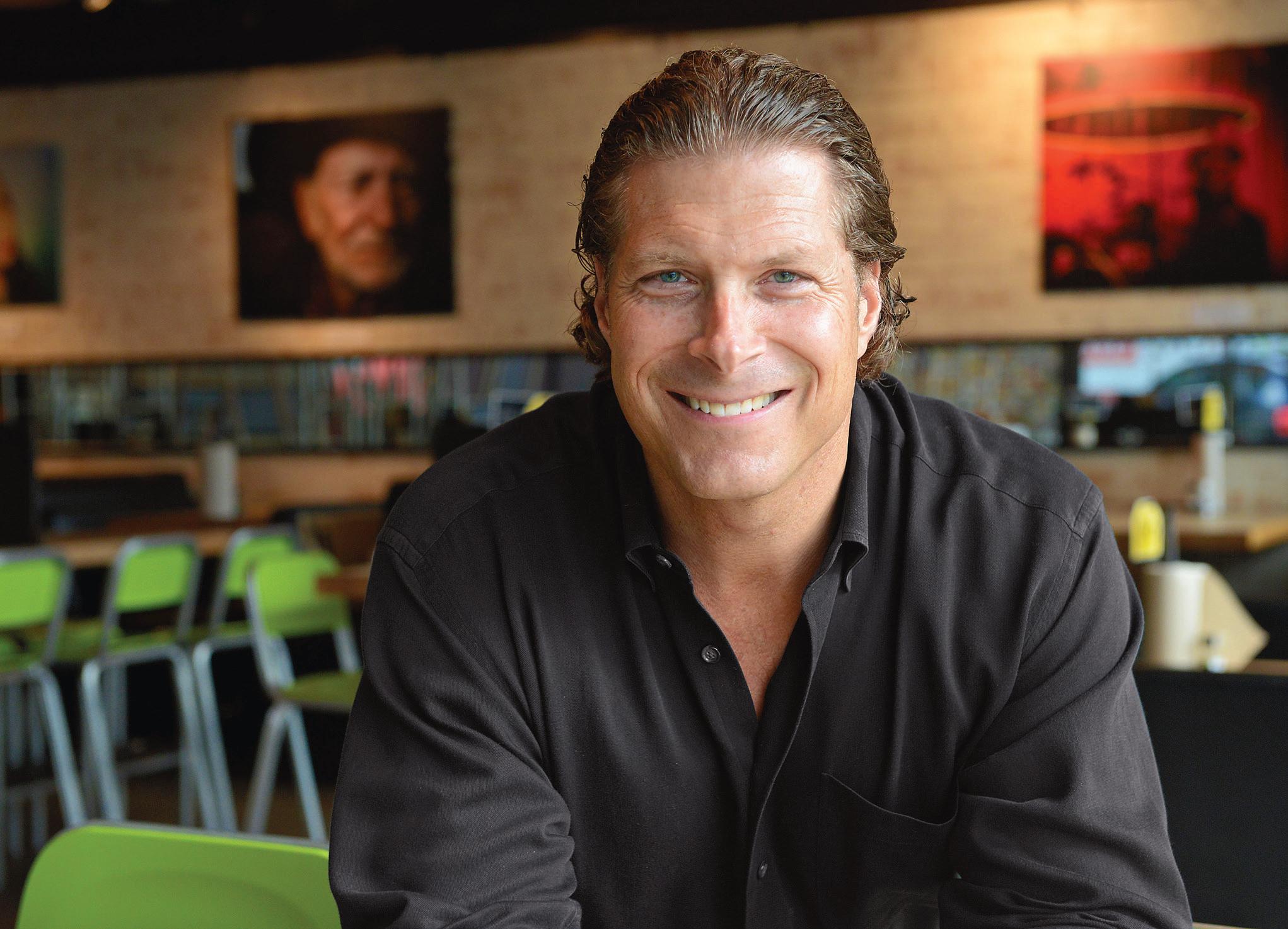
While there are lots of great leaders in our industry and others who I admire and look to for guidance, my father is my biggest inspiration.
He’s a great restaurateur, entrepreneur, and the definition of a human-centric leader. My father has been a true inspiration and mentor to me, and I continue to take those lessons with me each day as I lead our company into the future. q
BACK PAGE START TO FINISH HIBAR HOSPITALITY GROUP 64 DECEMBER 2022 | QSR | www.qsrmagazine.com









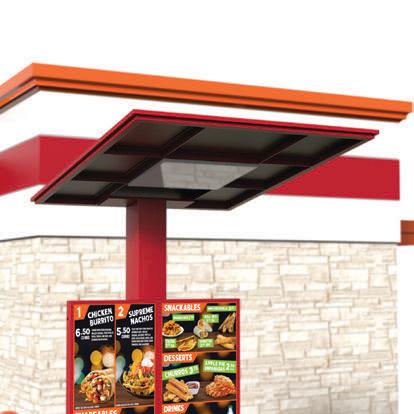


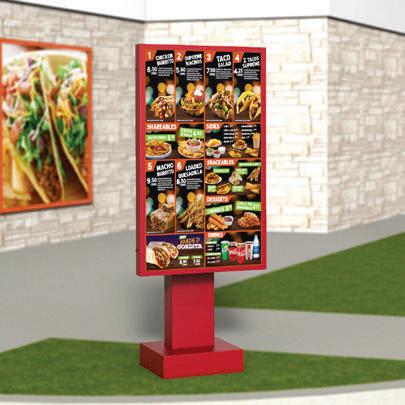




















Ecolab USA Inc. All rights reserved. (Scan the code for more information about each machine) Low-temp dishmachine High-temp dishmachine Saves water, energy and labor. Faster, easier close down. Open with fewer employees. More time with customers. Contact your Ecolab Representative or call 800.529.5458 TODAY! KAY® Machine Warewash is ready to Join your Team.









































 Danny Klein, Editorial Director
Danny Klein, Editorial Director

























































































































































































 / BY DANNY KLEIN
/ BY DANNY KLEIN

















 Danny Klein is the Editorial Director of QSR magazine. He can be reached at dklein@wtwhmedia.com
Danny Klein is the Editorial Director of QSR magazine. He can be reached at dklein@wtwhmedia.com




























































































































































































 Hal King, Ph.D. is the managing partner of Active Food Safety, an advisory services company whose partners developed the free EmergiProtect mobile app for the restaurant industry.
Hal King, Ph.D. is the managing partner of Active Food Safety, an advisory services company whose partners developed the free EmergiProtect mobile app for the restaurant industry.
































